2-Week Brazil Itinerary: Perfect for First-Time Visitors
Brazil was my 65 th country and somewhere I was incredibly excited about. At the same time, despite all my travel experience, I found planning my trip to Brazil daunting. I received countless warnings about safety and the country itself is massive which made it hard to plan when I had a limited amount of time. In the end, I joined a group trip to explore Brazil and while I was grateful for the friends I made, I now know that I easily could have done it myself safely and for (a lot) less money. So, for anyone trying to figure out a 2-week Brazil itinerary and wondering if you can do it on your own, the answer is yes. Here’s how to best spend 2 weeks in Brazil if you are a first-time visitor.

Getting to Brazil

Getting to Brazil is pretty easy by air and overland if you are coming from a neighbouring country. If you are flying directly into Brazil chances are you will route through Sao Paulo Airport. It’s the largest and the most popular among international airlines. For my suggested itinerary, however, I suggest you start in the South of Brazil to see Iguazu falls. It might seem a little bit out of the way but trust me, it’s worth it. So, book a connecting flight to Foz do Iguaçu/Cataratas International airport.
If you are crossing into Brazil from neighbouring Argentina you can also fly directly into Foz de Iguaçu/Cataratas airport. This is the easiest option if you are coming from Buenos Aires . However, you can also easily cross the border by land.
Getting Around Brazil
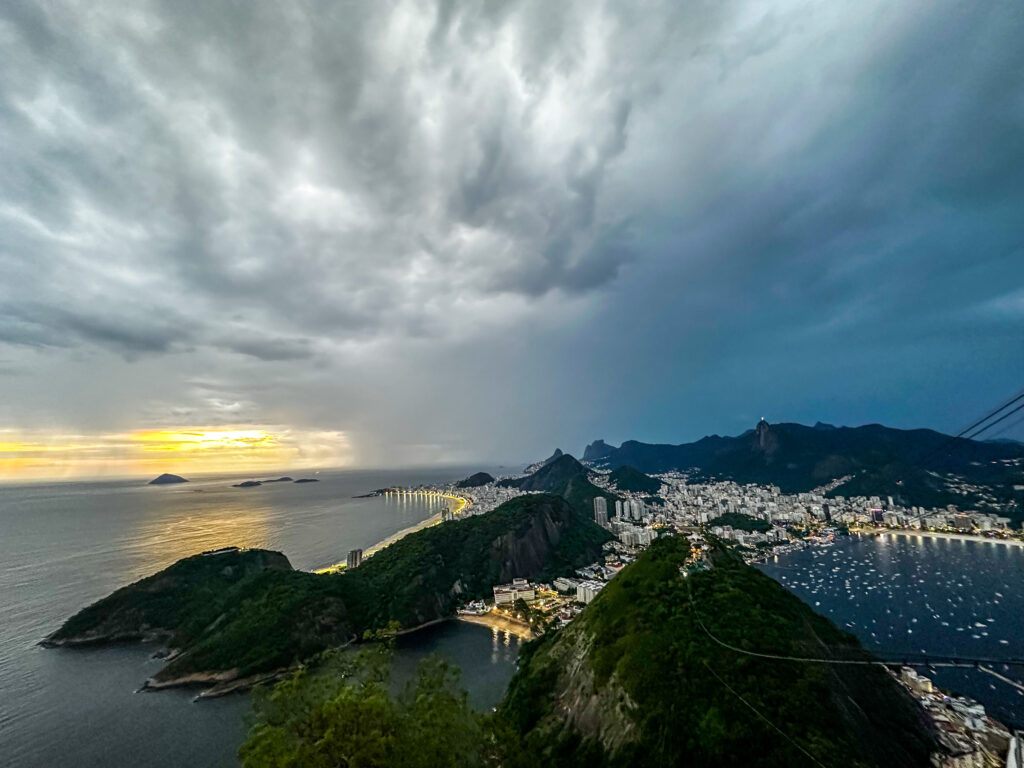
Brazil is enormous and unless you are renting a car (which I do not recommend for this 2-week Brazil itinerary) you will rely on a mix of public transportation, Ubers, boats and your feet!
Buses, shuttles, and flights are the easiest way to get from city to city. When in smaller towns you can easily walk around. When in larger cities, such as Rio de Janeiro, you can use the public transportation system or Uber. I found Uber to be very affordable, easy, and safe as a solo female traveller in Rio. You can connect the app to your credit card, no need for cash.
Two Weeks in Brazil Itinerary: My Suggestions for First-Time Visitors
As I said earlier Brazil is a huge country and there is tons to see and do. My itinerary will take you from the Southern border and end in Rio de Janeiro since this is the part of the country I explored. That being said, if you have more time, then consider heading north which is meant to have some of the most beautiful spots in the country when it comes to nature and beaches. Don’t forget that Brazil also holds nearly 60% of the Amazon rainforest, so if that’s on your bucket list, then consider adding it into your itinerary.
With that in mind, here is my suggested 2-week Brazil itinerary which is perfect for first-timers looking to explore some of the major highlights of the country.
2 Days in Iguazu Falls

Iguassu Falls is located in Southern Brazil on the border of Argentina. With 275 waterfalls, this incredible area is of the natural wonders of the world and a world UNESCO heritage site. I recommend spending your first 2 days here so you can see them from both the Brazilian side and the Argentinian side. Although I suggest staying in Brazil itself to make things a little easier.
For recommendations on where to stay near Iguazu Falls, I suggest the following:
Hostel: Concept design hostel and suites or Hostel Wanderlust
Midrange: Viale Iguassu or Foz Plaza Hotel
Luxury: Hotel Das Cataratas which is right by the falls themselves.
Your first day, when you are probably a bit tired from travel and jetlagged, should be spent on the Brazilian side. Brazil has the best view of all the falls since you look across to the Argentinian side. You only really need a couple of hours here to walk the trail and take your photos. Keep an eye out for the local wildlife as well which includes everything from multi-coloured butterflies to jaguars if you are incredibly lucky. From the Brazilian side, you can also take a helicopter ride to see the falls from above. This tour will pick you up from your hotel and take you to explore Iguazu falls from the Brazilian side.
On day two, head over to the Argentinian side for the day. This will be a full day as there are multiple walking trails and a boat excursion that I highly recommend. Only two of the three walking trails were open during my visit. The upper one, we were told, was much more beautiful than the bottom trail so that’s what I did and wow was it stunning. It’s amazing seeing all the waterfalls from a distance when you are on the Brazil side, but the Argentinian side really allows you to get up and close and see just how big and powerful they are.
There is then the option to take a boat ride to see the falls from the water. In my opinion, this was the most fun so I highly recommend it. Just note it’s a long downhill trail through the jungle to the boats and you will get soaking wet (so wear a bathing suit and bring a change of clothes!). This tour will pick you up and take you across to explore Iguazu falls from the Argentinian side.
Travel to Paraty

I apologize in advance but Day 3 is going to be a long travel day. I promise you, however, that it is worth it!
The next stop on my suggested 2-week Brazil itinerary is Paraty, which means you’ll need to take a domestic flight and a bus ride.
Start by flying to Sao Paulo’s Guarulhos airport. It’s a 1.5 hour flight and should only cost you about $85CAD if you book in advance. From Sao Paulo Airport you will need to get a bus or shuttle to Paraty which will take 5-7 hours depending on traffic. Trust me, there will be traffic.
You can take public transit which will be the cheapest method but also the longest. Using the local buses will require 2-3 transfers.
The other option is to take a shuttle. They have 2 pick-ups per day from the airport and will take you to Paraty direct. It is more expensive (about $90 CAD one way). However, it is comfortable, with room for your luggage in the back, and air conditioning. They also include a rest stop. The shuttle company we used was Paraty tours and it was fantastic. You can find them here.
I suggest staying in Paraty for 3 nights. The old town is beautiful but the streets are pedestrian only and will be incredibly difficult to wheel a suitcase down. If you travel with a suitcase, pick a hotel just outside the old town centre. If you are backpacking, you can stay in the old town if you like.
Suggestions for accommodation in Paraty:
Hostels: Che Lagarato Paraty
Midrange: Pousada recanto do Jabaquara or Pousada Antigona
Luxury: Pousada do Ouro or Sandi Hotel
2 Days in Paraty
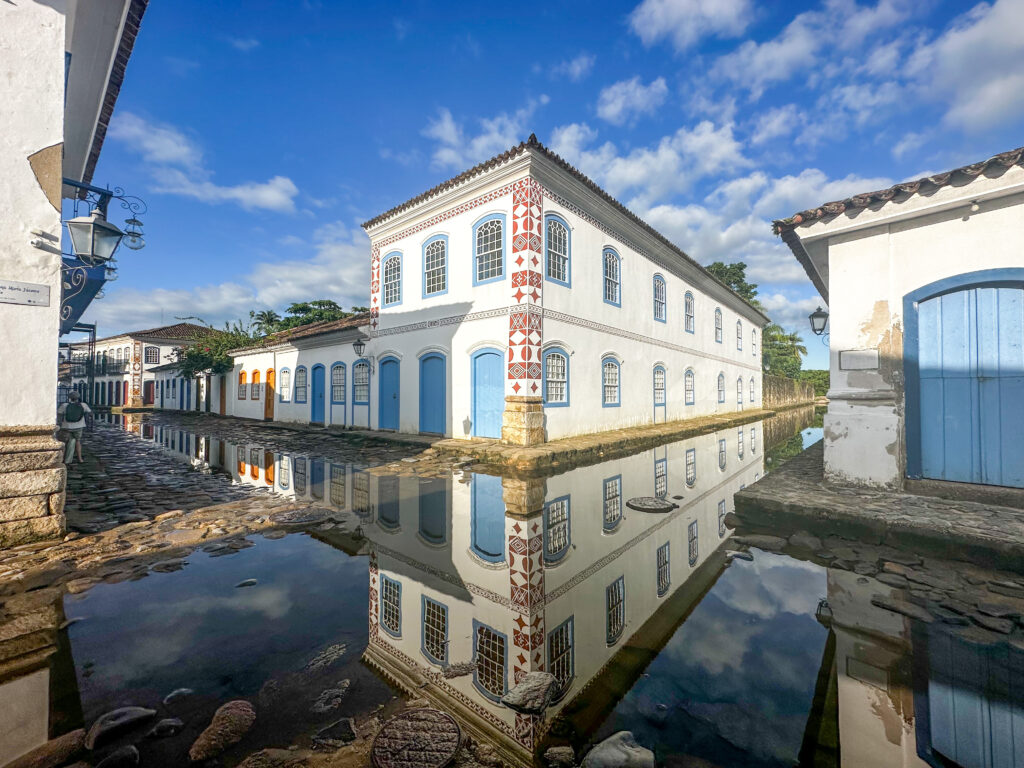
Days 4 and 5 of my 2-week Brazilian itinerary are for Paraty. Paraty is a colonial Portuguese town located along the coast against a backdrop of jungle and mountains. It is gorgeous! Not just the picturesque old town but the location and the scenery. You’ll want to spend at least two full days here, one exploring the town and area and the second on the water.
Paraty old town is quite compact which is ideal because it’s accessible by foot only. No cars allowed! This will make sense once you see the streets; cobblestones of all shapes and sizes and nowhere is flat. So, make sure you wear good shoes; these streets are potential ankle-breakers!
Paraty is a UNESCO World Heritage site and is famous for its beautiful buildings and the local cachaça, which is the liquor used to make caipirinhas. There is a special type of caipirinha here in Paraty called the Jorge Amado which uses a cachaça infused with cloves and cinnamon and passionfruit. It was by far my favourite drink in Brazil. If you plan on buying any cachaça while in Brazil, Paraty is the place to do it. There are a number of shops in the old town where you can try different types or you can take a local distillery tour. Try this half-day jungle waterfall and cachaça distillery tour.

For your second day in Paraty, take a boat trip around the bay. The trip I took included 4 snorkel stops. You could also order all types of food anddrinks on board. It was a really fun day that allowed us to see some of the beautiful islands and beaches in the area. The water here is also a beautiful blue/green colour and really clear. You can book your boat trip here.
In the evening, wander around the old town and have a drink somewhere with music. There are lots of great restaurant options here.
One thing to note about Paraty is that if it rains, the streets really flood here. I walked through water well above my ankles when I got caught in a rainstorm the first night!
Travel to Ilha Grande
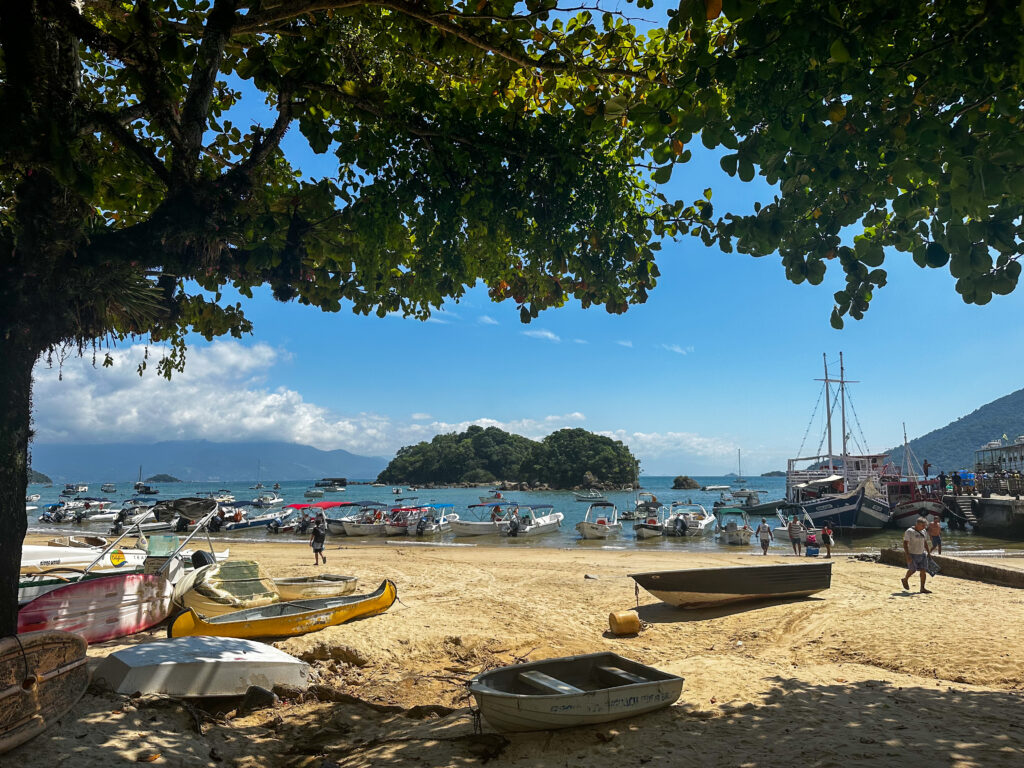
Day 6 is another travel day but don’t worry, it’s not a long one! You will, however, be taking a combination of a bus or shuttle and then a boat.
The first part of your journey is to travel from Paraty to Angra Dos Reis. There is the local bus or, again, you can book a shuttle which is what I took. The journey is a little under two hours. Try to grab a window seat on the right side of the bus for the best coastal views.
Once you arrive at Angra Dos Reis you’ll head to the pier where you will catch a ferry across to Ilha Grande. Now, these ferries aren’t quite what you probably have in mind. They are large speed boats and you get a plastic seat while the luggage is all lined up in the middle. It’s the local mode of transportation, nothing super fancy. Our journey wasn’t rough at all but if you do get seasick, take some meds just in case!
The ferry will take you to the main village in Ilha Grande which is Vila do Abraão. This is where you will spend the next 4 nights. For accommodation recommendations consider:
Hostel: Mahalo Hostel or Biergarten Hostel
Midrange: Pousada Recanto da Ana Alice or Pousada Porto Girassol
Luxury: Pousada Portal do Sol
Two important things to note about Ilha Grande. The first is that there are no vehicles. You walk and get around by boats. The second is that cash is king but there are no ATMs (at least not as of March 2024) on Ilha Grande. So, make sure to get cash beforehand because not everywhere takes credit cards.
3 Days in Ilha Grande

Ilha Grande was my favourite part of Brazil. It’s a beautiful island full of incredible beaches, a national park, hiking trails, and is a great place for scuba diving. If you are a beach/water person like me, you are going to love it here.
I suggest spending 3 full days on the island. Even if you choose not to be super active it’s a good place to relax before heading to busy Rio do Janeiro. Here’s how I suggest spending 3 days on Ilha Grande.
One day should be a beach day, specifically, Lopes Mendes beach. This beach is considered to be one of the best beaches in Brazil and one of the most beautiful in the world. I absolutely agree-it is stunning. However, it’s a bit of a trek to get there. You will need to take a boat from Vila do Abraão about 20 minutes to another beach. Here, you will follow the signs through the jungle trail to Lopes Mendes beach itself. The walk takes about 30 minutes but it is a proper up-and-downhill hike over rough and uneven terrain. I didn’t trust my flipflops so actually did it barefoot. It wasn’t too bad (made even better by the baby monkeys I saw) but it is definitely a bit of an adventure. However, it’s 100% worth it when you get to the beach on the other side. Huge expanses of soft, white sand. Bright blue waves, palm trees, jungle, and rocks. Lopes Mendes beach is gorgeous. What you do need to keep in mind is that it is a natural beach. There are no shops, toilets, etc. So, bring everything you need for your time there including plenty of drinking water. Personally, I could have spent the entire day here but I’m also a big beach person. I’d suggest at least half a day since your journey also includes the boat ride and hike.
For your second day, book a boat tour. Ilha Grande has half and full-day boat options that will take you to some of the most beautiful swimming and snorkelling spots around the island. The water is clear and beautiful and the boat tour will allow you to see some more of the island. You can book your boat trip here.
For your third day, you can go scuba diving, hike, or just hang out and explore town. There is a cool national park within walking distance of the village. You’ll spot plenty of wildlife and there is a small natural waterfall that you can slide down and swim in the pool below. It’s a lot of fun!

If you are a super-keen hiker you might also want to consider hiking to the Pico do Papagaio, or the parrot head. This rock, which really does look like a parrot head, can be seen from the water towering over the island. Hikers can go at any part of the day, but many leave around 1am to get to the top for sunrise. It is a long, tough hike. I did not do it but a couple of my friends did. You get hiking sticks because you can’t grab branches/rocks in case of poisonous spiders (my literal nightmare) and there is some climbing involved. You will definitely want to hire a guide, especially if you want to go for sunrise. Just do yourself a favour and be sure to check the weather first. If it’s clear, the views look amazing. My friends went and it was all covered in fog, they couldn’t see a thing.
Travel to Rio De Janeiro

Day 10 is another travel day! Don’t worry, today isn’t too long but you do still need to take a boat and bus/shuttle to get into Rio. Traffic again may be an issue so I don’t suggest planning too much for today aside from travel. I’d recommend enjoying your final morning in Ilha Grande and then making your way to Rio in the afternoon. The journey will take around 3-4 hours.
To get from Ilha Grande to Rio de Janeiro you’ll need to take the boat back to Angra Dos Reis where you can either catch a local bus which is the cheapest option or book another shuttle. We took the shuttle which was easy and comfortable. You can book it here.
Rio is the last stop on this 2-week Brazil itinerary and I am suggesting you spend 4 nights so you have three full days here. There are a number of different neighbourhoods to explore in Rio but I loved and recommend staying in Copacabana. It’s right by the beach, safe to walk around and through to Ipanema, and central enough to get to other parts of the city easily enough by public transit or Uber.
Here are some suggestions on where to stay in Copacabana.
Hostel: Pura Vida Hostel
Midrange: CLH Suites Domingos Ferreira or Rio Design Hotel
Luxury: Emiliano Rio or Copacabana Palace
3 Days in Rio De Janeiro

Rio is a vibrant city full of life and character. I wasn’t sure how I would feel about it but I absolutely loved my time here. I found that my three days in Rio went by really quickly but also allowed me to see and experience some of the best parts. Here’s how I recommend you spend 3 days in Rio de Janeiro.
Make day one all about seeing the highlights. This means Christ the Redeemer, Sugar Loaf, the colourful Selarón Steps etc. You can visit them on your own and purchase your own tickets but I do recommend spending a little extra money and taking a tour. It means you don’t have to worry about public transit since everything is spread out and you get a guide who will also fill you in on some facts, history, stories, and provide tips for the rest of your time in the city. It’s a great way to learn a little about Rio while getting to see the big tourist attractions. You can book a 6-stop highlights of Rio tour here. You’ll finish the tour in the late afternoon leaving you time to rest a bit before a night out or, time to head to the beach for the evening.
For your second day, head to Parque Lago, which is a rainforest in the middle of the city. It’s here that you will find Plage Café which despite its Instagram fame, does have pretty good food and a beautiful setting. It fills up quickly though so if you want to go for brunch, get there early as you will likely have to put your name on a list. In the meantime, you can wander around the park area itself. If you like, you can visit the nearby Jardim Botânico.

In the afternoon, I suggest joining a favela tour. Favelas are the slums of Rio and while there are mixed thoughts about visiting them, after having a discussion with a couple of different guides and locals I decided to go. Favelas are a huge part of Rio. Oftentimes the people you meet working in the tourism industry like hotels, restaurants, etc. may live in a Favela. Favelas are a reality of life in Rio and I don’t think you can turn a blind eye to that. However, you do need to go with a reputable guide and a company or tour that visits the favelas responsibly. The most popular Favela that tourist groups will be taken to is Rocinha, which is where I went. I don’t want to give too much of the tour away but I thought it was really well done, I found everyone we came across and spoke to very friendly and welcoming, and honestly, while it might not have been shiny and new, there were parts of Rocinha that were truly beautiful. I definitely recommend it.

For your third day in Rio de Janeiro, take it slow and enjoy the beaches and neighbourhoods. You can easily walk between Copacabana and Ipanema by the beach. If you happen to be in Rio on a Sunday, Ipanema has the ‘Hippie Fair’ which is one of the most popular markets in the city. While in Ipanema, head to Nusa Café for an amazing acai bowl and the Havianas flagship store to pick up some of the famous flipflops. At the flagship store, you can even customize the straps with fun little jewels and beads.
For the evening, head to the Santa Teresa neighbourhood. This neighbourhood is home to old mansions, street art, and lots of samba music. I spent a few hours in a bar called Armazem Sao Joaquim which had incredible live music. The entire bar was up and dancing in the middle of the day- it was amazing. From here, if you want to experience some of Rio’s best nightlife, you can head to the Lapa district.
Depart Brazil

Today is day 14, the final day of this 2-week Brazil itinerary so depending on the time of your flight you have a little more time to explore Rio or head to the airport. If you do have some time, consider checking out the Real Gabinete Portuguese de Leitura which is a small but stunning library. Sadly you can’t get close to the books, they are roped off. But the library itself looks like it belongs in Beauty and the Beast.
International flights will depart from Rio de Janeiro/ Galeão airport. If you are flying back to Sao Paolo to get your connecting international flight there, then you will probably leave from the domestic airport which is the Santos Dumont Airport. The easiest way to get to both is by taking an Uber. Just remember that Rio can have quite a bit of traffic so give yourself some extra time.
Insider tip: If you are flying out of Santos Dumont Airport (the domestic one) ask for a window seat on the right side of the plane. The view is incredible as you fly right by Sugar Loaf!
What to Eat and Drink in Brazil

Wondering what to eat and drink in Brazil? Here are a few of my favourites:
- Brazilian BBQ: there are places in everywhere where you can try this. Essentially you play a flat fee, load up at the salad bar and then the staff will come around with different cuts of meat that you can choose to try or pass.
- Sushi: Japan has the second largest population of Japanese people so sushi here is actually incredible. I had it twice during my trip!
- Acai: I found acai to be served two ways in Brazil. The first is like a smoothie bowl like we are used to at brunch in North America. The second is more like a dessert. It’s sweeter and you can add toppings like candies and chocolate.
- Pao de Queijo: little cheese bread puffs. Delicious.
- Coxhinas: chicken croquettes. Very typical street food and they are amazing.
- Caipirinhas: the famous Brazilian cocktail made with cachaça liquor, sugar and lime.
- Brigadeiro: a little ball of chocolate-y goodness. Love them.
The Best Time of Year to Go to Brazil

Brazil is in the southern hemisphere so the seasons are opposite from the northern hemisphere. This means that if you live in the north and want a warm escape from winter, it’s a great place to go. Summer in Brazil runs from December to March meaning it will be the hottest. However, it’s also worth noting that this is vacation time for Brazilians as well, so it’s considered high season. Especially if you plan your trip during the world-famous Carnival. Brazilian summers are also very humid and can be quite rainy which is worth keeping in mind.
That being said, winter in Brazil isn’t exactly cold. Temperatures in Rio will range from around 20C-30C which may feel cool to the locals but is still beach weather for many tourists. It’s also a lot drier during the winter months which means beautiful blue skies and sunny days. July is when Brazilian schools have their winter break, so it can be busy at this time.
My 2-week Brazil itinerary doesn’t include the Amazon, however, those looking to venture to the Amazon as well, the seasons are a little bit different. Rainy season is December to June which is colder and wetter than dry season. There are pros and cons to visiting during both seasons but dry season is the best time to go if you are keen on hiking the jungle trails.
Is Brazil Safe?

Out of all the countries I have been to so far, I’ve never received more safety concerns for a destination than I did for Brazil. I was warned about drugs, violent crime, petty crime, gang violence, and more. Even the government of Canada’s travel advisory website lists Brazil as a destination where travellers should exercise a high degree of caution.
However, during my time I never felt unsafe in Brazil. I found the locals to be warm and friendly, especially in the smaller towns. And never felt threatened. I will say that I was more cautious than normal in Rio. If I was out after dark I didn’t walk anywhere, I took Ubers. I stayed in busier places during the day, again choosing to use an Uber rather than walk long distances when I was unfamiliar with the neighbourhoods. I put my phone away and left my big camera behind, making sure I had nothing too flashy. It was totally fine. As with every destination, common sense goes a long way! And if you are unsure, ask the locals at your accommodation, restaurants, a tour guide etc. for their opinions and suggestions.
One important thing that is worth noting, I had an incredibly difficult time getting my Canadian debit card to work at any of the ATMs, even at actual Brazilian banks. One day I went to 12 different ATMs before I found one that would work. Apparently, this is quite common for foreign cards. I would recommend making sure you have a couple of different credit cards on you and when you can get cash, take out a large sum at once. It also might be a good idea to have some of your home currency on you in case you need to visit a currency exchange if you can’t get your cards to work.
Final Thoughts on This 2-Weeks Brazil Itinerary
With all the warnings I received about Brazil, I wasn’t sure how I would feel about the country. However, I absolutely loved it and definitely plan on going back.
As I said above, I visited as part of a small group tour which, in my opinion, was kind of a waste of money. The 2-week Brazil itinerary I shared above is easy for independent travellers to do on their own and allows for more time and flexibility than a tour would.
I hope that this 2-week Brazil itinerary comes in handy and that you love Brazil as much as I did!
Ready to Book Your Trip?
Don’t forget travel insurance!
Please do not travel without travel insurance! I’ve had to use it multiple times throughout my travels and it has saved me thousands of dollars. You can learn more about travel insurance here . If you are looking for a provider I love and recommend SafetyWing . For Canadian readers, take a look at SoNomad.
Book your accommodation
I love and recommend booking.com for accommodation. They have a range of hostels, guesthouses, hotels, and resorts. Plus, the platform has a great loyalty program that means the more you book, the more you can save.
Book your tours
My go-to tour provider that I love to recommend is GetYourGuide . They have options all over the world and partner with local companies for everything from day trips to food experiences and even airport transfers.
Get connected
If you want to have data while travelling for online maps or any other needs, an esim is one of the easiest solutions. I’m a big fan of Airalo and have used their sim cards around the world from Brazil to Uzbekistan, Greece to the USA. It’s really easy- you download the app, pick what country you want an esim for, and after you purchase it follow the installation instructions. You can use promo code HANNAH3326 to save $3USD on your next esim purchase.
Not sure what to pack?
I have destination-specific guides for some countries but you can also check my travel essentials and camera gear if you are looking for some ideas.
Looking for a travel buddy?
Check out my group trips!

Leave a Comment Cancel Reply
By leaving a comment you agree with the storage and handling of your name and email address by Eat Sleep Breathe Travel. *
Dreaming of Adventure?
Sign up to the Eat Sleep Breathe Travel mail list and stay up to date with all the latest travel tips and stories.
- Destinations
Wild Junket

Brazil Itinerary: My Guide to 2 Weeks in Brazil
Last Updated on March 6, 2024
Dive into Brazil’s vibrant beaches, wild jungles and islands with this all-encompassing Brazil itinerary that will show you the best of Brazil in 2 weeks!
Brazil is the largest country in South America , encompassing around half of the continent’s land area and population. Spread out over a large landmass, the country packs in very diverse landscapes and experiences: from the impenetrable rainforests of the Amazon to the wetlands of Pantanal and sultry beaches of Rio.
Brazil is also home to the world’s biggest Carnival celebrations. Time your trip to coincide with the Rio Carnival like I did, and you’ll be experiencing Brazil at its best. I sure didn’t want to leave Brazil after Carnival ended! 2 weeks in Brazil are barely enough time to scrape the surface of what the massive country has to offer, but for those with limited time, this Brazil itinerary packs in the best parts of the country.

Table of Contents
How to Get to Brazil
How to get around brazil, is it safe to travel brazil, travel brazil independently or on guided tour, when to travel brazil, travel insurance in brazil, cost of travel in brazil, what to eat in brazil, brazil itinerary day 1-4: rio de janeiro, where to stay in rio de janeiro, brazil itinerary days 4-6: paraty & ilha grande, where to stay in paraty, brazil itinerary days 6-9: são paulo & foz do iguaçu, where to stay at foz do iguaçu, brazil itinerary days 9-12: bonito, where to stay in bonito, brazil itinerary days 12-14: pantanal, where to stay in the pantanal, brazil itinerary day 14: rio de janeiro, 2 weeks in brazil itinerary .
U.S., EU, Canada, Australia citizens do not need a visa to travel Brazil and can stay up to 90 days. There are direct flights to Rio de Janeiro from New York JFK Airport on LATAM for under $1000 return. Most major airports in the US fly to Rio de Janeiro and flights are usually around US$800-1200 return. You can also find flights from most parts of Europe and UK to Rio de Janeiro for around 600 euros return.
Search for Flights here!

Brazil is a huge country and most of it is impenetrable forests — which makes flying an inevitable part of traveling here, particularly if 2 weeks in Brazil (or less!) are all you’ve got. Thankfully airfares for domestic flights in Brazil are affordable. For example, a flight from Rio de Janeiro to Foz do Iguaçu is US$100 each way.
Trains are practically non-existent in Brazil, as is in the rest of South America. Buses are pretty comfortable in Brazil but distances are long (at least 5 hours to get to any destination). Some of the most popular bus companies include Cometa, 1001 and Kaissara. Comets has first class seats that rival those of airlines (with seats that turn into beds.) More details on bus travel in Brazil here.

Safety in Brazil is a concern for many, rightfully so. Cities such as Rio de Janeiro and São Paulo, for example, have areas that can be more prone to crime. Petty theft, including pickpocketing and bag snatching, can occur in crowded tourist areas, public transportation, and popular attractions. While the majority of tourists have safe and enjoyable experiences in Brazil, incidents of violent crime, including armed robbery and assault, can occur.
It’s important to exercise caution, particularly in areas with higher crime rates, and avoid displaying wealth or valuables that may attract attention. Following common-sense safety precautions, such as traveling in groups and staying informed about local safety advice, can contribute to a safer travel experience. Brazilians are very warm people and will be more than happy to get to know you. Learning some Portuguese words can go a long way in Brazil.

Traveling Brazil independently can be challenging, especially since the country is very big and distances between cities are large. The country doesn’t have great tourism infrastructure in place, making it tough to explore the more remote and rural areas like the Pantanal . If you only have 2 weeks in Brazil, then it’s best to book a guided tour, that way you get to see more within a short time.
I traveled with G Adventures on the Wonders of Brazil trip . Our local guide was excellent and led us on an exciting adventure in Brazil. If you like the itinerary below and would prefer to travel with a group, check out the trip details . G Adventures is a Canadian adventure tour operator I’ve worked with many times and can highly recommend!

The best time to visit Rio is between December and March , when the weather is warm and sunny enough to hit the beaches. The city’s seductive samba beat and incredible panoramic views last year-round, but arrive in February to experience Carnival.
Brazil is an all year round destination made up of several climatic extremes, none of which are severe enough to avoid traveling to any part of the country. Across Brazil the warmest months are November to March: summer in the southern hemisphere. The Pantanal’s driest months are between April and October, but like in the Amazon, its wetter months offer distinct wildlife spotting opportunities and experiences.
I traveled Brazil in February to celebrate Carnival in Rio and it was SO much fun being part of the world’s biggest party! Easter (April) is another good time to travel Brazil, when the cobbled streets of Ouro Preto in Minas Gerais are covered in carpets of intricate patterns of flowers and other natural materials. Hotel prices are usually booked up during these peak travel periods, so be sure to book your hotel way in advance.

I always recommend travelers to buy travel insurance, whether you’re traveling for a year or a week. It is particularly important have travel insurance that covers COVID-19 if you’re traveling during the pandemic .
Safety Wing is the most popular travel insurance company for COVID19-coverage. I use their Nomad Insurance plan , which covers COVID-19 as any other illness as long as it was not contracted before your coverage start date. Refer to my travel insurance guide for more details.

Brazil uses the Brazilian Real (BRL). The current exchange rate is around USD1 to 4.99 BRL. As compared to the other countries in South America , Brazil is relatively expensive with prices comparable to Argentina. A meal in an average diner is around 40 BRL and a nicer meal for two in a restaurant is usually around 200 BRL. It’s generally quite cheap to drink in Brazil; you can usually find a caipirinha for just 3.50 BRL.

Before my trip to Brazil, all I’d heard of Brazilian food was their succulent meat and the rodizio (all-you-can-eat Brazilian steakhouse).
Here are some of the most traditional Brazilian foods and drinks:
- Churrasco: Brazil has always fought with Argentina for the title of South America’s barbecue champion. In Brazil, you have to visit a rodizio at least once: waiters will be serving up thick pieces of barbecued meat from skewers. You just need to tell them when to stop!
- Feijoada: If Brazil had a national dish, this would be it . It’s a pot of black beans cooked with chunks of meat, although the truly traditional feijoadas are made with pig’s ears, trotters and other parts. It’s served with fried kale mixed with bacon bits, rice, farofa and a slice of orange to flavor.
- Açaí: This renown super-food originated in Brazil, found especially in coastal cities. Try it plain as sorbet, or ask for banana, strawberry or granola. Açaí can also be found as a smoothie, a juice, in powder or even added into a main meal using its raw, berry form.
- Coxinhas: This hearty snack is a heap of shredded chicken wrapped up in a gooey, warm dough before being battered and fried.
- Pão de Queijo: This is so much more than just cheese bread. Made with cassava flour so it is totally gluten-free, these little puffs are crispy on the outside, squidgy on the inside and filled with cheesy flavor.
- Cachaça : Dating back to the 1500s, this Brazilian liquor is made from fermented sugarcane juice, and is best known as the fiery kick in caipirinhas – Brazil’s national cocktail.

Most travelers, including myself, fly into Rio de Janeiro. While it’s no longer the capital of Brazil (which moved to Brasilia in 1960), Rio de Janeiro is one of the most vibrant and culturally-rich cities in the world. It offers pretty much everything you could want in one place – awesome views, white-sand bays, and buzzing nightlife.
By day, head to Copacabana Beach and Ipanema Beach for the sun and surf or view Brazil’s historic relics and fine art at Museu Histórico Nacional . Look up from almost any street in Rio and you’ll see Christ the Redeemer , the open-armed statue of Jesus Christ that sits atop Corcovado Mountain. You can reach this peak and enjoy an unforgettable view of the entire city by taking a narrow-gauge train. By night, you’ll find the year-round party at the samba clubs in Lapa, an eclectic bohemian district and nightlife centre.
Don’t miss the Escadaria Selarón , 125 meters of steps covered in bright tile which have been transformed into a world-known piece of art. Next to the steps is the Santa Teresa neighborhood, a renowned gathering place for intellectuals, academics, artists and politician. If you’re interested in visiting favelas (slums), I recommend going to the Santa Marta favela in Botafogo , which appeared in Michael Jackson’s MTV.
- Recommended nights: At least 3 nights (but you can also leave Rio for the end of your trip)
- READ: My experience celebrating Carnival in Rio

There are lots of hotels with fantastic views and rooftop swimming pools overlooking the beach in Copacabana, Ipanema and Leblon. Many of them are surprisingly affordable if you’re not traveling during the holidays. I cannot emphasise enough how important it is to book your hotel in Rio de Janeiro way ahead of time, as they get booked up (and prices get jacked up) at peak travel season.
Luxury: Rio Othon Palace
Rio Othon Palace is right on Copacabana beach, with spectacular views of the bay and Sugarloaf Mountain. It’s also got a beautiful rooftop pool and a popular restaurant and bar on its 30th floor. Check the prices here.
Mid Range: Orla Copacabana Hotel
A cheaper hotel in the same location is Orla Copacabana Hotel , also overlooking the beach and steps from restaurants, bars and attractions. There’s a metro station just 900m away and prices are as low as $59 for a double room. Check the latest prices.
Budget: Rio Beach Hostel
For a budget option, check out Rio Beach Hostel which is clean, funky and very affordable. It’s located in the Botafogo district and around an 18-minute walk from the beach. It’s perfect for solo travelers who are looking to connect with other travelers. Book here.

Travel by bus from Rio de Janeiro to Paraty , a colonial town with fantastic architecture and coastal vibes. Laid-back Paraty gives you the chance to slow down and relax, after partying too hard in Rio de Janeiro. The town has plenty of bohemian markets, fresh seafood restaurants and plenty of charm. Read this guide to Paraty .
If that doesn’t sound tranquil enough – its cobbled streets are closed to cars, and this popular holiday retreat has lured artists and writers from Brazil and worldwide. Wander around the historical centre, visit Santa Rita church and its surrounding houses, chill on the beach in Barra do Corumbê or kayak the Jabaquara Mangroves . You can also take a boat cruise around the bay or a day trip to Trindade.
On your second day, be sure to make a day trip to Ilha Grande . The island remains largely undeveloped as it was closed by the Brazilian government for more than a century to free movement or settlement because it housed prison. The island is now a popular tourist destination, known for its scenic beauty, unspoilt tropical beaches, luxuriant vegetation and rugged landscape. Here’s
- Recommended nights: 2 nights (add 2 more nights if you want to go to Ilha Grande)
- Rio to Paraty: Approximately 4 hours by bus. Book your bus ticket here.
- READ: How to get from Ilha Grande to Paraty or vice versa.

Luxury: Pousada do Principe
A good high-end place to stay is Pousada do Principe , a colonial-style heritage hotel that’s really charming and historical at the same time. It’s located in the Paraty centro (old town) and just a few minutes’ walk from the beach. Check for prices here.
Mid Range: Pousada Villa del Sol
I stayed at Pousada Villa del Sol , the most popular accommodation option in Paraty. It’s well-priced and well located, just 800m from the Praia do Pontal beach but a little further from the old town. It has a relaxed, casual beach resort feel, with a swimming pool. Check the latest prices here.

From Paraty, it’s a 4-hour bus ride to the São Paulo Airport . If you have more than 2 weeks in Brazil, I suggest allocating a few extra days for São Paulo. Sadly I didn’t have enough time to explore the city. São Paulo has the worst reputation of all the cities in Brazil among foreigners, due to the level of crime, pollution, climate and overcrowding, but I know some friends who actually like it.
After a quick flight, you’ll arrive at the spectacular Iguassu Falls , lauded as one of the natural wonders of the world . Visit the Brazilian side of the falls and meander along its boardwalks to get the best panoramic view. You’ll probably see lots of coatis (an endemic South American animal that resembles the raccoon) on the way. Prepare to get wet as you can walk all the way up close to the gigantic falls.
There’s an excellent bird park in town, Parque das Aves , that I recommend visiting for a chance to see Brazil’s rich birdlife. I also took the chance to hop over to the Argentinian side of the falls for a day trip — remember to bring your passport for the border crossing! You’ll find that the views are very different and well worth seeing on both sides. You can even take a jet boat to go right under the falls in the water on the Argentinian side.
- Recommended nights: 3 nights (add 3 more nights if you want to go to São Paulo)
- Paraty to São Paulo: Approximately 4 hours by bus. Book your bus ticket here.
- São Paulo to Foz do Iguaçu: A 2-hour flight costs around $77 one way. Check for flights here.
- READ: A 2-week Argentina itinerary

Luxury: Nadai Comfort Hotel
Nadai Comfort Hotel is an affordable, four-star hotel with big spacious rooms, all-white zen design and an excellent spa (great to relax in after a whole day of exploring the falls). There’s also a beautiful pool and big outdoor lounge area. Check the latest prices here.
Mid Range: Foz Plaza Hotel
I stayed at Foz Plaza Hotel , a modern three-star hotel right in the city centre. It’s cheap, relatively comfortable and has a good location. If you’re looking for something fuss-free, then this is it. Book here.

Rise early as it’s an early flight to Campo Grande, then a 5-hour car journey to Bonito. This charming small town is an ecotourism hub in the Mato Grosso do Sul state. The area surrounding Bonito is known for crystal-clear rivers such as the Rio da Prata , a snorkeling destination abounding with fish.
The Abismo Anhumas is a huge, stalactite-covered cavern that offers abseiling and diving in an underground lake. Flocks of macaws nest in the deep, ocher-colored depression Buraco das Araras. It is highly recommended to make your reservations in advance even if traveling in the low period. This snorkeling trip in the Rio da Prata has excellent reviews.
- Recommended nights: 3 nights (1 night will be spent on the bus)
- Foz do Iguaçu to Bonito: Fly to Campo Grande, which is then 5 hours by bus. Book your flight here!

Luxury: Zagaia Eco Resort
Zagaia Eco Resort is one of the best resorts in Bonito — it’s spread out over a big green space and is fantastic for families with kids. It features 3 swimming pools and 2 restaurants serving Brazilian specialities. Check for the latest prices here.
Mid Range: Pousada Arte de Natureza
I stayed at Pousada Arte de Natureza and absolutely loved it. It’s got a very natural wooden design, with a beach resort feel. There are two stunning outdoor pools with three artificial waterfalls, an outdoor spa and a bar. It’s also in Bonito city centre, with easy access to restaurants. Check the latest prices here.
Budget: Che Lagarto Hostel
A cheaper option is the Che Lagarto Hostel , that looks nice and clean. It’s got a swimming pool and within walking distance from Bonito centre. Rooms are very cheap, at around $25 per night. Check the prices here.
From Bonito, I headed straight into the Pantanal, the world’s largest seasonal wetland, and Brazil’s wildlife capital. Get ready for the highlight of this Brazil itinerary! Almost 700 species of birds can be found here, along with 80 mammals – but you’ll need to have a guide to point out capybaras, monkeys and hyacinth macaws.
Porto Jofre is also the best place in the world to see jaguars. I sadly didn’t see any jaguar, and would recommend staying more nights and deeper to join a Pantanal jaguar safari . Read this guide to jaguar spotting in Pantanal from my friends Dave and Becca who did a self-driving safari and saw a few jaguars!
- Recommended nights: 2 nights
- Bonito to Pantanal: Drive back to Campo Grande and onwards to Porto Jofre
- READ: How to See Jaguars in Pantanal, Brazil

Poconé: Pouso Alegre Lodge
We stayed at Pouso Alegre Lodge and highly recommend them. The rooms were simple but comfortable and there was plenty of activities at the lodge. The cost per night was $190 per night for 2 people sharing, full board .
Porto Jofre: Pousada Porto Jofre Puma lodge
Dave and Becca stayed at Pousada Porto Jofre Puma Lodge . The cost for the stay there is $390 per night for 2 people sharing. That included a full day river safari for every full day spent in Porto Jofre and full board meals.

From the Pantanal, it’s a few hours’ drive to Campo Grande Airport where you can fly back to Rio de Janeiro. I suggest leaving a day or two in Rio de Janeiro at the end of your trip to make sure you arrive back in time for your flight home.
I hope that you find this 2-week Brazil itinerary useful, let me know in the comments below!
Disclaimer: This post contains affiliate links i.e. I make a small commission when you purchase something through my links, at NO extra cost to you. Thank you for your support!
Inspired? Pin it!

Nellie Huang
Nellie Huang is the founder of WildJunket. Originally from Singapore, Nellie has traveled to over 150 countries across 7 continents. She is a book author and Lonely Planet guidebook writer. As an adventure travel blogger, she has a special interest in unusual destinations and deep experiences. Follow her travels on her Facebook and Instagram .
Leave a Comment Cancel Comment
Save my name, email, and website in this browser for the next time I comment.
This site uses Akismet to reduce spam. Learn how your comment data is processed .
The Comments
Isadora Martinez
Yes, very useful and complete, Nellie! I consider it possible to travel by bus in the country, though, even if you have less time… First because it, nearly always, cheaper… and also because the buses have great comfort, so you can take a night bus and rest well and get in the destination ready to enjoy the tours (also saving the money of the hotel for one night, haha)!
BrazilEcotour
Dear Nellie, First of all, I would like to congratulate you for the quality of your articles they are just amazing and very detailed. feel free to contact us for your next trip in Brazil we are a local travel agency localised in northeast of Brazil close to the lencois maranhenses national parc we would be glad to give you all the informations concerning about regions to made a successful trip and continue publishing amazing articles
Excellent and very helpful thinking through the possibilities and practicalities of a visit to Brazil
Eric Wilson
It seems like you had been spent really lovely weeks in Brazil. Your info is really attractive to learn and imagine the Brazil itinerary. Good Luck!
I noticed that u travel mostly by bus between cities. Most of the other websites recommend via air. Is the bus comfortable enough for such a long journey?
I’m visiting Brazil during Oct/Nov 2019 :D
hi Jun Mun, yes it is comfortable but journeys can be long. I would recommend taking domestic flights if you can afford them as you’ll have more time at each destination.
Hi! Planning my trip to the Pantanal, and was wondering which company you used so I can avoid that one? Thanks in advance!
hi Claudia, I went with G Adventures on my trip to Brazil and the Pantanal excursion was included in the tour. Sorry I can’t be more of help! Enjoy your trip!
Hi Nellie- great blog and very helpful in planning my trip for September. Do you know what company for Iguazu-bonito bus was with? And do you have to book far in advance? Thanks!
Hii Nelly congratulation for your blog, you definitely should come back to explore the northeast of Brazil one of the most beautiful regions of the country, In case your planing to come back, please let us know we are a small local travel agency located close to the Lencois Maranhenses National parc ( Maranhao State) we would be happy to show you around and give you all the informations your need to set up a great road trip in Brazil. Best regards from Barreirinhas Amine
hi Amine, thanks for the very kind message! I sure will get in touch the next time I’m in Brazil!
Gringo Traveler
Brazil is a wonderful country to visit, and you are correct when you say that safety should be a concern for most. I have traveled all across Central and South America and I have been safe so far, thankfully, but I speak the languages and I also blend in so that could be part of it. Keep up the great writing, I will be sure to read more!
Brazilian food is simple, delicious and filling. As is the case in most destinations, if you want a taste for the real local food, try street food. Here are some that I sampled on a recent trip there.
Feijoada. The national dish served everywhere from the street market to the finest restaurants is a very healthy choice. Boiled rice is mixed with cooked beans, chipotle papers, garlic, tomato, and sweet potatoes. A great choice for vegetarians. Coxinhas with salsa. Probably the most popular snack in Brazil is coxinhas with salsa. Little dough balls stuffed with chicken thigh and cheese cream. They go perfectly well with hot salsa. Carne Seca. Brazilians say you can only try Carne Seca on a street. It is a little sliced cake with dry pork that tastes unbelievably tasty with sugar cane juice. Banana dessert. Brazilians use all of their food, so when bananas go brown, they make a dessert out of it. Bananas are mixed with fried sugar and cream cheese, usually served on toa
Great blog! Thanks for sharing
You May Also Like
22 fun things to do in bogota, colombia 2024, jardin colombia: the cutest town in the coffee triangle, pantanal jaguar safari: how to see jaguars in the pantanal, brazil.

The Traveling Twin Mama
3 Epic Brazil Itineraries (2024): How to Spend 7-Days, 10-Days, and 14-Days in Brazil
Marquita’s Travels contains affiliate links and is a member of Amazon Services LLC Associates Program. If you make a purchase using one of these Amazon links, I may receive compensation at no extra cost to you. Read my disclaimer for more information.
Brazil, being almost the size of the United States, requires some type of itinerary, especially if your time is limited and you’re trying to explore as much of the country as possible. With the size of the country in mind, and knowing our Brazil itinerary had to be family-friendly, I had to do my research, including talking to locals to ensure my family got the most out of our Brazilian vacation. And boy did we!
Below, I highlight three different Brazilian family vacation itineraries. After reading, you will have gained an in-depth understanding of Brazil’s most popular tourist destinations and how to interact with them for an unforgettable vacation. No matter if you choose a seven-day, ten-day, or two-week Brazil itinerary, you will be well prepared to experience their beautiful culture and enjoy your time there.
Brazil Itinerary

Strategically positioned in the tropical and coastal region of South America , Brazil has a plethora of breathtaking scenes that you must see. From magnificent waterfalls, beaches, lakes, and parks, the country has placed itself among the top tourist destination sites worldwide.
Its centuries-old art culture also sets it apart from other top tourist destinations. From ancient architectural buildings to luxurious and modern skyscrapers, you will find no shortage of artistic scenes. There are a vast collection of artistic items showcased in museums and art galleries throughout the various cities.
In addition, the country has a vibrant and dynamic culture. It is possible to sharpen your culinary experience by tasting delicious cuisines from various cultures around the country. Plus the country is known for its vibrant music and dance culture. So no matter which Brazil itinerary you choose, you’re subject to having a great time.
Keep reading for my different Brazil trip itinerary options and pack your bags if you haven’t already.
How many Days to Stay in Brazil?
Due to the size of the country, the minimum amount of days you should spend in Brazil is 7 days, especially if you want to explore more than one city.
Since Brazil has so many unique travel destinations , you could spend 10 days, 14 days, and even months in Brazil and still want to come back to explore more.
No matter how many days you plan to stay in Brazil, be sure to get travel insurance . While traveling in Brazil, I had an incident where the shower glass shattered on me. Needless to say, I was glad I had travel insurance .
✔️ Learn more about my favorite travel insurance , SafetyWing ✔️
Brazil Trip Itinerary: 7 Days in Brazil

On your family vacation , you can still get the most out of Brazil by following the 7 days in Brazil Trip Itinerary provided below. You will gain a lot of experience engaging with three of the country’s most famous cities during this period.
This is the itinerary I recently did with my husband, aunt, and twin toddlers. Let’s just say, it’s a relatively packed itinerary; however, we did have 2 days of relaxation in our Brazil itinerary – our first day in Sao Paulo and a day in Rio.
Itinerary #1
Brazil 7-day itinerary: sao paulo, salvador, bahia, and rio de janeiro , day 1-3: sao paulo, brazil itinerary.
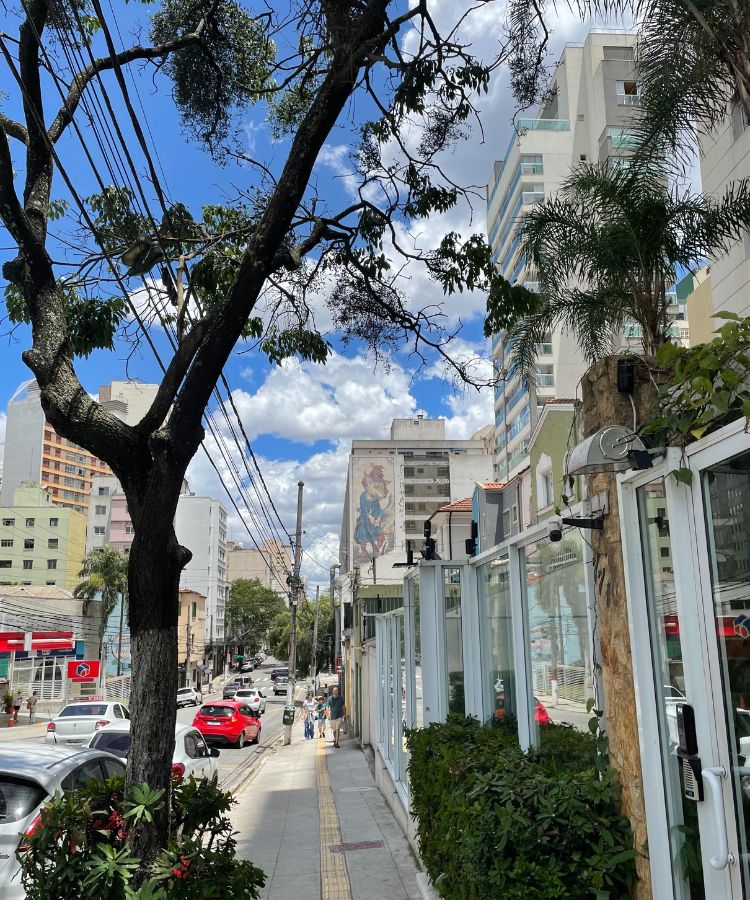
Sao Paulo is the largest city in Brazil and one of the most populous in the world. It has managed to place itself as one of the top tourist destinations in Brazil because of its rich artistic history, delicious food scene, and diverse population that reflects the many cultures that converged there over time.
Is Sao Paulo worth visiting?
Do you love a diverse food scene, beautiful art, history, and/or architecture? If so, Sao Paulo offers all of this and more.
Sao Paulo is a major center for business and finance in South America, making it an important destination for business travelers. As a result, you will experience a dynamic collaboration of cultures when visiting- from the cuisine to the museums and art galleries, as well as the vibrant nightlife.
Which Sao Paulo airport is the best to fly into?
Sao Paulo is a great city to use as a base to fly in and out of Brazil. Sao Paulo Guarulhos (GRU) offers several direct flights into the United States and Europe, making it the busiest airport in Brazil (remember it’s the financial district of Brazil.)
If you’re looking to fly to other cities within Brazil, São Paulo–Congonhas Airport offers several nonstop flights to a plethora of cities within the country. Thus, maximizing your time in Brazil. Because who wants to spend an entire day with multiple flights getting from one city to another?
Things to do in Sao Paulo
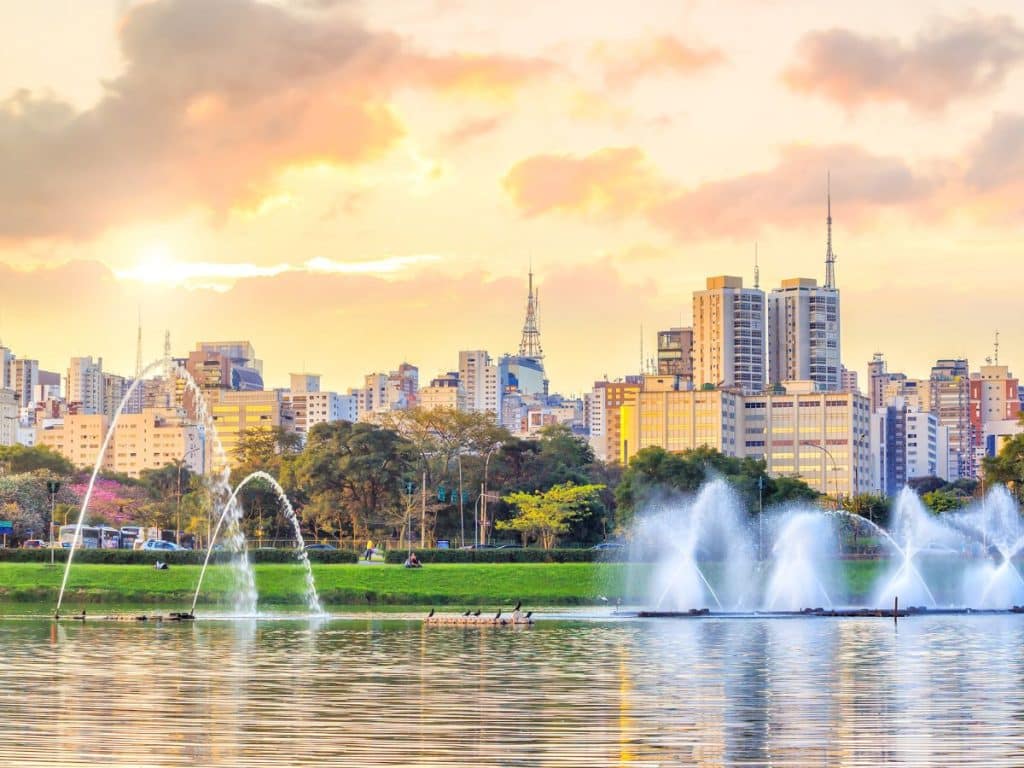
When traveling to a city, one of my main objectives is to experience the destination like a local. Due to its rich cultural heritage, Sao Paulo offers a wide range of family-friendly things to do, including site-seeing, art exploration, swimming, shopping, dining, and more.
Museums and Galleries
So, let’s start with the great Pinacoteca do Estado de Sao Paulo museum, the oldest art museum in Sao Paulo and one of the most important museums in Brazil.
The museum is home to a variety of Brazilian art, as well as European art and structures. Similarly, they host various art collections and cultural events. So be sure to check their website when planning your Sao Paulo, Brazil itinerary.
For art lovers, Pinacoteca is just the beginning of the rich art that Sao Paulo offers. There are numerous art galleries throughout the city if you’d like to explore more art while there.
Another local must-visit thing to do in Sao Paulo is Ibirapuera Park. Now you may be thinking, a park, really? Yes! Why come to Sao Paulo and not go to the most visited park in South America?
People Watching and Cultural Activities
Ibirapuera Park is home to multiple museums, a planetarium, cultural events, pavilions, and trails. It’s a great addition to your Brazil itinerary if you want to experience various aspects of Sao Paulo in one place.
Plus, it’s the perfect thing to do in Sao Paulo with kids! I mean, what kid doesn’t love a park?
Similarly, Paulista Avenue embodies the culture and heart of Sao Paulo. Within its almost 2 miles stretch, you can find a variety of restaurants, museums, art galleries, financial institutes, and more. It makes great people-watching!
Lastly, you can’t spend time in Sao Paulo without trying out its culinary scene. It has a wide selection of restaurants, bars, and coffee shops from various cultures, including Japanese. In fact, Sao Paulo has the largest Japanese population outside of Japan.
✔️ Learn more about Sao Paulo City Tour to maximize your time ✔️
Where to stay in Sao Paulo
If you have spent an exciting and eventful day with your family in Brazil, you will probably need an ideal resting place. Whatever your budget, Sao Paulo has a variety of accommodations .
Sao Paulo Budget-Friendly Hotel
A four-star hotel for less than $100. Say less.
The Mercure Sao Paulo Paulista Hotel is conveniently located within a short walk to Paulista Avenue, the metro, and buses. With clean rooms, friendly staff, and a great location, this hotel is a great option for those who want to be in the midst of the action without breaking the bank.
Sao Paulo Mid-tier Hotel
L’Hotel Porto Bay Sao Paulo is a boutique, 5-star hotel that exudes luxury and top-tier service within walking distance of Paulista Avenue. For those who enjoy spending time at the hotel, they offer a spa and gym, as well as a beautiful pool.
Our Countryside Sao Paulo Family Vacation
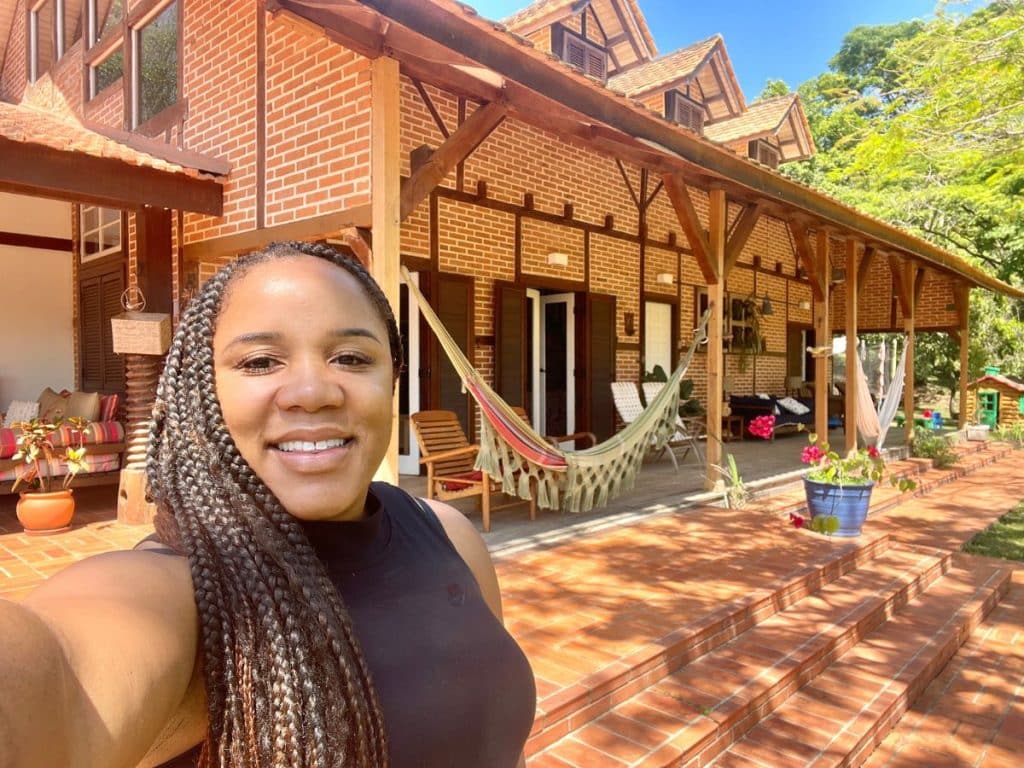
I personally have experienced the metropolis of Sao Paulo for work. So when one of my good friends moved to Indiatuba, Sao Paulo, 2 hours from the metropolitan, I knew we had to take a family vacation to Brazil .
Instead of staying in Indiatuba, a decent size city, we opted for the countryside of Itu, which was less than an hour from where my friend lives. There’s something special about the countryside, where you slow down and can create beautiful, simple memories during your Brazil vacation.
We were going to need this rest day because our one-week Brazil itinerary was jam pack with action!
Family Vacation in Itu, Sao Paulo, Brazil
When traveling to Brazil with kids, our Itu vacation rental was everything we needed and more! As soon as our driver opened the van doors for us to explore our new home for the next few days, our twins immediately ran to the play area, which included a trampoline and playhouse. Between this play area and the soccer field, our boys literally stayed outside for hours, playing.
Gilda and her sister, the chef and housekeeping service cooked mouthwatering meals and kept the house and its facilities in immaculate shape. Not only was the home super welcoming, like going to grandma’s house, but it also had a pool, sauna, and jacuzzi, offering any luxury that you may want.
The home itself was our vacation in Itu. We sat in the hammocks on the veranda and watched the kids play while drinking caipirinhas and listening to music. This was the perfect, slow start to a very busy Brazil itinerary.
Day 4-5: Salvador da Bahia, Brazil Itinerary

Salvador, Bahia in Northeast Brazil is known for its rich Black and African culture and history, as well as its artistic scenes, such as museums and art galleries. On top of that, Salvador has beautiful white beaches, so your family can have a variety of fun while vacationing.
The best way to get to Salvador, Bahia from Sao Paulo
The best way to get to Salvador, Bahia from most cities in Brazil is to fly.
Sao Paulo is no different.
Sao Paulo is located in the Southeast region of Brazil, but driving northwards towards Salvador, Bahia will take over 24 hours. Thus, flying is the best option. All three Sao Paulo area airports offer direct flights to Salvador, making the flight only 2 hours.
Personally, we flew out of the Campinas airport at 5 PM and made it to Salvador in time for dinner. I was so happy to learn that there is indeed Uber in Brazil , in over 100 cities! This made it super easy to get around Bahia and other Brazilian cities.
Is Salvador da Bahia worth visiting?
If you are a cultural enthusiast, Salvador, Bahia in Northeast Brazil, is the right place to visit. Due to its Afro-Brazilian population, it is considered the black city in Brazil. While peeking through the streets of Salvador, you may be dazzled by the city’s vibrant and dynamic culture, not forgetting the remarkable colonial architecture.
Also, prepare your taste buds for a savory culinary experience with a touch of indigenous African flavors and ingredients. As if this is not enough, you can enjoy that toothsome meal while watching your kids build sand castles along the beach.
Things to do in Salvador da Bahia
There are many things your family can do in Salvador during your one-week Brazil itinerary, but tackling them all one by one might be challenging. If you take a guided tour of the city from a reputable company, you can get a good feel for the city in a short amount of time. We took a private African city tour with Sayuri Bahia Local Experience.

If you’re into history and understanding the intricacies of different religions and how people live, adding a Candomble house is a unique addition to your Brazil itinerary. Candomble is an Afro-Brazilian religion that fuses West African tribal practices brought by the enslaved with the beliefs of Native Brazilian Indians. The religion was technically banned by the government until as recently as 1970.
Visiting their place of worship opens your eyes to the history of Salvador and its people. Since a Candomble house is sacred, it’s not open to the public. You have to go on a tour.
✔️ Learn more about the Candomble Religion with a tour ✔️
In my personal opinion, your Salvador da Bahia, Brazil itinerary is not complete without doing these three things: visiting the historical Pelourinho, going to the beach, and taking a tour, preferably an African tour, of the city.
✔️ Learn more Salvador da Bahia city tour ✔️
Pelourinho is the frame historic district, declared one of UNESCO’s World Heritage sites. Here you will find the culture and soul of the city through its architecture, art and structures, cathedrals, and more. You can take the Lacerda Elevator which connects the lower city to the upper city (Pelourinho is in the upper city).
While in Pelourinho, be sure to stop at the square where Michael Jackson recorded the “They don’t really care about us” music video.
Casa do Carnaval da Bahia

Living in New Orleans, we were very curious about Carnival in Bahia, so we stopped at Bahia’s Carnival House as it’s not a far walk from the Lacerda Elevator. It was so cool to see how they celebrate Carnival. The kids loved the room where you can dress in carnival attire and learn different dance moves.
Oh and the view of the city from the top of the museum is breathtaking. It’s the perfect place to sit at their cafe and enjoy a caipirinha and coxinha.
Salvador da Bahia Beaches
Salvador is known for its beautiful beaches. We personally stayed by and hung out at Porto da Barra Beach. It’s a local beach filled with families enjoying the calm waters. The street that lines the beach is filled with delicious restaurants, but it’s not uncommon for folks to grill on the beach in Salvador.
✔️ Want to explore the islands around Salvador? Learn more here ✔️
Where to Stay in Salvador
I’m team “nice and lux lodging” So having an ideal place to relax after engaging in breathtaking activities throughout the day is a must!
We personally stayed at an Airbnb close to Porto da Barra beach. The location was perfect as it was only a block or so from the beach, restaurants, and lighthouse. The view from the living room was perfect, but the rest of the accommodations were just okay.
If you want a Salvador, Bahia vacation rental close to the beach and large enough for a family, you can check it out .
Where to stay in Salvador da Bahia
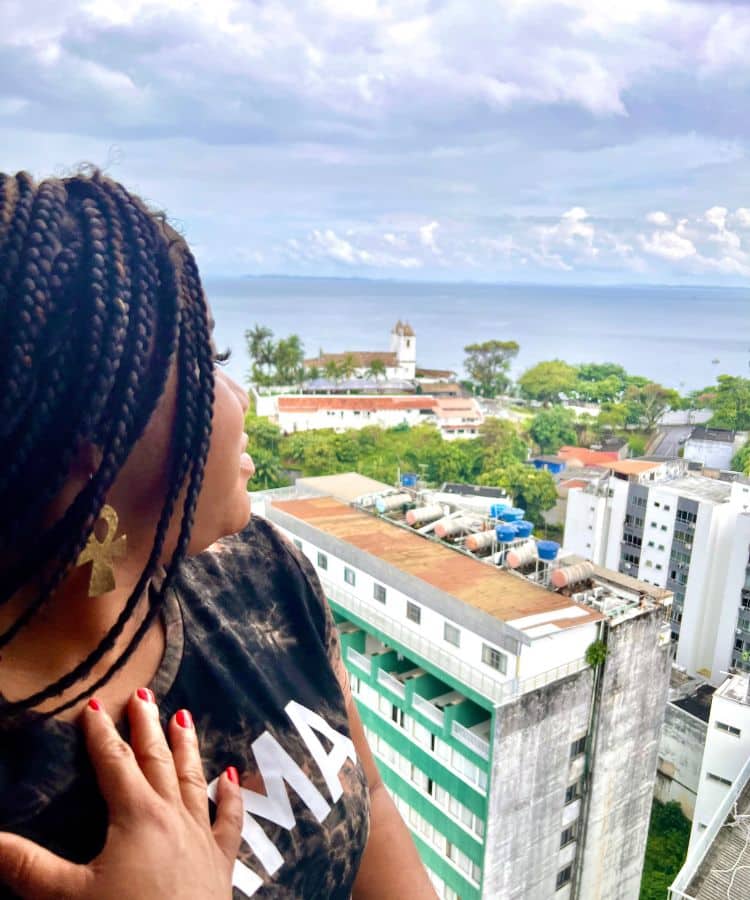
Lodging Close to Salvador Beach, Porto da Barra
Grande Hotel da Barra – Located across the street from the beach, this hotel provides beautiful views of the beach. The accommodations themselves are a bit basic, but it’s one of the best options available if you’re looking to be close to the beach.
Close to Salvador Colonial District, Pelourinho
Hotel Casa do Amarelindo – Located within the historic district of Pelourinho, you are close to the action of the historic part of town. This hotel offers excellent service that includes car service and tours. Plus, the views of the city from the terrace are breathtaking.
Day 5-7: Rio de Janeiro

So I must admit, when I first planned our one-week Brazil itinerary, I initially didn’t have Rio on the list, just Sao Paulo and Salvador. Well, my husband wasn’t having it. And I’m grateful.
Our family vacation in Rio was literally one of the highlights of our Brazilian itinerary. Rio is the perfect family vacation destination. The entire family enjoyed Rio so much that we were all sad when our time there came to an end.
The best way to get to Rio de Janeiro from Salvador, Bahia
There is no need to worry about moving to the next stage of your fun-filled Brazil family vacation. Rio is located on the coast of the Atlantic Ocean, in the Southeastern region of the country, similar to Sao Paulo.
A 7-day Brazil itinerary vacation shouldn’t be wasted on day-long drives when you could be exploring Rio, a vibrant and exhilarating city. Taking one of the multiple flights from Salvador to Rio will save you much-needed vacation time with your family.
For us, we took a 4 AM flight from Salvador and arrived in Rio de Janeiro around 630 AM, with a fun-packed Brazil itinerary. Let’s just say we didn’t get to our lodging until 5 PM!
Why Rio is one of the most visited cities in South America?
Rio de Janeiro is a popular vacation destination site, attracting millions of tourists worldwide. Subsequently, the city is considered one of the most visited cities in South America.
Here’s why.
Rio’s natural landscape is literally breathtaking. It’s picturesque.
Its beauty alone makes you want to explore its neighborhoods, beaches, and mountains. On top of that, its rich and dynamic culture is so vibrant and filled with delicious food, kind people, and fun vibes.
There’s literally something for everyone in Rio de Janeiro.
Things to do in Rio de Janeiro
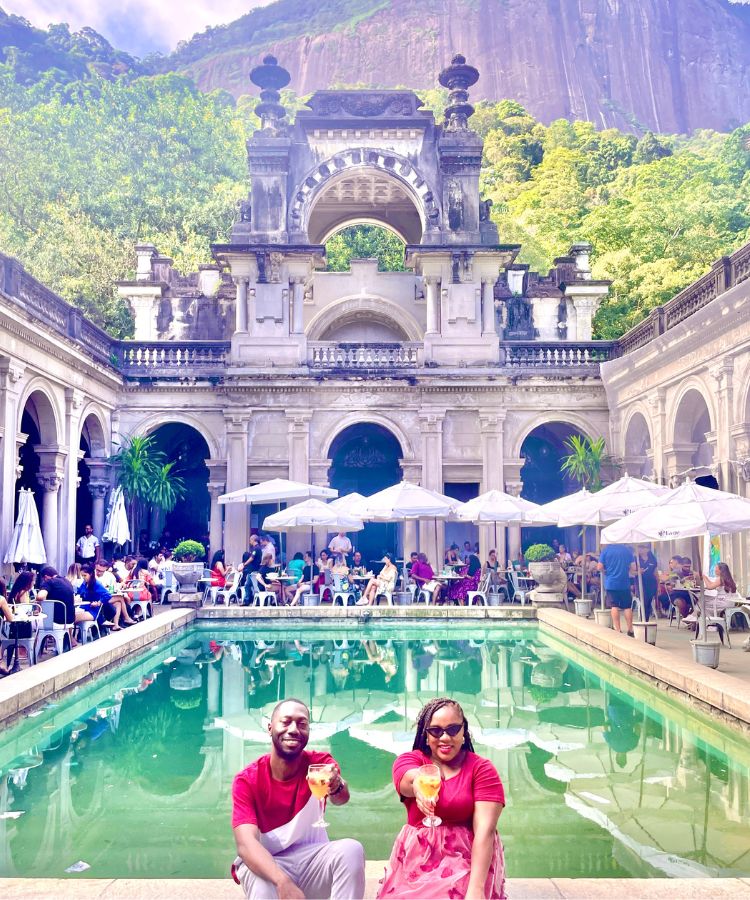
Rio de Janeiro offers a wide variety of things to do, and yes, even family-friendly activities. In fact, there is enough to do that one could fill an entire one-week Brazil itinerary in Rio alone.
If it’s your first time visiting Rio, navigating the city’s colorful mix of art and culture may be challenging due to its massive size and the minimum number of people who can speak English . Engaging a seasoned city guide who’ll take you through the city’s enumerating scenes would be beneficial. Since this was a family trip and there were 5 of us, including twin toddlers, we took a private tour.

Our guide, Alex (Whats App +55 21 98112-6940), was both friendly and professional. He was amazing with the boys and a big help when they became tired or started showing signs of their age (my parents know what I’m talking about.) Working with him gave us the flexibility to maximize our Rio, Brazil itinerary while meeting our family’s needs.
✔️ If you do choose to rent a car, check out these affordable rental rates ✔️
Our Rio Family Vacation Itinerary

When we landed in Rio at 630 AM, we hit the ground running.
Christ the Redeemer- A Must-Do Rio Activity
Our first stop directly from the airport was Christ the Redeemer, one of the seven world wonders of the world. Leaving directly from the airport positioned us to be one of the first people there. We wanted to get there as early as possible to get good pictures to commemorate my boys’ second world wonder.
Machu Picchu was their first world wonder.
I recommend that you arrive at Christ the Redeemer as close to the opening as possible because, towards the end of our time there, it was starting to get crowded and more challenging to get a picture without someone in it.
Another great option to get views of both Christ the Redeemer and Sugar Loaf Mountain is the Estrada Mirante Dona Marta lookout. There is a fraction of the people there and the views of Sugar Loaf Mountain and the city of Rio are absolutely breathtaking.
On the same day, you potentially could include a stop at the famous Selaraon Stairs , or even have lunch with Christ the Redeemer in the background at Parque Lage .
Parque Lage
If you choose to go to Parque Lage, note that it’s more than just a restaurant. It’s also a park. One of my kids truly enjoyed exploring the park. We even saw monkeys running around.
If you just want to take a picture with the iconic scene of Christ the Redeemer in the background (featured in Pharrell and Snoop Dog’s ‘Beautiful’ music video), you have to make a reservation to take a picture.
However, a reservation is not required if you want to eat there. It’s first come, first serve. Our wait to eat was about 45 minutes to an hour.
Sugarloaf Mountain
Sugarloaf Mountain is an experience within itself as you take cable cars to two different mountains, Urca and Sugarloaf. Each offers incredible and unique views of the city. At each stop, there are a variety of restaurants, shops, and more to stop and explore.
Adventurous Things to do in Rio
If you haven’t had enough of an adrenaline rush from the city vibe, you might enjoy hang gliding and swaying leafless, taking in the unparalleled views of the city. Or even take a helicopter ride and take in the spectacular view of Christ the Redeemer statue, Copacabana, and Ipanema beaches.
The experiences in Rio are endless. From sailing on the Guanabara Bay to hiking to waterfalls , the infamous Telegraph Rock , or even the challenging Pedra da Gavea .
No matter what you choose to do in Rio, you are bound to have a great time!
👉🏽 Adventurous Things to do in Rio 👈🏽
✔️ Hang Gliding ✔️
✔️ Sailing on the Guanabara Bay ✔️
✔️ Hiking Waterfalls ✔️
✔️ Hiking Telegraph Rock ✔️
✔️ Hiking Pedra da Gavea ✔️
Where to stay in Rio

Rio is such a massive city that finding the right neighborhood to stay in comes down to preference. Keep reading for where to stay in Rio de Janeiro !
Barra da Tijuca, Rio de Janeiro Hotel
We personally stayed in a local, upscale neighborhood, Barra da Tijuca . This neighborhood made me want to move there as it’s home to its own beautiful, less crowded beach. As well as a variety of restaurants, boutiques, and other recreational sites.
Do note that it’s about a thirty-minute drive from most tourist hot spots, but that’s what I loved about it. You can drive to the ‘must-see’ attractions like Christ the Redeemer, do all of them while out, then come back ‘home’ and enjoy your time around locals.
If you prefer to be in the midst of all of the action, Copacabana and Ipanema are wonderful options as well. Please note, that Copacabana Beach and Ipanema Beach are less than a mile from one another, so why choose one? You can stay in one neighborhood and walk to the other.
Beach Hotel, Windsor Marapendi – This 5-Star hotel is perfectly located in front of the beach, which offers tremendous views of the beach from the rooftop pool. The rooms, breakfast, and service are all excellent.
Copacabana Hotel, Rio de Janeiro
Copacabana is the most popular Rio destination for tourists. This bustling neighborhood is home to the pristine, two-mile, crescent shape beach which is lined with a variety of restaurants, cafes, and shops. There’s always something to do in Copacabana, no matter the time of day.
Windsor California Copacabana – Directly, across the street from the beach and within walking distance to anything you may need, this hotel is a great option for anyone looking to be within close proximity to Copacabana beach. Not only is the location great, but also the accommodations and service, all at a pretty affordable rate.
Ipanema Hotel, Rio de Janeiro
Ipanema is Copacabana’s slightly more upscale cousin. The neighborhood also features a beautiful beach whose beauty draws tourists to sunbathe and even surf. Here you will find upscale boutiques as well as fine-dining restaurants.
Hotel Arpoador – This boutique hotel is located steps from the beach, offering incredible views from the hotel as well as hammocks in the rooms to enjoy the view. While here, you must try the breakfast, one of the things it’s well known for.
Brazil Trip Itinerary: 10 Days in Brazil
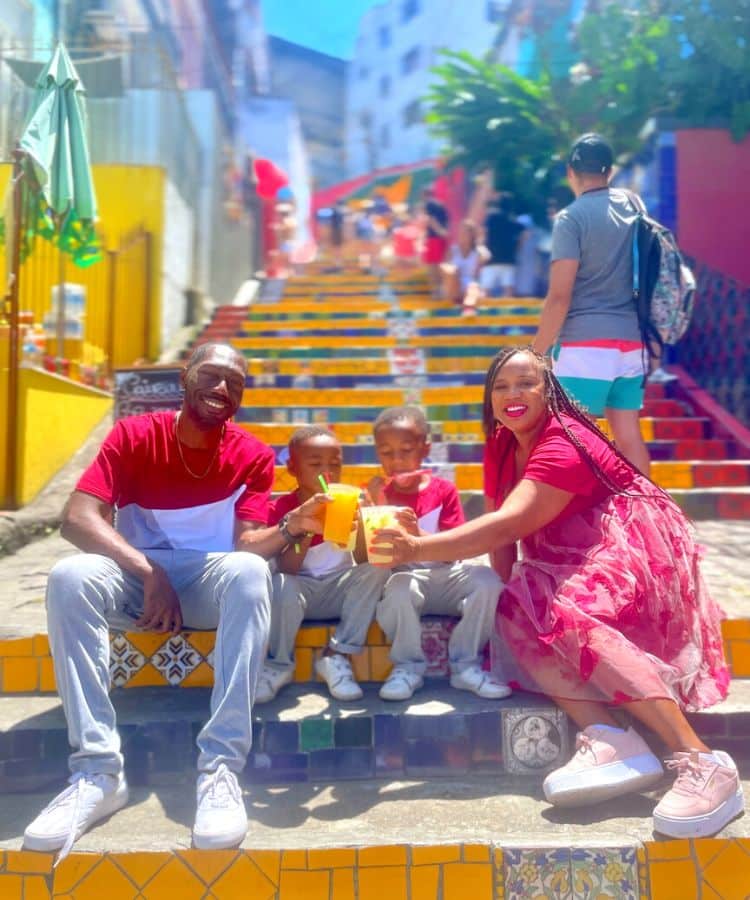
Looking to explore and get the most out of Brazil’s unique attractions. This Brazil 10-day Itinerary explores and offers the best of all worlds- from the largest metropolitan in Brazil (Sao Paulo) to a natural wonder of the world (Iguazu Falls), to one of the seven world wonders (Christ the Redeemer), and so much more!
Itinerary #2
10 days in brazil sao paulo, iguazu falls, rio de janeiro, day 1-3: são paulo, brazil trip itinerary .
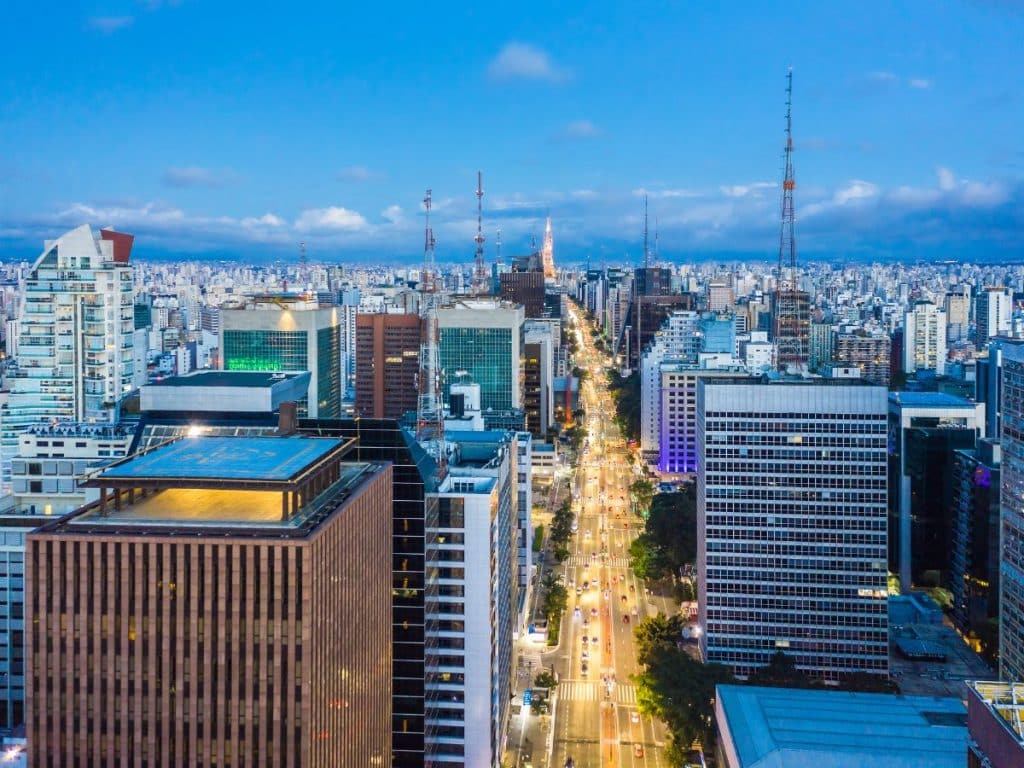
Love experiencing the feel of a large, bustling city. Sao Paulo is your place. Take in the city’s rich history and art culture through its various museums and galleries before people-watching on the bustling Paulista Avenue or Ibirapuera Park.
And Sao Paulo can’t be a part of your Brazil itinerary without exploring its delicious gastronomy scene. Likewise, if experiencing nightlife in a different country is your vibe, you won’t be disappointed in Sao Paulo.
Day 4-6: Iguazu Falls, Brazil Trip Itinerary
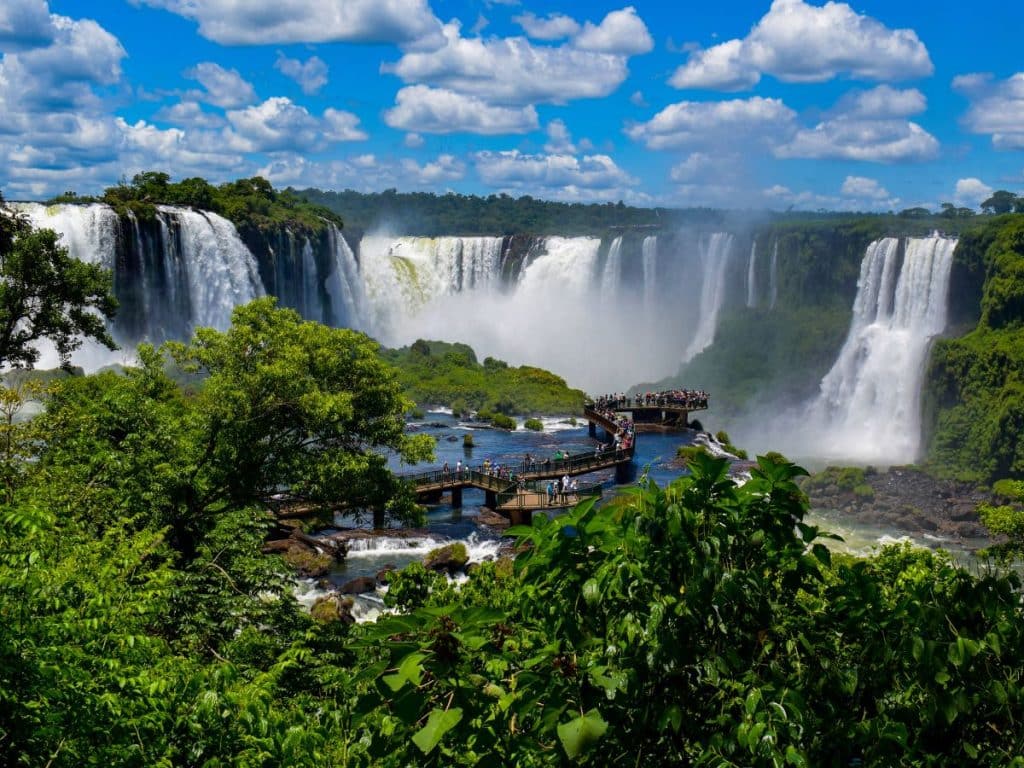
Get ready to explore one of the remarkable natural wonders of the world, Iguazu Falls. Not only can you experience this breathtaking waterfall up close and personal, but the area offers a quaint town filled with restaurants and shops, as well as some parks and hikes.
What is Iguazu Falls?
Iguazu Falls are one of the largest waterfall systems in the world. It is spread out over two miles, on the border of the Argentine province of Misiones and the Brazilian state of Paraná.
Which side is better to view Iguazu Falls?
When viewed from Brazil, the natural scenery is elegant and dashing. However, Argentina’s side has more activities and tours available.
Can you visit both sides of Iguazu Falls in one day?
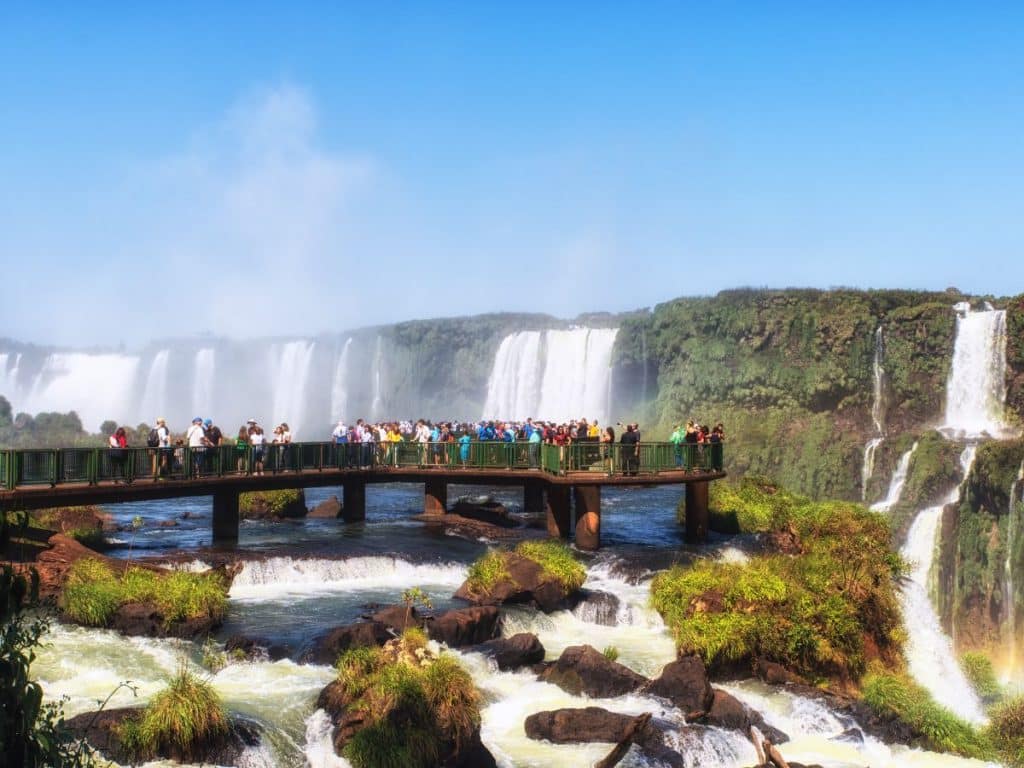
Yes, it’s possible to see both sides of Iguazu Falls in one day . If setting out to see both the Argentian and Brazilian sides of Iguazu Falls in one day, be prepared for a busy day. For a more relaxing and thorough experience, splitting each side into individual days is recommended.
In fact, there are tours of both sides over a 2-day period.
Getting from one side to another takes about 1-2 hours, depending on the season and traffic. November through March is the busy season and can take up to 2 hours to clear customs.
When driving from Brazil to Argentina, your car must have a Carta Verde (green card), as well as your passport. If you prefer not to drive, you can take a bus , which honestly has lackluster reviews, or use a tour /transport company.
The best way to get to/from Iguazu Falls
The best way to get to Iguazu Falls from Brazil is to fly to Foz do Iguazu International Airport (IGU). It’s conveniently located just five minutes from the Falls on Brazil’s side and a thirty-five minutes drive to Iguazu Falls from Argentina’s side (not taking traffic into consideration.) Airports from both Sao Paulo and Rio offer multiple direct flights to IGU.
Things to do in Iguazu Falls

As the area’s main feature, you must see the Iguazu Falls. As previously mentioned, the Brazil side is known to be the most beautiful side while most tours and activities occur on the Argentina side.
A tour of the Argentina side of Iguazu Falls usually involves visiting the Upper Circuit, Lower Circuit, and Devil’s Throat, which offers panoramic views of the waterfalls and the jungle, as well as the spectacular sight of the plume of mist. Be prepared to do some walking, as the views are worth every step. Some tours include an optional boat ride for thrill-seekers.
From Brazil’s side of Iguazu Falls, bus tours typically include visits to the panoramic terrace and the lower trail, where visitors can experience the power of the falls at the base. For the more adventurous traveler, take a helicopter r ide for an unparallel view of both sides.
For individuals who prefer to explore the waterfall on their own, you can visit both Parque Nacional Iguazu (Argentina side) and Parque das Aves (Brazil side) without a tour.
👉🏽 Iguazu Falls Tour Options 👈🏽
✔️ 1 Day Brazil and Argentina Tour ✔️
✔️ 2 Day Brazil and Argentina Tour ✔️
✔️ Brazil Tour ✔️
✔️ Brazil Helicopter Tour ✔️
✔️ Argentina Tour with Optional Boat Ride ✔️
Where to stay in Iguazu Falls
There are a variety of lodging options on both the Brazil and Argentina sides. I recommend choosing which side best suits your itinerary. If you desire to be near activities outside of Iguazu Falls, the Argentinian side is the best option.
Iguazu Falls, Argentina Hotel
To maximize your family experiences around Iguazu Falls, stay at the Jasy Hotel on the Argentine side, just within walking distance of the amazing scenery. If you prefer to take in the relaxing views of the jungle, Selvaje Lodge Iguazu is a wonderful option.
Iguazu Falls, Brazil Hotel
Sanma Hotel By Nobile is the perfect home, away from home. This hotel offers excellent services and first-class accommodations. The hotel is ideal if you want to focus entirely on experiencing every deep refreshing breath of your interaction with the Iguazu Falls, as there are no other activities aside from visiting the falls.
Day 7-10: Rio de Janeiro, Brazil Trip Itinerary

Rio is the perfect finish to your 10-day Brazil itinerary due to its unique blend of nature and culture. Some must-dos during your stay in Rio are visiting the World Wonder, Christ the Redeemer, taking a boat ride on the Guanabara River, and enjoying the Brazilian beach culture. Whatever you decide to do in Rio, you’re subject to have an amazing time.
Check out the first section, the 7-day Brazil itinerary for more suggestions on things to do in Rio de Janeiro.
Brazil Trip Itinerary: Brazil 2 Week Itinerary

This Brazil 2 Week itinerary ensures that you and your family get to sample some of the most thrilling and unique experiences that Brazil has to offer. The journey explores popular destinations within the state of Rio de Janeiro as well as the metropolitan of Sao Paulo.
Itinerary #3
2-weeks in brazil: rio de janeiro, ilha grande, paraty, sao paulo, day 1-3: rio de janeiro, brazil trip itinerary .

During this two-week Brazil itinerary, it’s recommended to experience the culture and vibrant nature of Rio. From going to the various restaurants, hanging out on Cocacabana or Ipanama Beach, or experiencing the Rio nightlife, this is the part of the itinerary to let loose and take in Brazil’s vibrant culture. Also be sure to check out the world wonder, Christ the Redeemer.
If you don’t get the opportunity to do a boat ride or nature hike, that’s okay as both Ilha Grande and Paraty offer water and hiking adventures.
Day 4-6: Ilha Grande, Brazil Trip Itinerary
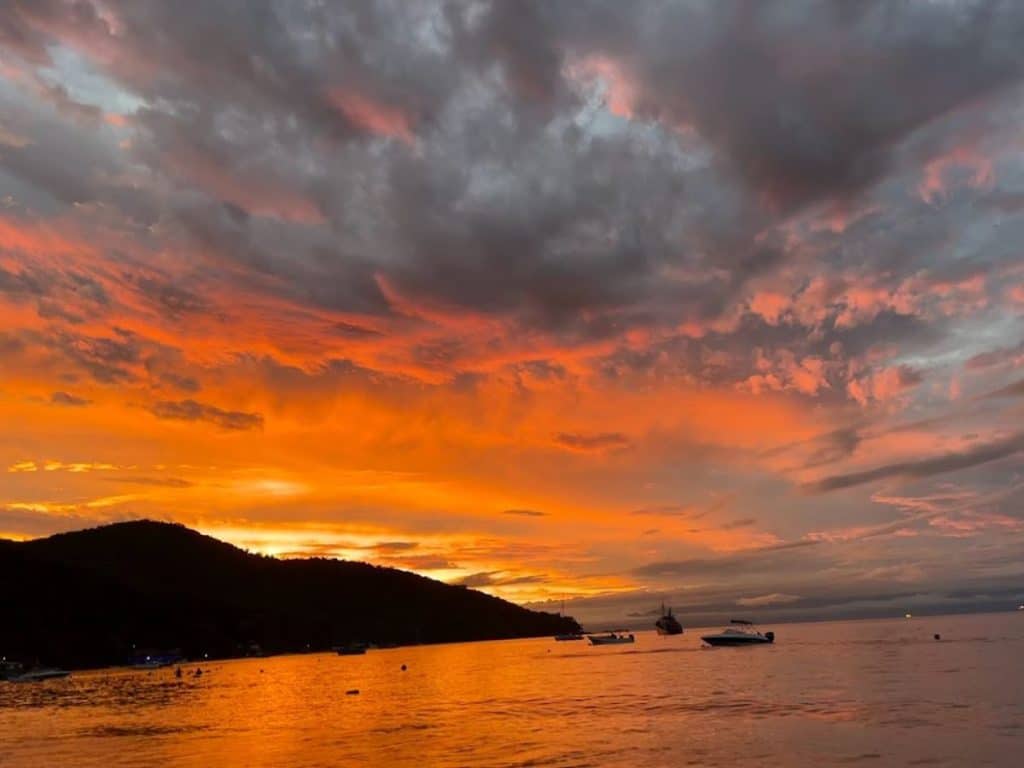
On your first two days in the Ilha Grande, make the most of your family vacation by taking boat rides, seeing one of the best waterfalls in the region, and engaging in outdoor sports like hiking and snorkeling. Lastly, no vacation in the town would be complete without a relaxing moment on one of the top beaches.
Is Ilha Grande worth visiting?
Ilha Grande offers the complete package for a family vacation if you love nature. Beautiful beaches, lush rainforests, and crystal-clear waters are some of the state’s most popular attractions. Hiking, snorkeling, and swimming are among the activities you can enjoy in the lustrous Brazilian state.
What’s the best way to get to Ilha Grande?
Ilha Grande is a car-free island. In order to reach the island you can either take the Rodoviaria bus or a shared transportation van from Rio to the Conceiço de Jacare port where you can take the ferry to Abraao for twenty minutes. The ferry offers frequent trips throughout the day, so you won’t miss out on any fun activities on the island.
If you prefer all of the logistics to be done for you, choose a transportation company that includes land and sea transportation services .
Things to do in Ilha Grande
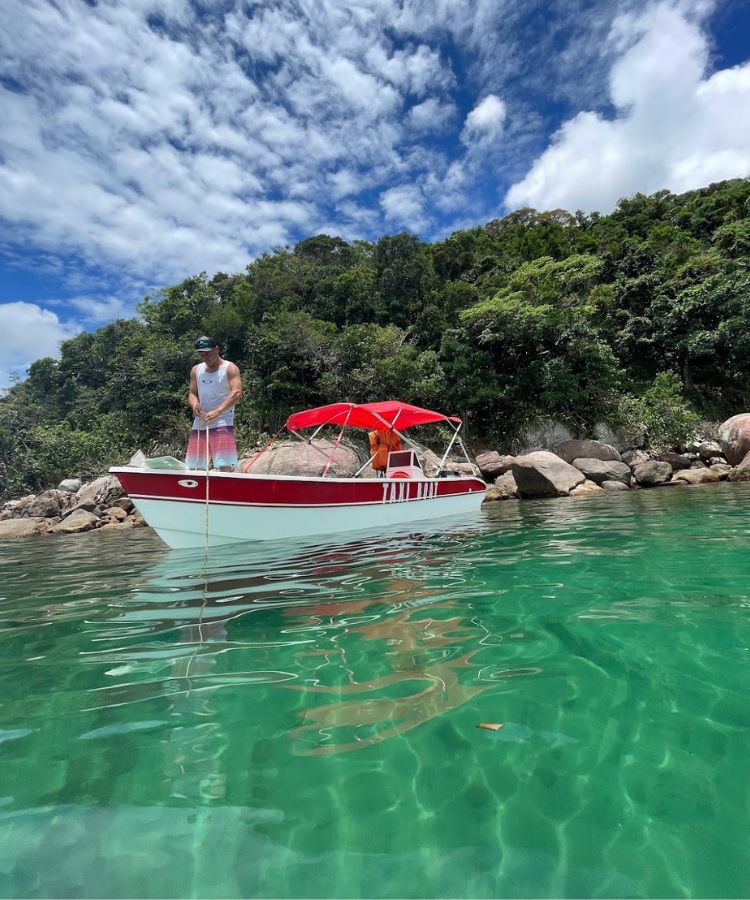
Outdoor adventure awaits you in Ilha Grande.
Your vacation to Ilha Grande is not complete if you have not visited two of the most outstanding beaches in all of Brazil; Lopes Mendes and Lagoa Azul. Both beaches have spectacular views of the crystal-clear ocean water.
Aracatiba is another quaint and quiet beach
Not only does Ilha Grande offer some of the most beautiful beaches, but the hiking is spectacular. Experience a private hike or a midnight hike through the historical features of the island. If hiking is on your Brazil itinerary be sure to hike to the most visited waterfall in Ilha Grande, Feiticerira Waterfall.
Please note the hike to Feiticerira Waterfall is considered a bit challenging due to the dirt roads and some inclines and declines. On average it could take between 90-120 minutes to complete, depending on the person.
The good news is it’s worth every step as the waterfall is beautiful and you can bathe in it upon your arrival (although the water can be a bit cold.) Plus, if you continue the path to the public beach, there is an option to take a taxi boat for your return.
If you’re looking for an easy hike, lagoa verde (green lagoon) is a nice place to take an easy hike and hang out on the water. It’s a great addition to your Brazilian itinerary with children.
If you have little ones in tow, these hiking tips will help make the experience more pleasing for everyone.
👉🏽 Hikes in Ilha Grande 👈🏽 ✔️ Private Hike ✔️ ✔️ Midnight Hike ✔️
Where to Stay in Ilha Grande
Granted, Ilha Grande is no match for the lush apartments and hotels in Rio or even Sao Paulo. Nevertheless, the island makes up for what it lacks in modern styles with authentic, fresh, and serene environments.
Vila do Abraao is the island’s main village and hosts many hotels, guesthouses, and vacation rentals. The quaint town has several shops and restaurants within close proximity. Check out Vila Parnaiba for an ideal experience in the area.
Day 7-10: Paraty, Brazil Trip Itinerary
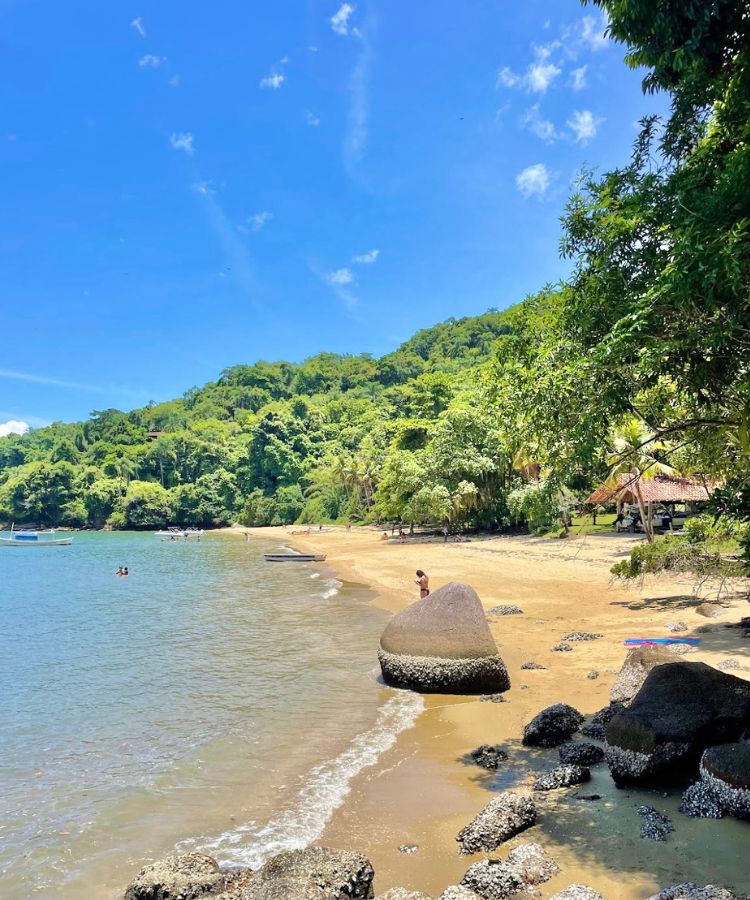
Paraty is perfect for those seeking to hike, explore the sites, and enjoy a relaxed moment at the beach. When visiting Paraty, be prepared to take it slow and take in the beauty this quaint town has to offer.
Is Paraty worth visiting?
Yes! Whether you are a nature enthusiast or just a lover of outdoor scenes, Paraty is a treasure, allowing you to experience intimate moments with beautiful waterfalls and beaches.
You will also be privileged to witness how sunrise and sunset create an aura of deep calm and serenity as the cobblestone streets naturally blend in with the scenic beauty of the colonial town.
What’s the best way to get to Paraty
Much like Ilha Grande, Paraty is not accessible by plane, at least not directly. The closest airport to Paraty is the Rio de Janeiro-Galeao International Airport, which means you still have to take a bus or a car to the historic town.
Despite the small challenge in air travel, you can still make the most of your Brazil vacation by taking bus and boat transfers from neighboring towns such as Angra dos Reis, Ilha Grande, and Ilhabela. The transport from Ilha Grande is about 2 hours while the transport from Rio is around 90 minutes.
Things to do in Paraty
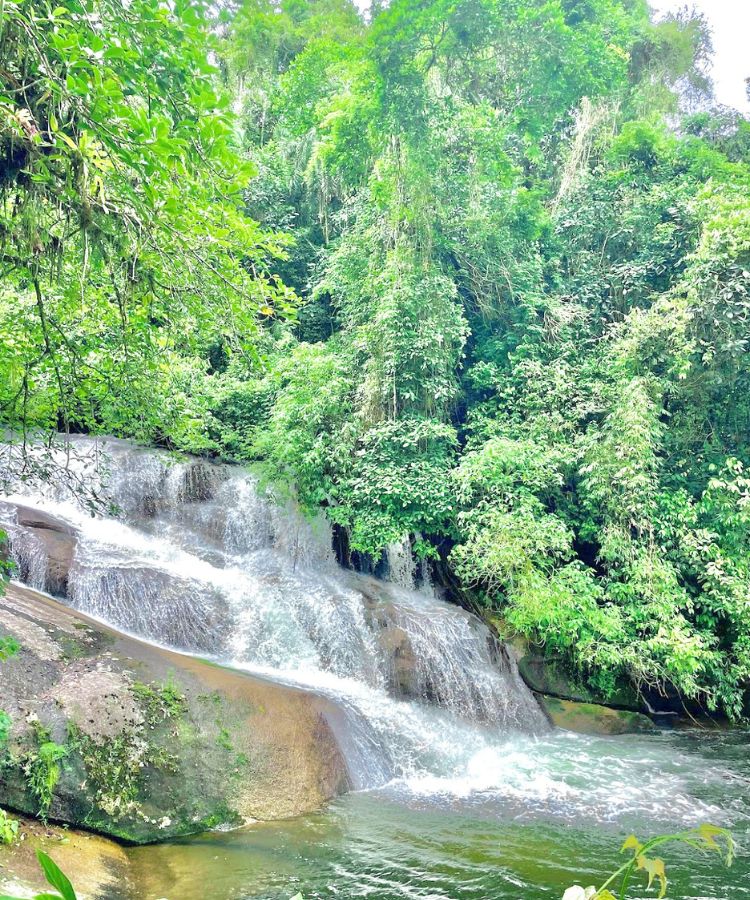
If you are adventurous, you will find a lot of activities to do in Paraty.
Paraty is home to numerous waterfalls.
Two must-visit waterfalls are Cachoeira do Toboga and Cachoeira da Pedra Branca. These waterfalls bring out your inner kid as they have natural water slides. Perfect for an adventurous family vacation.
Similar to Ilha Grande, you can’t come to Paraty without exploring its great beaches. There are plenty of beaches where you and your family can enjoy various water sports like boat riding, swimming, etc.
If you’re traveling with kids to Paraty, Jabaquara Beach is a great option as it’s easily accessible, the tides are low, and they have kiosks that sell food, snacks, and drinks.
Most other beaches in the area are a little further from the city, and you may have to take a hike, bus, or boat to access them. But the views are worth it!
Some of the top options are Praia do Rosa, Praia do Sono, Praia de Antigos, which is close to Praia do Sono, and São Gonçalo, one of the most beautiful beaches in Paraty.
For those who want activities outside of nature, Paraty also offers historic city tours and Alambique, a cachaca distillery, to name a few.
Where to Stay in Paraty
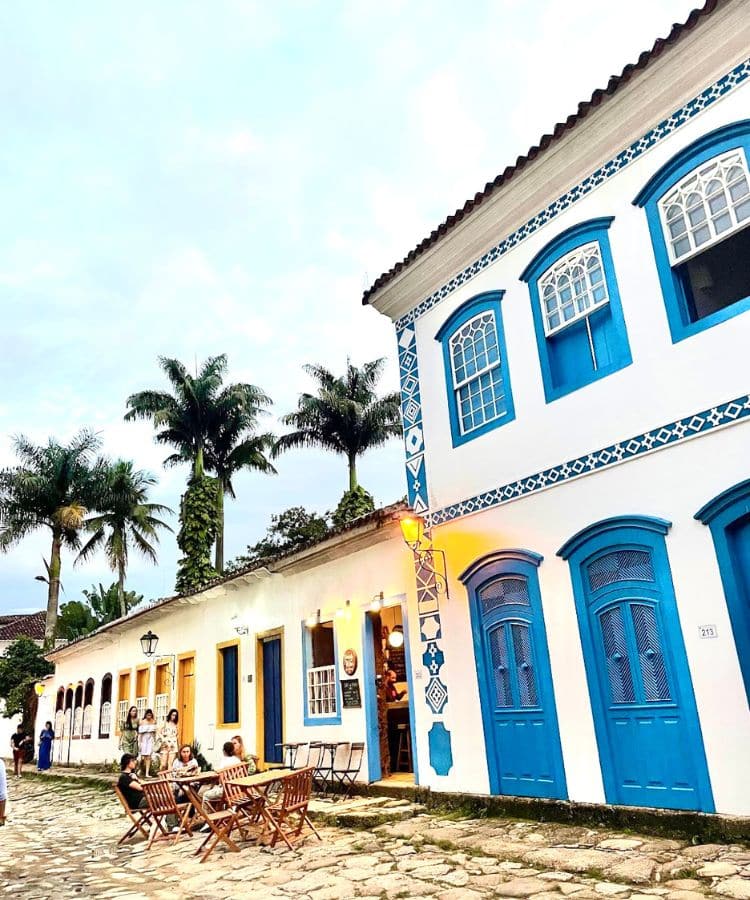
Paraty offers a wide range of lodging, from budget-friendly, to luxurious, as well as beachfront hotels. The ultimate choice depends on your budget and personal preferences.
Paraty, Brazil Mid-Tier Hotel
Calamar Flats Paraty is a modern, beachfront boutique hotel that offers rooms with views of the sea or mountains. The rooms are actually apartments that have a kitchen and living room. And the pool and garden area are gorgeous.
Paraty, Brazil Luxury
Casa Turquesa – Maison D ́Hôtes is the epitome of luxury and detailed service. Located in the heart of the quaint town of Paraty, the staff of this boutique hotel treats guests like both family and royalty. You will not be disappointed to stay here; the reviews speak for themselves.
Day 11-14: São Paulo, Brazil Trip Itinerary
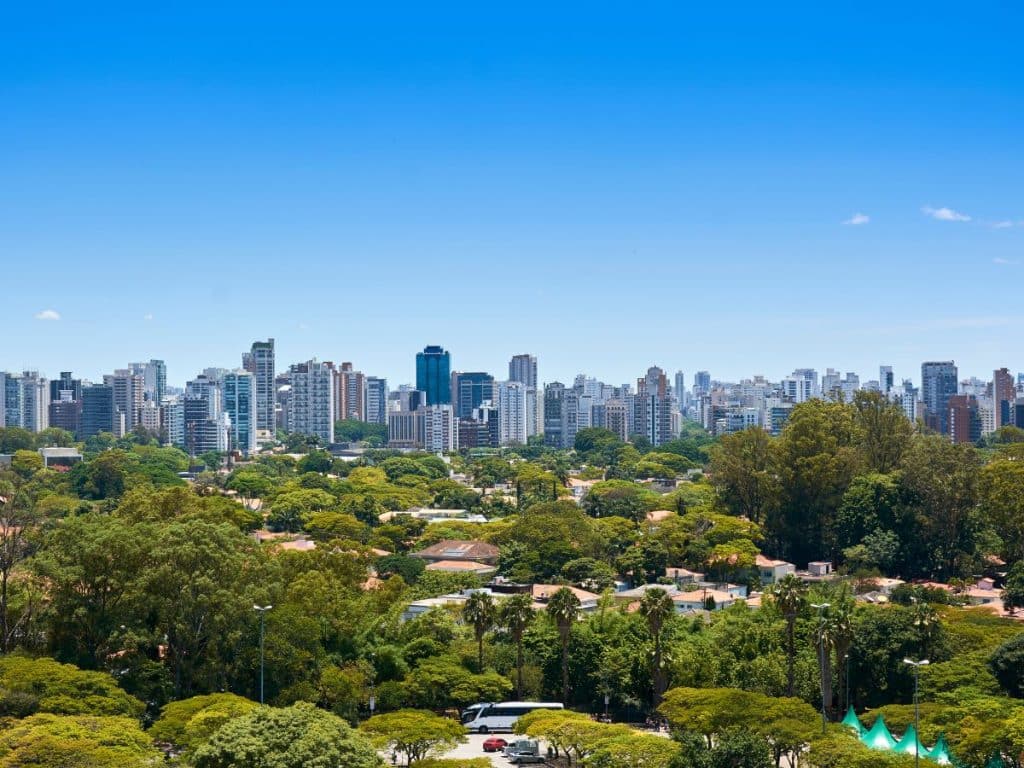
You will be able to explore great artworks, art scenes, grand architecture, and the general culture of the people in the city the moment you land in the metropolitan mega city. Be sure to get a taste of Sao Paulo’s wonderful food and nightlife scene.
Reference the 7-day Brazil itinerary above to get more details on things to do in Sao Paulo.
Activities that can be included in most Brazil Itineraries
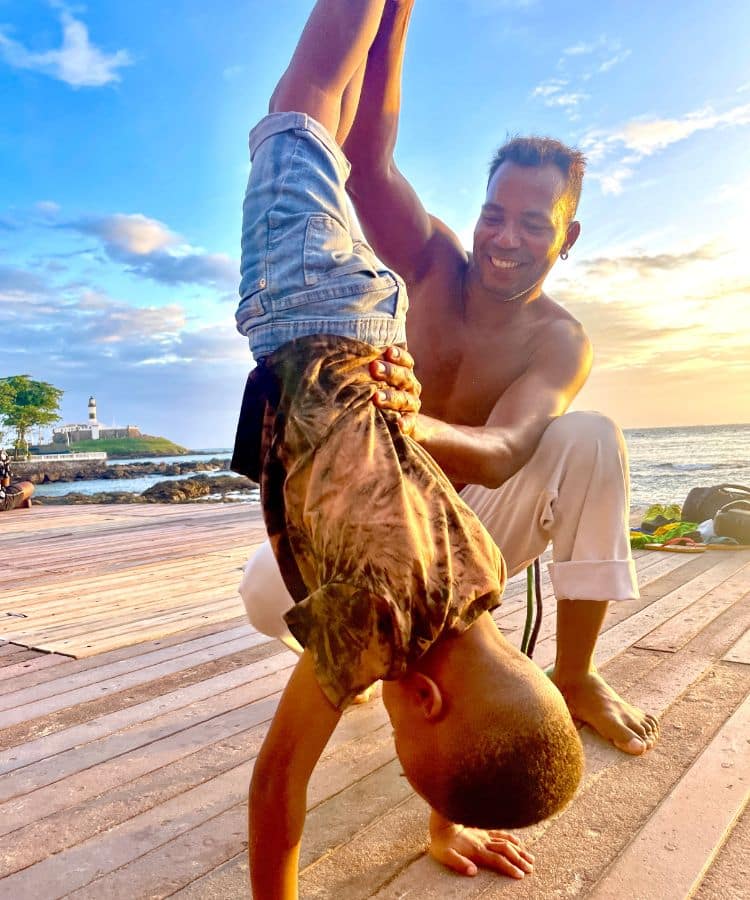
Brazil has such a unique culture that embodies the vibrance and beauty of the country. It would be a miss not to add at least one of the following activities to your Brazil itinerary. Personally, my family did all of the below as we wanted to get as much of a local and cultural experience as possible.
Luckily, most major cities, especially Sao Paulo, Salvador, and Rio offer these types of cultural experiences.
Brazilian Cooking Class
Brazil is home to many unique and delicious dishes. Why not try your hand at preparing a Brazilian dish while exploring your Brazil itinerary? Plus, it gives you an experience with a local.
Our boys LOVE to cook, so it was a perfect experience for our family. Our class was located at the home of a local chef, coordinated by our Salvador, Bahia tour guide Sayuri.

In our Brazilian cooking class, we made a traditional Brazilian appetizer made with shredded cheese and carrots wrapped in a cassava flour “wrap” of sorts. The boys were the sous chef with this dish as they shredded the cheese and carrots.
The adults focused on making the moqueca, a Brazilian fish stew. The fish was already cut so all the adults needed to do was slice the vegetables, layer them on top of the fish, and pour the freshly made coconut milk on top.
After adding a little salt and pepper and boiling the dish, magic was created! The meal was delicious, but the opportunity to spend time with a local Brazilian, in their home, was priceless!
Samba and Afro-Brazilian Dance
This class was not only fun but it’s a challenge!
With Samba you may think you got the moves while the instructor slowly explained each step. However, when he put those moves to the actual beat…help me!
The Afro-Brazilian dance moves were not as challenging, but they were still a great workout. The boys really enjoyed “dancing” to these songs and playing the drums.
This class is perfect for those who love music and dance.
An Afro-Brazilian martial art that combines an element of dance and more into its practice.
My boys are at the stage where they love to kick and move, so this capoeira class was perfect. It taught them not only how to make the movements but about body and mind control and when to choose to use these movements.
If you enjoy moving your body in unique ways while learning about other cultures, a capoeira class is a must-add to your Brazil itinerary.
Conclusion: Brazil Trip Itinerary
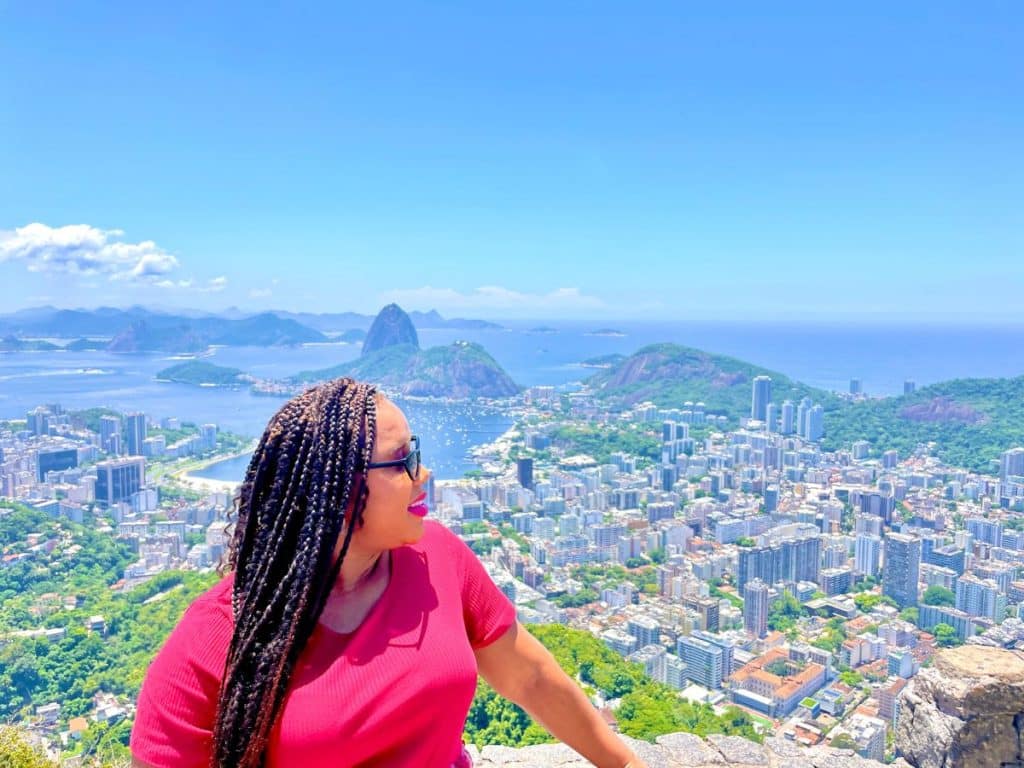
Brazil is the 5th largest country in the world, offering an unlimited amount of things to do and destinations to explore. Therefore, one could literally spend months and years exploring cities in Brazil and not get to see everything.
However, these three Brazil itineraries: 7 days, 10 days, and 14 days, will give you and your family an excellent taste and variety of what this amazing country has to offer while you’re on vacation. Don’t hesitate to mix and match itineraries and make your Brazil vacation your own.
Whatever you choose to do while in Brazil will leave you wanting to return to explore more of this unique and naturally beautiful country.

Grand Canyon and Sedona With Kids

Chiang Mai With Kids

15 Tips to Help a Toddler Sleep on the Plane

13 Best Swimming Ear Plugs for Kids
Journey to Brazil
March 25, 2016 12 Songs, 38 minutes ℗ 2016 Retro Style Records
More By Stan Kenton and His Orchestra
Featured on.
Apple Music Jazz
Select a country or region
Africa, middle east, and india.
- Côte d’Ivoire
- Congo, The Democratic Republic Of The
- Guinea-Bissau
- Niger (English)
- Congo, Republic of
- Saudi Arabia
- Sierra Leone
- South Africa
- Tanzania, United Republic Of
- Turkmenistan
- United Arab Emirates
Asia Pacific
- Indonesia (English)
- Lao People's Democratic Republic
- Malaysia (English)
- Micronesia, Federated States of
- New Zealand
- Papua New Guinea
- Philippines
- Solomon Islands
- Bosnia and Herzegovina
- France (Français)
- Deutschland
- Luxembourg (English)
- Moldova, Republic Of
- North Macedonia
- Portugal (Português)
- Türkiye (English)
- United Kingdom
Latin America and the Caribbean
- Antigua and Barbuda
- Argentina (Español)
- Bolivia (Español)
- Virgin Islands, British
- Cayman Islands
- Chile (Español)
- Colombia (Español)
- Costa Rica (Español)
- República Dominicana
- Ecuador (Español)
- El Salvador (Español)
- Guatemala (Español)
- Honduras (Español)
- Nicaragua (Español)
- Paraguay (Español)
- St. Kitts and Nevis
- Saint Lucia
- St. Vincent and The Grenadines
- Trinidad and Tobago
- Turks and Caicos
- Uruguay (English)
- Venezuela (Español)
The United States and Canada
- Canada (English)
- Canada (Français)
- United States
- Estados Unidos (Español México)
- الولايات المتحدة
- États-Unis (Français France)
- Estados Unidos (Português Brasil)
- 美國 (繁體中文台灣)
Join the journey: Click here to get our top tips for affordable travel!

Brazil 10 Day Itinerary | The Best Travel Guide

Brazil is probably best known as the largest country in South American and for the very famous Christ the Redeemer Statue. Brazil is full of beautiful beaches, incredibly friendly people, great food, and great music. It is hands down one of my favorite countries visited of all time! If you are ready to visit this amazing country, and plan the best Brazil trip ever, keep reading for the best Brazil 10 day itinerary.
Table of Contents
Brief History | Brazil
Early history.
Brazil was originally inhabited by hundreds of Jiquabu tribes before the arrival of the Europeans. The people living there consisted of semi-nomadic tribes in the east and agrarian civilization in the west coast.
Neither group developed written records or monumental architecture; as a result little is known about the history of the country before 1500. What has remained of those civilizations is elaborate pottery and some mound-building suggest complex and sophisticated cultures.
Colonizers from Europe first arrived to Brazil in 1493. They named the land Brazil, most likely due to the brazilwood trees that once lined the Brazilian coast. These trees were prized for their ability to produce red dye. In 1500, the land was claimed for Portugal, who really didn’t pay attention to it until 1529, given profitable trade with other countries.
Once Brazil turned their attention to Brazil they managed the colony by donating strips of land to Portuguese noblemen. These men were to in turn, manage the land for the king. This system was called the Captaincy Colonies of Brazil, but ultimately did not work. In 1549, to solve this problem, the Portuguese king established Salvador as the capital, and restructured the independent colonies into a single one known as the Governate General of Brazil.
The early centuries of colonization were quite violent, with near constant war between the Portuguese colonizers and the indigenous peoples of the land. From the mid 16th century to the end of the 17th century, cane sugar became the largest export of Brazil. This led to a high reliance on slave labor, as in most of the Americas; which became Brazil’s largest import. Over 2.8 million slaves from West Africa came to Brazil between 1500 to 1800.
United Kingdom of Portugal
There are two things I’ve found to be really interesting regarding the history of Brazil. The first is the fact that for a time (1807 – 1821) the official kingdom of Portugal moved to Brazil. The whole royal court and everything. This was really to escape the pending Spanish and Napoleonic forces that were threatening their security. Once the Peninsular War ended in 1814, the courts across Europe demanded that the royal family return, but they wanted to stay. So they established the United Kingdom of Portugal, Brazil, and the Algarves to establish a multicontential monarchical state.
They ultimately could not resist the pressure placed on them, so the royal court left Brazil in 1821. The second interesting fact here is that all that I mentioned above is what led to the independence of Brazil. Upon departing Brazil, the royal family wanted to establish Brazil as a colony, but the Brazilians were not interested. Prince Pedro (who stayed behind in Brazil) agreed with the Brazilians, and declared Brazil independent on September 7, 1822. Pedro was given the title of Dom Pedro I, the new Emperor of Brazil. Thus began the Brazilian War of Independence, which lasted until August 29, 1825.
Early Empire to Present Day
The monarchy operated through 1889, when it was replaced by a republican government. During this time slavery was finally abolished in 1888, the last country to make this change in the Americas.
Know Before You Go | Brazil
Getting to brazil.
When flying into Brazil I recommend flying into the larger cities for the best prices and flight schedules. This itinerary centers around Rio and Salvador, so we are going to talk about flying into both of those airports.
If you are coming in from another country, you are most likely to fly into the Rio Janeiro-Galeão International Airport (GIG). Flying into Rio gives you some of the most amazing views. I don’t know if I’ve ever experienced anything like flying into the city and seeing the mountains sitting in clouds over the water. And the runway may be one of the most intense I’ve ever landed on – it’s a whole experience! This airport is further from the Centro, about 20 minutes or so, depending on traffic.
When leaving Rio to travel to the rest of Brazil, you are most likely to go through the Santos Dumont airport. This airport is a bit smaller and handles mostly domestic flights. This airport is quite close to the Centro area of Brazil, just 5-10 minutes.
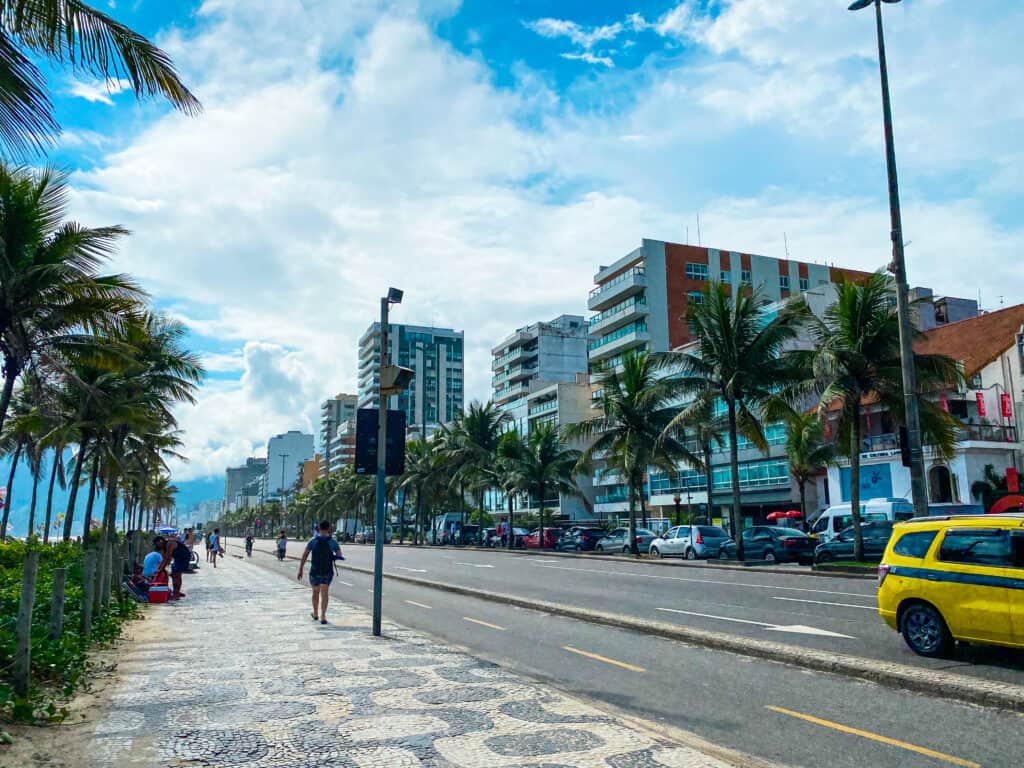
Where to Stay in Brazil
This guide features three areas: Rio, Salvador, and Praia Do Forte. I’m sharing a recommendation for each area so you can get an idea of the available options:
Ipanema Inn Hotel: This is a larger hotel that has a smaller hotel vibe. Breakfast is included in the room, and guests note how great the service is here. It’s also located just 450 feet from Ipanema Beach and is also very close to a metro station as well.
JW Marriott : I stayed here for part of my visit to Rio, and will say that the service was lovely and the breakfast was great. It is another option with easy access to the beach, but Copacabana in this instance.
Bahiacafé Hotel: This boutique hotel is built in a building from the 1700s, and is located just near the Praça da Sé in the very heart of Pelourinho.
Praia Do Forte
Pousada João Sol: This eco-hotel features a treehouse vibe / decor, and includes an excellent breakfast. It’s also just a 10-minute walk to the beach.
Getting Around Brazil
When you are not in very walkable areas, it is quite easy to get around the city via Uber – and you’ll find they are quite cheap. It was my preferred way to get between neighborhoods in the grand city of Rio, and I felt very safe doing it.
Language in Brazil
The language spoken in Brazil is Portuguese, and while you can certainly find tour guides and people in more touristy areas that speak English, it is not widely spoken anywhere. At least that has been my personal experience. I recommend learning some basic phrases before you go, in order to be able to get around easily during your visit. Check out my post on Portuguese for Travel for some key phrases!

Download now!
The portuguese phrases pdf.
Have all the common Portuguese travel phrases at your fingertips so that you are prepared for any situation!
money in brazil
The local currency in Brazil is the Real, or Reais (plural). The “r” has more of an “h” sound in Brazilian Portuguese, so it sounds more like hey-alle. At the time of writing this post, the exchange rate was R $1 = $5.23 USD. Despite this, things aren’t as cheap as you might expect, so keep this in mind as you plan your trip.
where to eat in brazil
Keep reading for food recommendations in the itinerary below!
The Ultimate Brazil 10 Day Itinerary
Rio de janeiro .
Rio is well known as one of the big cities of Brazil. In my humble opinion, Rio is one of the most beautiful cities in the world.There is something really special about those rare cities that have both mountains and beaches, and Rio offers plenty of both. The captivating views really begin from the moment you fly into the city.
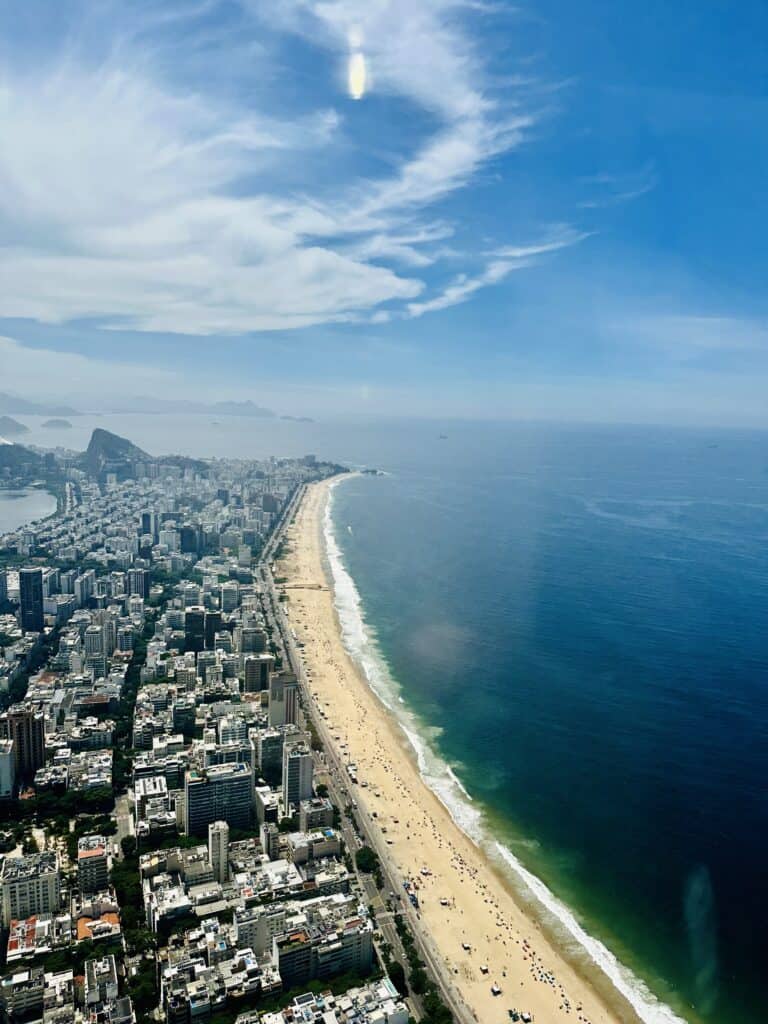
Full Day in Rio Tour
⭐️⭐️⭐️⭐️⭐️
Experience the beauty and splendor of Rio with a local guide on this full-day city tour. Learn why this city is known as the “Marvelous City” as you visit landmarks such as:
- Sugarloaf Mountain
- Christ the Redeemer Statue
- Seralon Steps
- Maracanã Stadium
- …and more!
Day 1 – Explore Rio De Janiero
I recommend starting your time in Rio by visiting all the top sites in the city . A few places that you must see include the following:
Christ the Redeemer Statue : One of the “new wonders of the world”, this statue was commissioned by the Catholic Circle of Rio and completed in 1933. Jesus is meant to be a symbol of peace in the statue, given his open arms. The statue sits atop the 2,300 ft. Corcovado mountain in the Tijuca National Park, and hence offers impressive views of the city below as well. To visit the statue (and the park), you’ll travel up the mountain via Corcovado Rack Railway.

Maracanã Stadium : This is Rio’s main football (soccer) stadium, and is managed by the Flamengo and Fluminense clubs. The full name of the stadium is Maracanãzinho, and it features an indoor arena. This stadium was finished in just five months, opening in 1954. Other sports, such as volleyball, sometimes feature there as well.
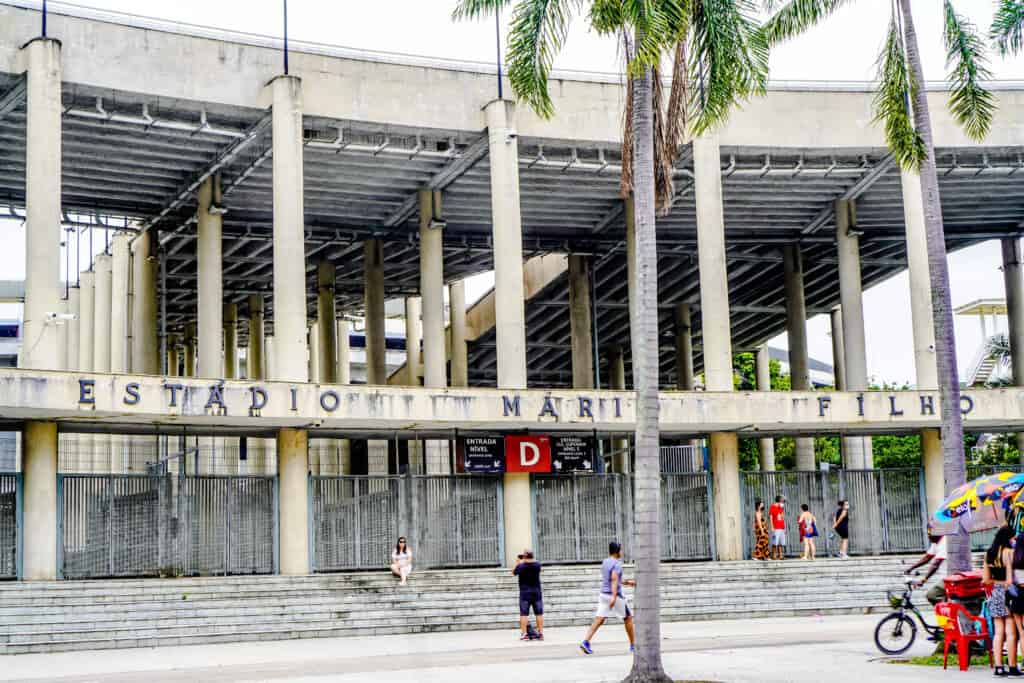
Selarón Steps : Known in Portuguese as “Escadaria Selarón” these world-famous steps began as a small project by Chilean-born artist Jorge Selarón to renovate the broken down stairs outside his house. This is a fairly recent project that began in 1990 and was completed in 2013. Selarón worked on the stairs until his death, and actually was found dead on the steps in 2013.

The stairs are located between the Lapa and Santa Teresa neighborhoods, which feature more heavily later in this itinerary. These steps are great for a photo opp – but I’ll caution that its MUCH better to visit this in the morning, as they will be full of other tourists later in the day.
Metropolitan Cathedral of Rio de Janeiro : Unlike most cathedrals around the world featured on city tours, this one is relatively new. It was constructed between 1964 and 1979 – which is also a really short time compared to other cathedrals. It was built in the architectural style of Mayan pyramids, and features beautiful (and huge) stained glass windows that are 210 ft tall.
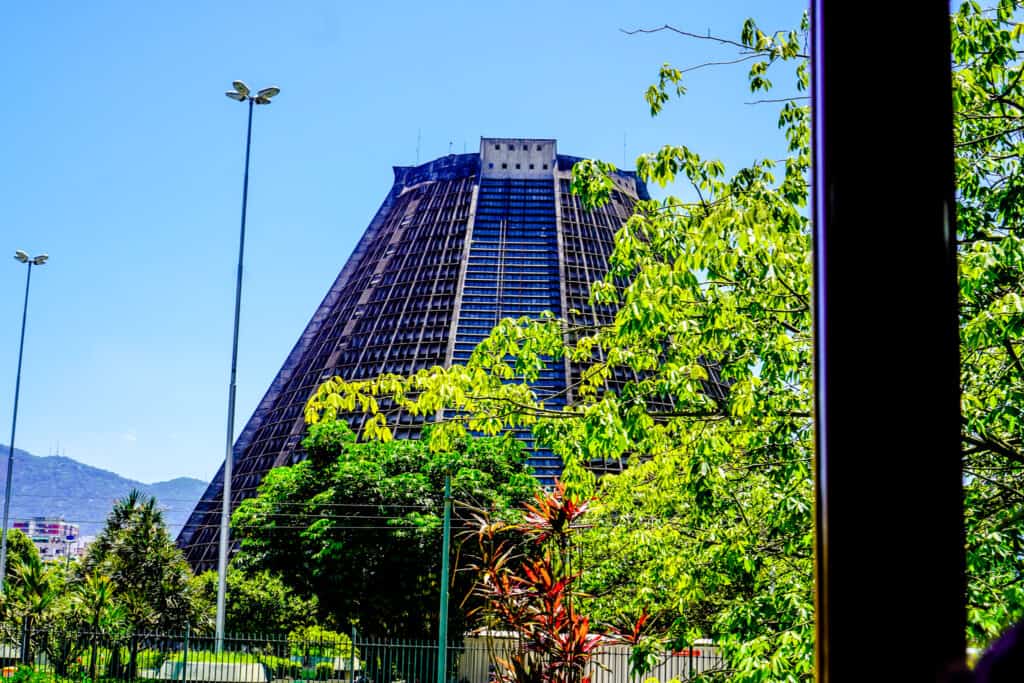
Sugar Loaf Mountain : Known as “Pão de Açúcar” in Portuguese, this mountain sits at the mouth of Guanabara Bay and has a height of 1,299 ft. To get there, you’ll have to take two cable cars, switching to a different cable car at the midpoint up to the peak. At the top, there are places to eat and drink, and of course, views that you cannot believe.

Rodrigo de Freitas Lagoon : This lagoon is in the Zona Sul (South Zone) of Rio. It is not a place to swim, but is used for events, such as a Rowing Stadium, at times.
If you are interested in seeing all of these sites, but do not want to coordinate yourself, I recommend checking out the Rio Highlights Tour , which provides transportation to all the sites above and includes lunch at a wonderful Churrascaria.
In addition, check out this post that covers 6 Rio City Tours for more ideas.
Book your Full-Day Rio Tour now!
In addition to the above, you may want to plan a Helicopter Tour of Rio , so that you can see all the sites from above. I found this experience to provide a unique perspective of this beautiful city.
Day 2 | Beach Day
On your second day in Rio, take a break and spend some time at the beach. Rio offers incredible beach culture, and the most common beaches include: Ipanema, Copacabana, and Barra de Tijuca. It’s pretty easy to get the food and drinks you need just sitting on the beach or by visiting the beach restaurants close by.
Just as a matter of safety, be sure to not carry too many valuables with you and be sure to keep an eye on your things at all times.
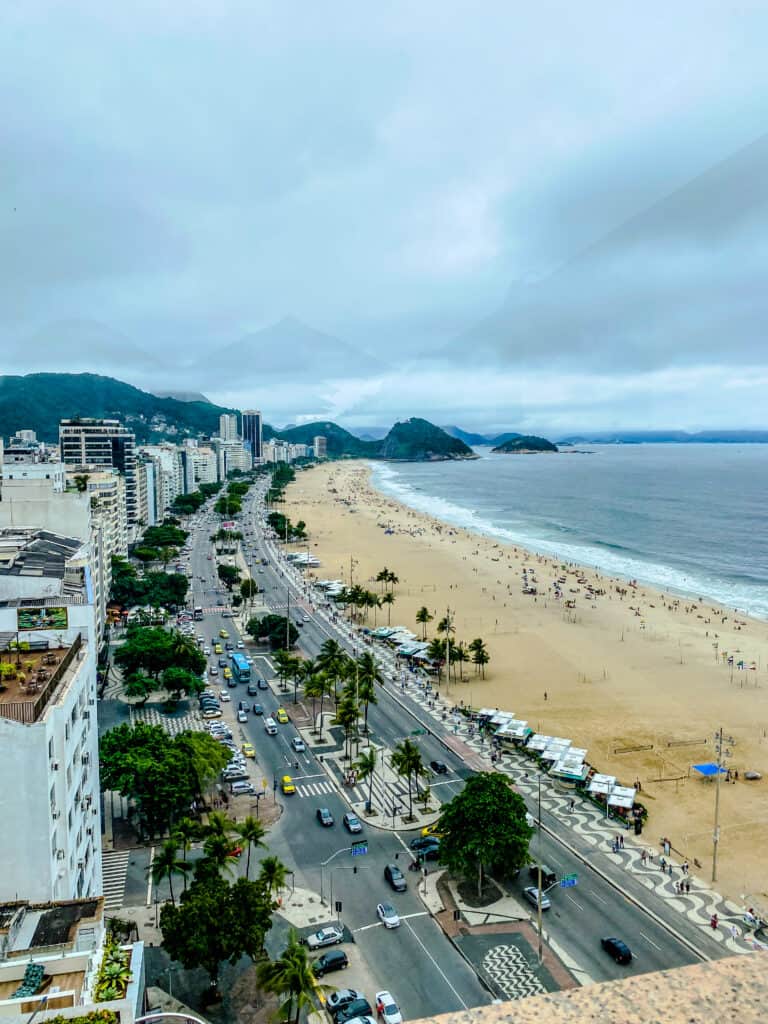
Day 3 | Explore Centro & Santa Theresa
Now, when most people think of Rio, they think of the most famous areas: Copacabana, Ipanema, etc. But most people don’t know that the city actually started in the area now known as Centro (City Center). This is what you would also consider as “Downtown Rio”. Something that makes Rio different than many other Latin colonial cities is that in the 1800s, city leaders opted to make Rio “modern” and destroyed most of the colonial buildings. So what you’ll find is a mix of French-inspired architecture from the 1800s and skyscrapers built in the 1900s.
While in the center, I recommend that you stop by the following sites:
Teatro Municipal: This is Rio’s opera house and is designed in an eclectic style. It features the French-inspired architecture mentioned above and is quite beautiful.
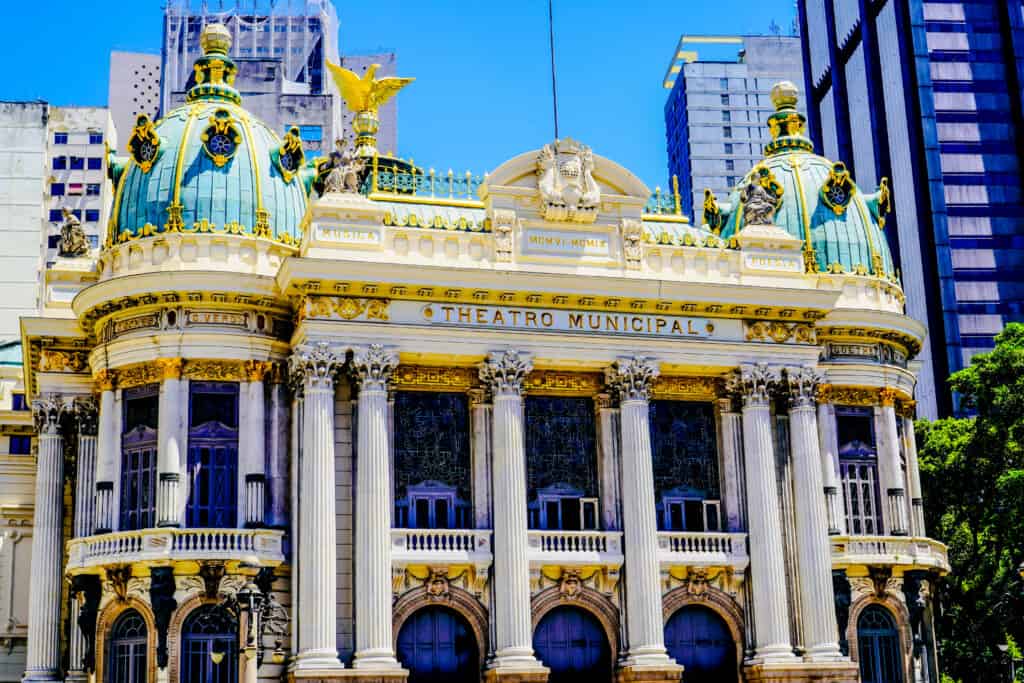
Carioca Square : This is a square that is right in the city center of Rio. As the Center is where a lot of “Cariocas” (i.e., people from Rio), pass through on their way to and from work.
Confeitaria Colombo : This is a coffee house that has become of one Centro’s major landmarks. It is a cafe that has European-inspired architecture, built by Portuguese immigrants in 1894. It is very grand, quite busy, and simply beautiful inside. Rightfully so, it has been listed as one of the most beautiful cafes in the world. Stop here for a nice break while exploring the city center.
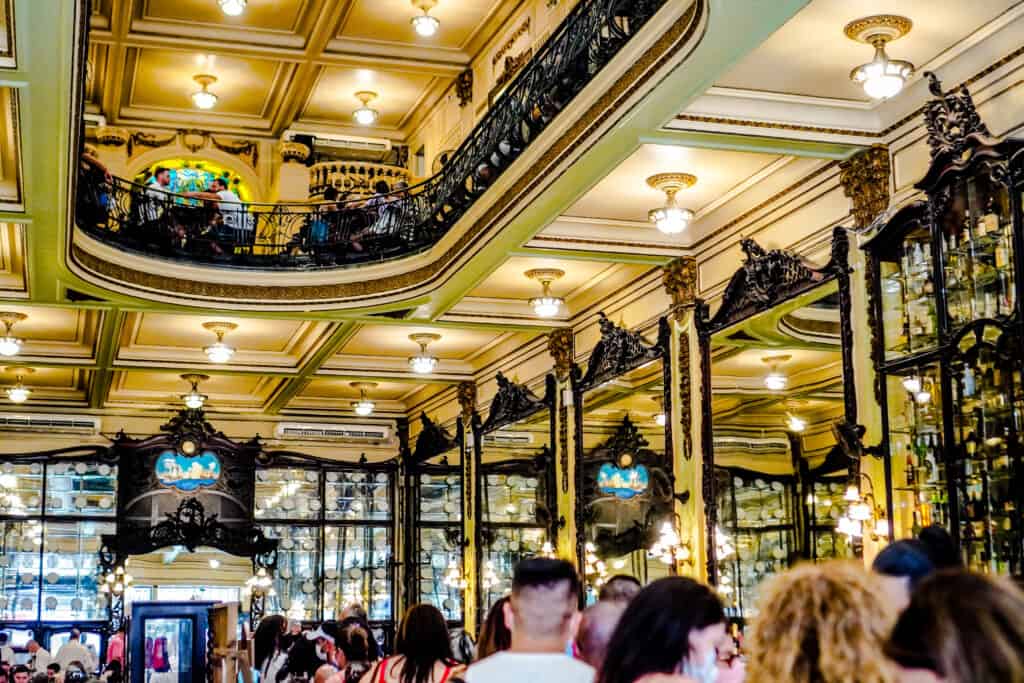
Paço Imperial: Known as “Imperial Palace” in English, this is the building that served first as the home to Brazilian governors and eventually as home to the royal family when they made Brazil the (temporary) capital of their empire. Compared to European castles, it is relatively humble, but was used given the surprise nature of the Portuguese court’s move to Brazil.
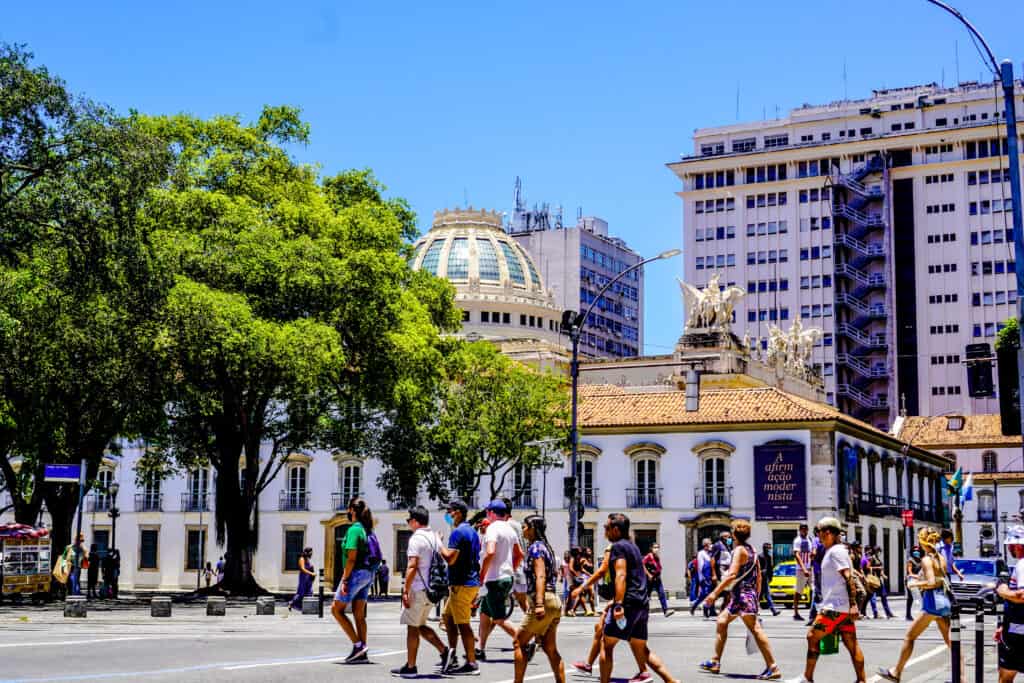
Capela Real do Rio de Janeiro : The name of this chapel translates to the “Royal Chapel”, which was built to organize religious events attended by the royal family.

Praça XV : Another famous plaza that is featured in the center of Rio.
You can visit all of these sites with Free Tours by Foot , which offers a variety of walking tours in Rio. Each of them with the option to “pay what you want”.
After your introduction to Rio, I recommend that you take the yellow tram from Centro to Santa Theresa . Santa Theresa is a lovely neighborhood that makes you feel a little like you are in a mountain town in California. The yellow tram goes for a loop and offers AMAZING views of the city below.
If you decide to stay in Santa Theresa, I recommend that you eat at Aprazível . It has a really nice indoor/outdoor setup and gives nothing but great views and excellent food. I do recommend that you make a reservation in advance as it is pretty popular.

You may also want to check out the following landmarks:
- Bar do Gomes (Armazémm São Thiago) : A bar/restaurant that gives you a feel of the local spots in the neighborhood.
- Parque das Ruinas : This is a public park that is built in the ruins of an old mansion. It was the former home of Laurinda Santos Lobo, who is known for inviting intellectuals and artists to her home in the early 1900s.
Day 4 | Explore the City Outskirts
Believe it or not, there is plenty of “jungle” left within the city limits of Rio. On your fourth day in Rio, I recommend exploring the beaches and natural environment on the outskirts of the city in the West Zone.
Now, this is something that would be very tough to navigate alone, so I highly recommend you go with a guide. The Sunrise + Secret + Wild Beaches Airbnb experience is one of the most unique ones that I have done, and really gave me a whole new perspective of the city. Explaining doesn’t really do it justice, so here is a little collage showing off some of the sights from the experience.
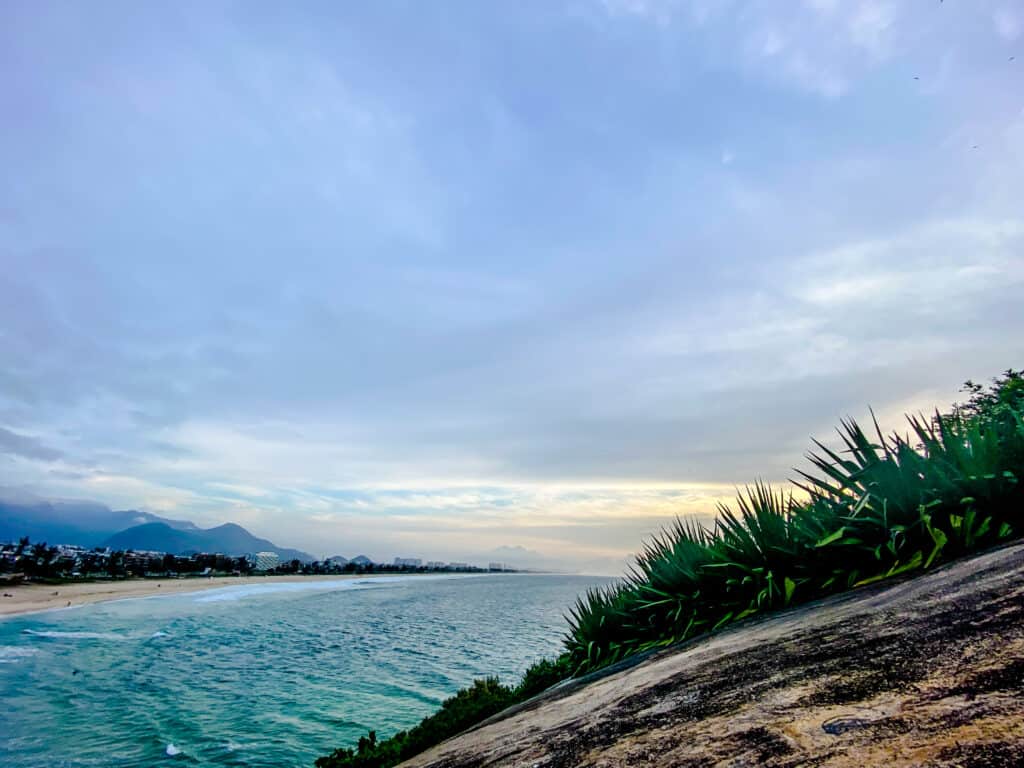
Another idea for this day would be to visit Ilha Grande, which is located off the coast of the city. This is a largely undeveloped island, that features lush vegetation and nice beaches. To get to Ilha Grade, I recommend you hire a tour to take you there. This Ilha Grande Tour from Ipanema includes lunch and a boat to get you around for the day as well.
Day 5 | Afro Brazilian History
Spend your last day in Rio getting to know a little more about the history and culture of the city. First stop – Little Africa. Also known as Pequena África in Portuguese, this area is located in the Port Region of Rio and has historically been home to a very prevalent Afro-Brazilian community. The moniker for the area came about after slave trade was outlawed in 1831. Over time freed slaves moved to this area to find work and a sense of community. The community provided food, shelter, a place to practice African religion, and gather with friends.
Pedra do Sal: This is the oldest continually inhabited black neighborhood in Rio, and as such has a very strong sense of Afro-Brazilian culture. It is the area credited with the founding of samba, Carnival, and Bassanova. This area may have also been the first place where democracy existed in the country, as the people of the community had their own government and voted on their leaders annually.

Cais do Valongo : This archaeological site was once Rio’s most active slave market. It’s estimated that 500,000 to 700,000 enslaved peoples from Africa were sold here from 1774 to 1831. Valongo was initially built to hide the slave market from Rio’s elite, and then when the slave trade ended, it was covered up to “hide” the remnants of slavery. It was not until 2011 that the market was uncovered to shed light and pay respect to the history of Afro-Brazilians.

Graffiti Wall Etnias : A few steps away you’ll find the Mural das Etnias. This is a beautiful painted mural on the side of a building that depicts indigenous people from a variety of countries throughout the world.

Museum of Tomorrow (Museu do Amanhã) : This is not part of the Afro-experience, but after seeing “Little Africa” I recommend checking out this museum. I did not get a chance to go on my tour, but have heard wonderful things about it. Please note that it is closed on Mondays.
Again, you can visit each of these sites with Free Tours by Foot . I definitely recommend you do this part with a guide, as they can add a lot of color to the history of the Afro-Brazilians here.
Note: If you crave more cultural experiences, I recommend you consider a Favela Tour during your time in Rio as well.
Salvador De Bahia
Salvador is a culturally rich area, and also home to the largest population of people from the African diaspora in the world. It has vibrant street life and is a bit lesser known by non-Brazilians as a tourist destination. In addition, it has plentiful beaches with warm waters and people who are just as warm as well.
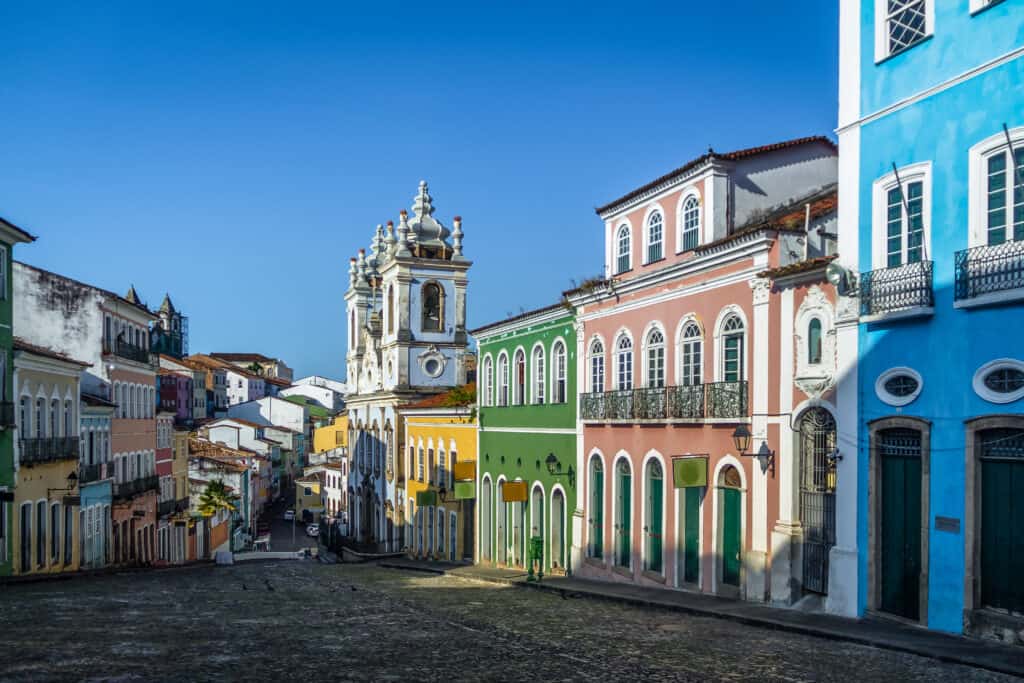
Full City Tour History & Panoramic
Experience the history and Afro-Brazilizan culture that make Salvador such a special place. Alongside a local guide, visit classic sites such as:
- Farol da Barra
- Cathedral Basilica of Salvador
- Elevator Lacerda
- …and many more!
Day 6 | Explore Pelourinho
After a morning of flying from Rio to Salvador, I recommend you start your time by staying in, and exploring Pelourinho. This area is full of colorful colonial architecture – something that I mentioned earlier is missing from Rio. A few sights that you should certainly see while in the area include:
Lacerda Elevator : This elevator connects the Cidade Alta (High City) with the Cidade Baixa (Low City), it’s a pretty cool experience to get at least one ride on this during your time there.
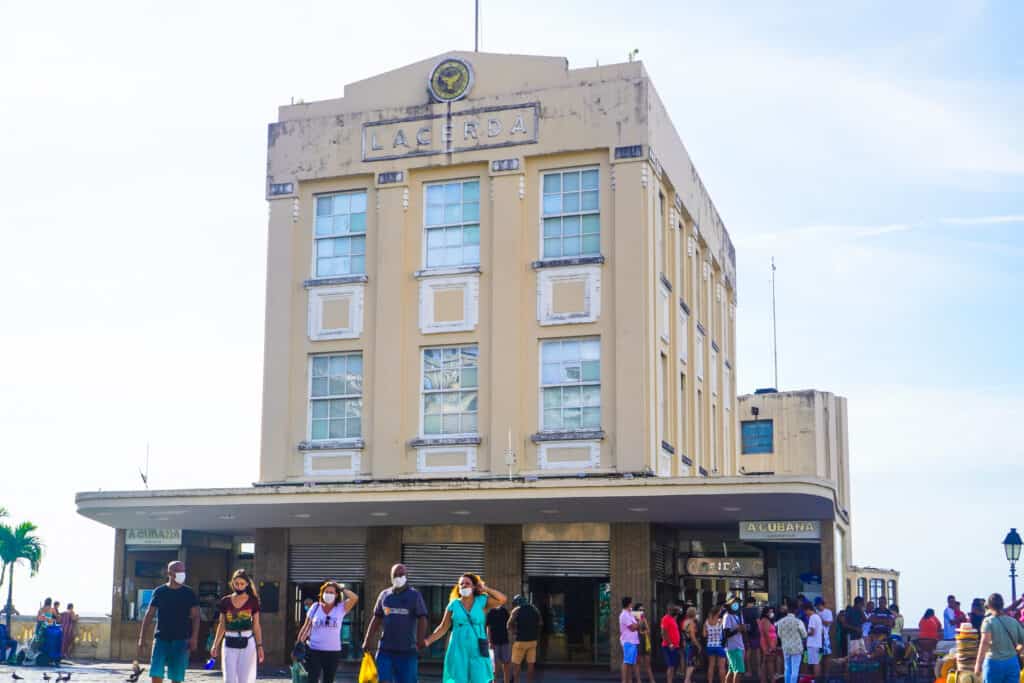
Mercado Modelo: This is a big market that you’ll see pretty much as soon as you exit the elevator to the Lower City. You can buy all the souvenirs your heart desires here.
Church of São Francisco : A lovely baroque church that is one of the best examples of this type of architecture in all of Brazil.

Palacio Rio Branco : This was the original seat of government in Brazil when the Portuguese first came to the area. It’s typically closed, but you can admire the architecture from the square.
Clube do Samba : Experience Samba with locals and travelers alike – they also offer great live music and good food.
Best Places to Eat in Pelorinho:
Cafélier: For breakfast, I recommend you stop at this café. It gives great views of the water and you can find many Brazilian classics on the menu too, such as pão de quejio.

Coco Bistro : This restaurant has great food. If you visit here, be sure to try the fish moqueca – it’s amazing! One of the best parts of eating here at night is getting a chance to watch all the action from your seat. Usually you’ll find live music or other shows right outside the door.

Day 7 | Explore Greater Salvador
On your second day in Salvador, I recommend you explore more of the larger state by getting out of Pelourinho. Here are a few sites that you should see:
- Praia do Porto da Barra : This beach is in the Barra neighborhood of Salvador, and is a popular spot for tourists and locals alike. The waters are calm and warm – which differs from the waters you find in Rio.
- Farol da Barra : This is the location of a fort and the first lighthouse in the Barra neighborhood. It’s a nice lookout point and a place to get a few nice shots.
- Basilica Do Senhor Do Bonfim: This basilica is best known for the colorful ties that those making wishes place outside the gates of the church.
- Dique do Tororo : This lake / natural water source for Salvador has lovely statues that represent the Orixás of Candomblé. If you are not aware, Candomblé is a religion that combines elements of African religion with catholicism. It is most revered in Salvador, given the large number of Afro-descendants. Around the area you’ll find a park with trails, nearby restaurants, an amphitheater, and colorful murals.
- Sorveteria da Ribeira : This ice cream shop has a wide variety of flavors, and given that it has been in operation since 1931, it is very popular with the locals.
- São Joaquim Market: This market provides plenty of fresh produce, fish, and meat, and in addition, there are a number of nearby restaurants on the water as well.

If this seems like a very long list, you might consider doing a Full-Day tour of Salvador. The Full City Tour Historic and Panoramic is a great option for this!
Book your Salvador City Tour Now!
Day 8 | Visit the Museums
On your third day in Salvador, I recommend you visit a few of the local museums – note there are a lot of options to choose from! Here are a few ideas:
- Casa do Carnaval da Bahia : This museum gives the history of Carnival in Bahia, and given that it’s know as being the best Carnival in the world, I’d say it’s certainly worth checking out. On the roof, there are impressive views of the Lower City and the ocean as well.
- Afro Brasileiro Museum : This museum is located inside the building of the first medical school in Brazil and is dedicated to the study and dissemination of African-Brazilian culture.
- Museum of Archaelogy and Ethnology : This museum is housed within the original Jesuit’s college built in the mid-1500’s. It sheds light on the history of the region and the people who live there.
- MAM Museu de Arte Moderna : This museum is housed within a 16th century colonial building and features contemporary art inside and a sculpture park outside.

If you end your day at the MAM, I recommend that you then go eat at Ré Restaurante Dona Suzana . The owner, Suzana herself, was featured in the Netfilx docuseries Street Food: Latin America . I do recommend you watch it because the story about her food and how she got story is just beautiful. Oh and the food is excellent – and so are the views from the site!
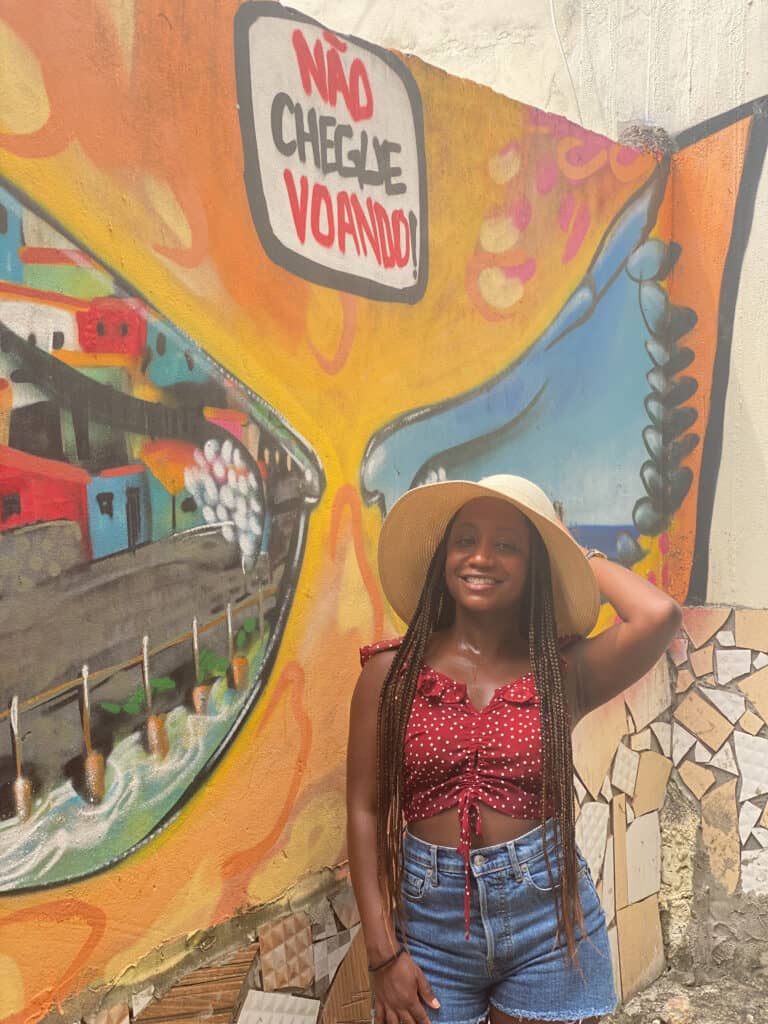
If you have time, there is also a beach directly behind the MAM, which is more of a local beach. But a good find if you want a more chill experience.
Praia Do Forte is a beach within the same state as Salvador – Bahia – that also has a small village. The waters you find here are crystal clear and full of natural pools that make for a very relaxing experience. The area is known for the eco-resorts and the plentiful shopping there as well.
Day 9 | Praia Do Forte
Take the drive from Salvador to Praia Do Forte by car. It’s about a 1.5 hour drive or so, which is not bad. I recommend hiring a taxi to take you there if you haven’t rented a vehicle, as the price is pretty reasonable. Here is a link to do just that here: Transfer from Salvador to Praia Do Forte .
On your first day there, just spend time at the beach. As I mentioned before, the waters are lovely. And if you just sit at the beach, there will be plenty of folks walking by to sell you all the food, drinks, and snacks you need for the whole day.
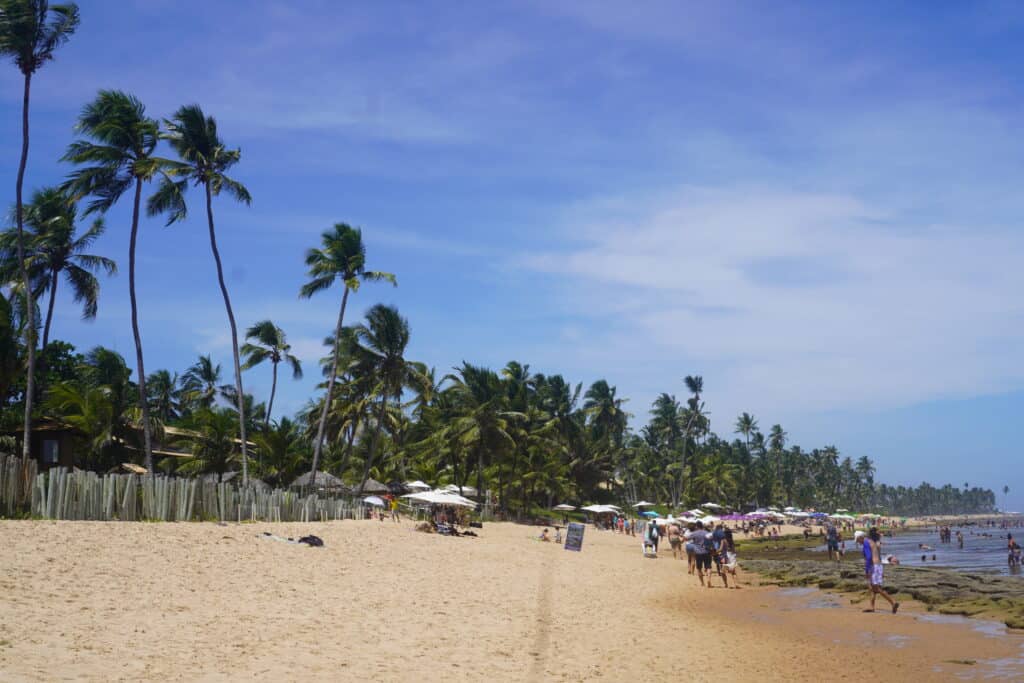
Day 10 | Praia Do Forte
Spend your second day at Praia Do Forte visiting TAMAR, which is a site meant to protect endangered sea turtles. Then spend a bit of time shopping, if that is your thing :).
From there, head back to the Salvador airport to make your way back home.
What to Do if You Have More Time in Brazil
If you are staying in Brazil for more than ten days, I there are some additional sites that you may want to visit:
Iguazú Falls / Iguazú National Park: Iguazú Falls consists of waterfalls that fall directly on the border between Brazil and Argentina. It is the largest waterfall system in the world! If you are interested in natural beauty, this should certainly be on your list.
São Paulo : This city is the most populous in all of Brazil, and located in the Southeast Region of the country. Contrary to popular belief, there is no beach located in the city, but it’s been described as comparable to New York City with the variety of things there are to do there.
Amazon Rainforest : The western side of Brazil is actually quite sparsely populated as the Amazon really still reigns as king there. There are a variety of excursions that you can take to experience the rainforest (safely) while visiting Brazil. Here is an example tour for your reference: Amazon Jungle from Manaus .
Ouro Preto : This city, whose name means Black Gold in English, sits in the state of Minas Gerais. It is a former colonial mining town for all the gold once found there. It is a town that feels fixed in time, with well-preserved colonial architecture.
For additional posts on traveling Latin America, click here !
Brazil FAQs
To get a taste of Brazil’s highlights, a minimum of 10 to 14 days is recommended. This duration allows you to explore major cities, visit iconic landmarks, and experience the country’s unique culture. For a more in-depth exploration, a longer stay of 3 to 4 weeks or more would be ideal.
Brazil can offer a range of travel experiences, and its affordability can vary depending on the region and activities. While some areas can be relatively affordable, major tourist destinations may be more expensive, especially during peak seasons. With careful planning and budget-conscious choices, it is possible to have an enjoyable and relatively affordable trip to Brazil.
The best time to travel to Brazil depends on your preferences. Peak tourist season is during the summer months from December to February, but it can be crowded and more expensive. Consider visiting during the shoulder seasons of spring or autumn for milder weather and fewer crowds, or the dry season from June to November for better wildlife sightings in the Amazon rainforest.
Americans can visit Brazil for up to 90 days for tourism purposes without a visa. This is part of Brazil’s visa waiver program for several countries, including the United States. However, it’s crucial to check for any updates or changes in visa requirements before planning your trip.
Final Tips | Brazil Itinerary 10 Days
If you plan to visit Brazil, I am sure that you won’t be disappointed. It’s a great place with plenty to do and see, and I simply cannot wait to get back there. As a recap, this itinerary recommends the following:
- 5 Days in Rio
- 3 Days in Salvador
- 2 Days in Praia Do Forte
Bahia is often not at the top of folks’ lists when they think of visiting Brazil, but I do think it’s worth the visit (or many). If you have visited Brazil before, let me know in the comments below!

Related Brazil Posts:
- Best Rio Helicopter Tours
- Best Rio Favela Tours
- The Best Things to do in São Paulo
- Rio de Janeiro Trav el Guide
- Best City Tour of Rio de Janeiro
Additional Latin American Posts:
- 4 Days in Puerto Rico
- 4 Days in Tulum
- Havana to Varadero
- 1 Week in Cuba
- Where to Eat in Havana
- Muyil Ruins
- 4 Days in Lima
Christen Thomas is the founder of TravelWanderGrow, established in 2018. She has lived abroad and traveled extensively to over 30 countries. In addition, she is a certified Travel Advisor and is an expert in planning trips focused on city history and culture. As a frequent traveler, she also shares tips on how to prepare to travel well and how to save money while doing so.
Leave a Reply Cancel reply
Your email address will not be published. Required fields are marked *

Two Week Trip to Brazil Itinerary for Any Traveler
We always knew that planning a trip to Brazil would be a challenge. Officially the 5 th largest country in the world, we knew that it wouldn’t be possible to fit in everything on one trip. Instead, we chose to approach our Brazil itinerary with a focus on some spectacular highlights.
I have to admit; this was a hard approach for me. Brazil has been on my travel wish list for so long, I was incredibly tempted to spend my time jetting around frantically to see as much as possible. Long story short, I am glad I didn’t.
Brazil isn’t a place that you should rush through. It’s a place that you need to take your time in, uncovering all the things about it that make it special. You know, all those things that made you want to visit in the first place.
Looking back, choosing to travel the country in a total of 3 weeks in one region was the best decision we made. It was not only the perfect introduction to a country that is incredibly diverse but it also whets our appetite for a return visit.
Don’t leave home without: Lonely Planet Brazil (Travel Guide)
Putting Together a Trip to Brazil
Table of Contents

While it is possible to travel through Brazil independently, and plenty of people do, we highly recommend seeing Brazil on a tour, as we did.
Most of the experiences listed here are highlights from our Wonders of Brazil tour with G Adventures.
If you’re considering taking a tour in Brazil, this outline will give you a look into the experience you could have by booking this tour.
Taking a tour for our first visit not only helped us set the pace for a great trip but kept us on track instead of tempting us to divert from a plan to explore other areas.
The itinerary we experienced was specifically designed to introduce us to the diversity that Brazil offers.
Disclosure: This tour was in partnership with G Adventures and was provided to us as part of our involvement as G Wanderers .
If you’re planning to visit Brazil independently, this guide will give you a good starting base for where you can go and how you should pace yourself for a great visit.

The Perfect First Time Brazil Itinerary
Rio de janeiro – we recommend one week.

If you’re a nature buff, like me, you’ll find it easy to fall for Rio de Janeiro from the moment you step off the plane. The city is set right into lush jungles that push toward the ocean. It’s one of the most beautiful cities I have ever laid eyes on.
I never really understood why most of the people that you talk to about travel to Brazil chose to only spend their time in Rio de Janeiro.
Now that I have been there, I totally get it. This city is addictive and provides an incredible base for endless options of exploration.
We ended up spending a week in total in this magical city, which officially brought our Brazil itinerary to 3 weeks when combined with our two-week Wonders of Brazil tour with G Adventures.
We did a lot but barely scratched the surface of all the wonderful things to do in Rio de Janeiro .
Between the intense Portuguese colonial history that forever shaped the tone of Brazil to the haunted past of the slave trade, Rio de Janeiro is a city with a soul and intriguing history around every corner.
Things we did in Rio de Janeiro:

- City Tour: Taking a city tour to see the iconic sites. You simply cannot visit Rio de Janeiro without visiting Christ the Redeemer, Sugar Loaf Mountain, Selaron Steps, Santa Teresa and the Metropolitan Cathedral of Saint Sebastion.
- Enjoying the beaches: The song ‘The Girl from Ipanema’ enters my head immediately whenever someone asks me about Rio’s famous beaches. Yes, we visited the likes of Copacabana, Ipanema and yes, they are spectacular. Brazil has a beach culture unrivaled by any other place we have been to and you need to experience it on a visit.
- Helicopter Ride: We soared over the city in a spectacular doors-off helicopter ride. Choosing to go just before sunset gave us some pretty amazing light and incredible views of Rio’s famous beaches, Christ the Redeemer and more.
- Favela Tour: Learning about the Planeterra projects that have been implemented in Vidigal with an intimate favela tour. While favelas are often the center of media, mostly for crime and violence, we seem to overlook that they are their own thriving communities. Our tour introduced us to what like is like inside the favela for the people who live there and how they are working to preserve their corner of the city that they call home.
- Samba Tour: Learning about Samba is a rite of passage for any visitor to Brazil. We didn’t even hesitate to book a new tour offering in the city called, Soul of Samba, where we introduced to the complete history of Samba music through an interactive tour around Rio de Janeiro. The tour included stops in the downtown historic district, a behind the scenes experience at the City of Samba to learn about Rio’s famous Carnival and more street art than you could imagine existed in one place. This was hands down our favorite tour in the city.
- Hang Gliding: Rio de Janeiro is world-famous for hang gliding and you can bet we made a point of trying it out for ourselves. There really is nothing as exhilarating as hurling yourself off a mountain while watching the stunning topography of forest, beach, and city unfold below you.
- Landscapes Tour: If you’re into photography, this tour is fantastic for getting you to as many vantage points of Rio de Janeiro as possible. It navigates all around Guanabara Bay providing different perspectives of the city.
- Attend Carnival Festival: We planned our tour so that we would be back in Rio de Janeiro in time to attend the impressive Parade of Champions at the Sambodromo. We splurged for box tickets, which gave us front row seats to one of the most spectacular parties we have ever been to in our lives.
Where to stay in Rio de Janerio
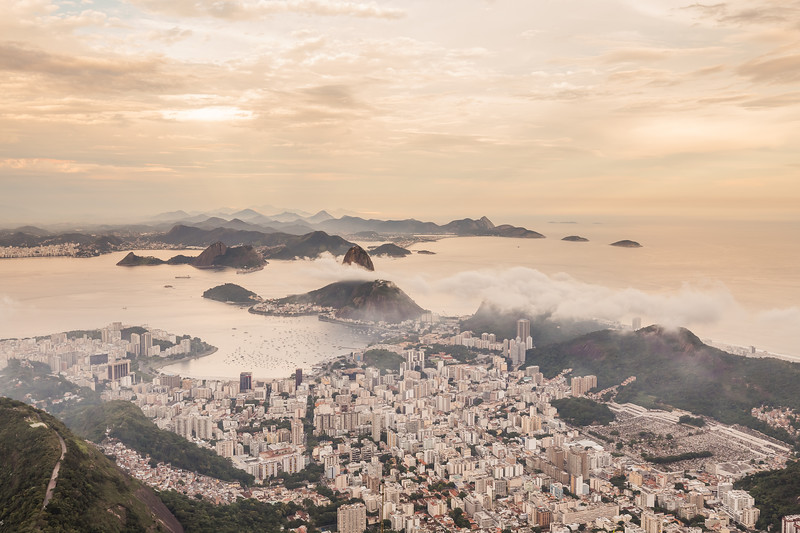
The most obvious choice is Copacabana and for good reason. This area is largely developed and caters well to an international market. There is a large variety of shops, restaurants, hotel options, and infrastructure.
The only downside is that it is one of the pricier areas. That aside, along with Ipanema, I also think it is the safest place to base yourself during your stay in Rio de Janeiro.
We stayed at the Royalty Rio Hotel for the duration of our stay in Rio both before and after our tour with G Adventures. The hotel is well located and comfortable.
Other districts to consider include Ipanema, Centro, Santa Teresa and Botafogo.
Ilha Grande – 2 Days
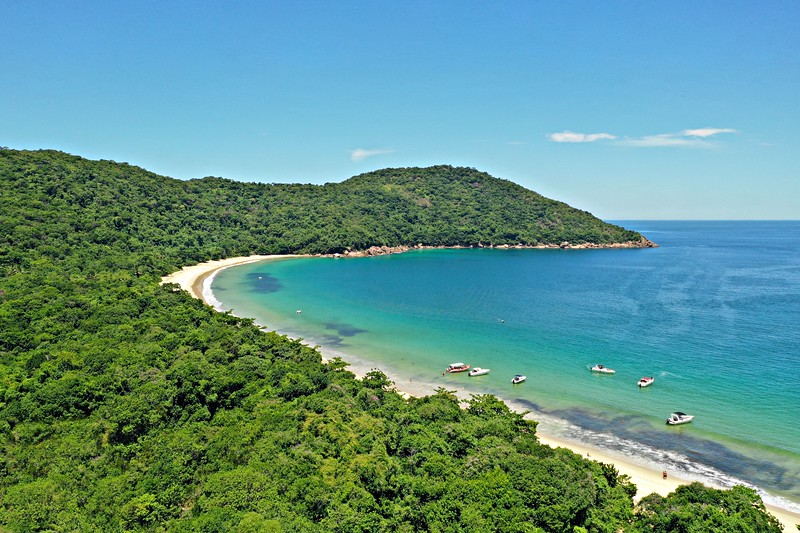
The island paradise of Ilha Grande was a pleasant surprise on our Brazil itinerary. Untouched by development, at least of the modern and expansive kind, this island harkens to the vacations of old.
With no roads, no vehicles and no high rises, you’re left to experience the lush island and magical beaches without distraction. Heck, WIFI was even a rare commodity during our visit.
Instantly reminding me of Gili Trawangan in Indonesia, the first thing I said out loud was that I wished we were staying longer.
There are so few places in the world like this today that when we find them we want to stay and enjoy them.
If you have flexibility on your side, then you should definitely consider spending a few extra days on this island. In my opinion, you cannot travel to Brazil without making a stop here.
Read more Ilha Grande, Brazil: Ultimate Planning Guide
Things we did in Ilha Grande:

- Island Speed Boat Tour: We spent an entire day beach hopping around the outside of the island. We had access to places that you wouldn’t otherwise be able to reach and with the weather on our side, we were even treated to the often inaccessible ocean side of the island. I highly recommend it if you like quaint places and spectacular beaches.
- City Walk: The main ‘town’ on Ilha Grande is not large but does have some interesting things to check out. They have a square, small church, artisan market, ocean walk, and several storage options. In addition, you’ll have a chance to browse the many restaurant options.
Where to stay in Ilha Grande

Apart from very few homestay options in other parts of the island, you will find accommodation options for all budgets in the main town. Everything is within walking distance from the main pier.
If you have luggage that you cannot move on non-paved streets, there are several ‘luggage porters’ available on the pier that will take your bags to your accommodation when you arrive.
The cost is $5 and that includes return transfers of your luggage when you leave.
We stayed at the Pousada Bugio , a small eco-friendly place located on one of the back streets. While not in the thick of the action, we enjoyed that it was very quiet.
There was a small supermarket across the street to buy snacks and it was a short walk to the main street on the beach.
Paraty – 2 Days

Set on the coast, the town is also backed by lush forests making it the perfect base to combine island hopping, jungle trekking and history on your trip to Brazil.
Time has stood still in this charming colonial town where you can stroll the streets and marvel at the Portuguese architecture that was constructed in the late 1500s. Serving as a base for the Portuguese, this city has survived the rise and fall of gold, coffee, and slavery.
Designed in classic colonial style, the streets form a massive grid of cobblestoned streets that make navigation easy. What sticks out the most is the colorful doors and small artisan shops.
Be sure to have your camera ready as you roam, there are photo opportunities at every corner.
Read more Paraty, Brazil: Ultimate Planning Guide
Things we did in Paraty:

- Island Hopping Cruise: One of the most popular things to do in Paraty is to go island hopping my schooner. Being located directly on the water, the marina gives you access to hundreds of islands and beaches on a day trip. Most trips stop at 3-4 islands and offer beach landings, snorkeling, and onboard lunch options,
- Jeep Tour: Heading off for a day of exploration in the Serra de Bocaina National Park, this ended up being our favorite day trip in Paraty. The tour takes you into the surrounding forest where you explore waterfalls, hike in the forest and visit a couple of Cachaca distilleries.
- City Tour: Every day you have the option of joining a free walking tour of the city that leaves from the main square. You’ll visit the churches of the city, have iconic buildings pointed out and learn the history of the city over 2 hours. Tours depart daily, except Wednesdays, at 10:30 AM and 5 PM, rain or shine.
- Samba da Benção Street Party : Every Monday night around 8 PM, the locals gather in the main square of Paraty to dance the Samba. Unique to Brazil, Samba is infused with heave African rhythms and accompanied by dance moves that will leave you in awe. Don’t let that deter you though! Everyone is encouraged to dance and party into the wee hours of the morning. Just be sure to drop a donation in the hat when it comes around.
Where to stay in Paraty

With the city being so walkable, there really isn’t a bad place to stay. That being said, our accommodation was located outside of the historical center.
With the city being a focal point for visitors, the streets can be crowded and loud. So while we were at first not thrilled about the location of our pousada, we learned that it was actually the perfect solution.
We stayed at Refron du Mar Pousada Paraty , located right on the beach and just outside the historical center where we were able to get away from the busy streets when we were done exploring.
This pousada was very clean and set up like a colonial courtyard with the rooms located just off a large open-air central area.
Iguazu Falls – 2 Days

The amazing natural wonder is all you have ever dreamed it would be, and more. Set in some of the lushest forests we have ever seen, these falls open the forest with huge clouds of mist.
It is easily one of the most exotic places you can visit in the world and a sheer testament to the power of nature.
The falls are accessible from both the Argentinian and Brazilian sides, both of which we recommend you taking the time to experience. Besides gawking at the falls, there are a number of activities to do as well.
Things we did in Iguazu Falls:

- Visit the Brazilian Side: The Brazil side is comprised of a beautiful park with a long walking trail that skirts the falls. Along the trail, you’ll come across various viewpoints that overlook the water, as well as the opportunity to see some wildlife.
- Visit the Argentinian Side: From Argentina, you’ll have a completely different perspective and a variety of trails that will give you every vantage you can imagine, including walkways that take you straight into the spray zone. As with the Brazil side, the wildlife is plentiful and there is even a tourist train to help you access the hiking paths.
- Helicopter Ride: From the Brazil side, you have the option of taking a scenic helicopter flight over the falls. While the view is stunning, it is not a good flight for photography. It lasts about 15 minutes and they put 7 people in the helicopter, making it hard to see much.
- Skydiving: Yes, you can skydive over the rainforest. While you won’t be jumping out directly over Iguazu Falls themselves, you will have an incredible vantage point of the area. Not to mention an adrenaline rush.
- Speed Boat Under the falls: If you do nothing else during your time at Iguazu Falls, then do this. After boarding an inflatable speed boat, you will be taken upriver and right to the base of the massive falls. Just seeing them from below is impressive but the fun gets started them they bring you in close for a total soaking.
Where to stay in Iguazu Falls

With Iguazu Falls being a now booming tourist stop on people’s routes around South America, it is no surprise that the towns on both Argentina and Brazil sides have been built up to support the influx.
We stayed on the Brazilian side and found the city to be very modern with lots of hotel and restaurant options.
Our stay at the Hotel Del Rey was very comfortable. Centrally located, it is within easy access to many of the best restaurants in the city. It also features onsite dining and a rooftop pool area.
Bonito – 2 Days

Beautiful, natural, wild Bonito. No longer much of a secret, this is where you go to see some incredible natural wonders in Brazil.
Boasting an insanely clear river system, you can have the adventure of your dreams here through snorkeling and cave exploring.
The city itself is very small and built exclusively for tourists. Looking around from there, all you can see if retired farmland. But don’t let that deter you.
Outside of town is where all the wonder is, so don’t sell yourself short by not participating in any tours.
Read more Bonito Brazil: Ultimate Planning Guide
Things we did in Bonito:

- Snorkel the Rio da Prata: Hands down the best site to visit is this famous river. Known for its sparkling turquoise waters and ultra-clear visibility, this is the adventure you cannot miss. Snorkeling trips here are guided and regulated, meaning you should make your reservations well in advance of visiting. Showing up without a booking is not a good idea, as these tours often sell out months in advance.
- Gruta Azul: There are many caves in the Bonito area that are worth checking out but if you only have time for one, I would recommend going to Gruta Azul. Your visit will involve some walking through the rainforest before reaching the cave entrance, in which you will then begin your walk down into the cave. There are many stairs but the vibrant blue pool at the bottom is worth the effort. Something to note, you are not allowed to swim here, just enjoy the natural splendor. What makes Gruta Azul interesting is the discoveries that have been made here, including a Giant Sloth and Saber Tooth Tiger.
Where to stay in Bonito

There isn’t much to the town of Bonito. It literally exists as a place for tourists to base while exploring the natural wonders of the area. It’s a one-street town with a reasonable amount of accommodation and dining options.
We stayed at Muito Bonito which is like stepping into a tiny oasis. The hotel is like a tiny resort complex with great gardening and natural buildings.
At the center of the property is a wonderful pool with a bar. The rooms were comfortable, had A/C and internet access.
Pantanal – 2 Days

No trip to Brazil would be complete without a visit to the Pantanal. Officially the largest wetland in the world, roughly the size of France, the Pantanal is bursting with wildlife and adventure opportunities.
I have to say that 2 days is nowhere near enough time to experience all that this region of Brazil has to offer. We got a small intro taste on our first trip to Brazil, but I am going to level with you.
I think a solid week would be more appropriate and you would need to fly into the very middle to get the best experience possible.
If you are looking to view Jaguars, something that is very realistic and possible in the Pantanal, you will have to do just that.
Your chances of having a sighting at the southern part are possible but very rare. Keep that in mind to manage expectations.
Read more Pantanal in Brazil: Ultimate Planning Guide
Things we did in the Pantanal:

- Bushwalking: There are few ways to get up close to an area than on foot. Accompanied by experienced guides, we set off into the wetlands on foot in search of wildlife and exotic flora. During our bushwalk, we observed several species of birds and blazed our own paths through the thick forest. I wouldn’t recommend trying this without a guide who knows the area and be sure you’re prepared for the heat and insects.
- River Boat Trip: Some of the best wildlife sightings are often done by water, so be sure to get into a boat during your visit. We cruised up and down the main river near our Pousada and found a fantastic opportunity for viewing birds and reptiles.
- Piranha Fishing: If you’ve ever dreamed of pulling Amazon’s most vicious fish out of the water than this is for you. With the help of the guides, you’ll drop traditional stick pole lines into the water, baited with fresh meat, and try your luck at fishing. The best part, whatever you catch can be cooked for lunch that day too.
- Bird Viewing: The Pantanal is a bird lovers paradise. I’ve never seen such a high species concentration of birds in one place, ever in my travels. From the exotic species of macaw and parrot to the smaller songbirds, they were everywhere. Truth be told, we easily spotted 50 species of bird in our 2-day visit.
Where to stay in the Pantanal

Our particular itinerary visited the southern tip of the Pantanal, closest to Campo Grande. This location is a perfect little property that offers two styles of accommodation based on budget.
Pousada Santa Clara is owned by a local farmer’s family and offers the full spectrum of transportation into the lodge, accommodation, meals, and excursions during your stay.
You can either stay in the more rustic riverside area, where there are hammocks and dormitory-style sleeping options or you can opt for the boutique-styled main property. This option features private rooms, A/C, internet access and a pool.
We split our time between the two options and have to say they were both great. The riverside camp has totally screened-in areas so you experience little to no insects. There are also basic restroom and shower facilities.
Attending Rio Carnival

Carnival in Rio is literally the biggest festival in the world. If you travel to Brazil around this incredible time, we recommend that you take some time to attend this spectacular festival.
Spanning an entire week, there are many things to see and experience as part of the festivities.
This includes street parties, private parties, concerts, competitions, and parades. It is a full-on immersion into Samba.
If your trip to Brazil is during the time period that coincides with this major festival, you will see sprinklings of it throughout your travels, even in the smallest towns. However, the heart of the celebration happens in Rio de Janeiro.
Want to party it up for Carnival but don’t want to do it alone? Check out this unique 6-day tour that explores the Carnival festival for the full duration.
If full-on partying for a week isn’t your thing, have a look at when the Parade of Champions will take place and book your tickets for that.
This will give you an intimate look at the best Samba schools in Brazil. It’s a unique experience that you shouldn’t miss.
Hot Tip: Book your tickets to any of the Carnival events as far in advance as possible. Prices skyrocket the closer you get to the events.
Tips for planning your Brazil itinerary
Best time to visit brazil.

Like most tropical places, Brazil really has two seasons, wet and dry. However, the length of these seasons can vary greatly depending on the region you are visiting.
High season is experienced when the Brazilians are on vacation, coinciding with the countrywide celebrations of Carnival. This period generally extends from December to March and also includes July.
During this time, pricing will be high and many of the popular places will be crowded.
Weather in Brazil can be observed as follows:
- Fall (March-May) and Spring (September-November) offer comfortable temperatures and not much rain. Ideally making this the best time to visit.
- Summer (December – February) is very hot and very crowded. Despite the heat, it is also the height of the rainy season. This brings a healthy population of insects.
- Winter (June-August) offers cooler temperatures and way fewer people in the country. It is also much drier. If you want to see jaguars in the Pantanal, this is when you want to go.
Getting around Brazil

As we mentioned before, apart from the week we spent in Rio, we spent two weeks on tour with G Adventures. Their tour includes all transportation, which was a mix of mini-buses, coaches, boats, and planes.
If you are planning to travel to Brazil independently, you will get around the country in much of the same manner.
The country supports an extensive bus system that connects most places. If you have a bit more budget and less time, flying is a good option too.
Local flights are provided by LATAM and Avianca. It is also possible to work with a travel agency to book on ground travel in advance.
Renting a car is also an option that people choose to do in Brazil. There is an extensive network of well-maintained roads in the southeast, so traveling between all of the places in this Brazil itinerary is possible by rental car.
Keep in mind that Brazil is HUGE. What may look like a short distance on a map can often take a full day to traverse on land.
Be sure to double-check distances with Google Maps and factor in time for traffic and stops when calculating commutes.
Costs & Budget

The official currency of Brazil is the Real ( pronounced as ree-al ). We recommend planning to withdraw local currency from the ATM instead of exchanging cash. This will ensure you get the best rates and pay fewer fees.
Major credit cards are widely accepted at most hotels, shops, and hotels. We were able to pay for most tours with a credit card as well.
We found Brazil to be quite expensive when compared to the likes of Peru, Ecuador , and Colombia.
It was more on par with what you would experience in Argentina or Chile . Something to keep in mind when budgeting for your trip.
Getting a Brazil Visa

One of the reasons we put off a visit to Brazil for so long was the extensive process in place to obtain a visa. It used to be that US citizens would have to apply for a visa through a physical embassy in the USA.
This required extensive paperwork and having to mail in our passports for several weeks. The process was not easy and not cheap.
In 2018, Brazil changed this policy to e-visa, meaning that you could apply for a visa online and it only cost $45. This is what we did and the process was very easy to complete.
As of June 17, 2019, citizens of the USA, Canada, Japan, and Australia will no longer need a visa to visit Brazil. This is exciting and will open up Brazil in a way that it has never been before for travelers.
If you’re planning to travel to Brazil before June 17, 2019, you will still need to apply online as we did. The process is easy and straightforward.
You’ll be asked to complete an application, upload a copy of your passport and a photo (pay attention to the spec requirements) and then pay the $45 application fee.
You can expect to receive your visa, via email, in less than a week.
Safety in Brazil

This is a widely discussed topic by most people planning to visit Brazil. While there are currently no nationwide security advisories in effect for Brazil right now, it is important to recognize that Brazil is a place where you should exercise caution.
Much like other countries in South America , it is important to remain vigilant at all times when out exploring, especially in the bigger cities.
To be honest, I was terrified to walk the streets of Rio de Janeiro. I had read so many horrible things that I almost let it ruin my time there.
Turns out, if you follow your instincts, act smart and don’t flaunt anything fancy, you can have an amazing time without any worries.
Some tips for keeping yourself safe in Brazil:
- Always be aware of your surroundings. I am not saying to be paranoid but keeping your head up and eyes open will go a long way to keeping you safe and less of a target.
- Do not carry your phone on the street. You will see locals doing this but don’t do it. Thieves target tourists and are masters at easily picking your phone out of your hand.
- Do not leave your purse or phone on the table or hanging from a chair at a restaurant.
- Avoid empty or poorly lit streets.
- Do not go out alone, always take someone with you.
- Do not carry excess cash or debit cards with you.
- Leave your passport in the hotel.
- Lock up everything in your hotel room. They provide a safe for a reason, use it. Put away all valuables before going out for the day, including laptops.
- Know where you are going before you leave so you can walk with purpose.
- Do not leave anything unattended while enjoying the beaches.
Most of the crime against tourists in Brazil is petty. Meaning they are after your things and not your life. Don’t be a hero, if you have an encounter, give up the item and move on.
First Time Tips

- I’ve said it before and I will say it again, Brazil is huge and diverse. Do not underestimate this.
- You will be tempted to see as much as possible on your first trip to Brazil. Fight that temptation and plan your itinerary in a practical way. Pick a region and stick with it. This will allow you to enjoy the places you visit instead of spending your whole vacation moving between places.
- To truly maximize your time, it is best to fly between places. This will cost a lot more money, but you’ll have more time in each place you visit.
- Book all of your flights well in advance for the best rates and options.
- Also, book all of your accommodation in advance. Especially if your trip to Brazil is in high season.
- Purchase travel insurance . Not only does this protect your investment, but it will also cover any items that may go walking.
More on Brazil:
- 40 Bucketlist Things to do in Rio de Janeiro
- The Best Favela Tour in Rio: Defeating the Stigma
- Ilha Grande, Brazil: Ultimate Planning Guide
- Paraty, Brazil: Ultimate Planning Guide
- Bonito, Brazil: Ultimate Planning Guide
- Pantanal in Brazil: Ultimate Planning Guide
- 16 Amazing Things to do in Brazil
Did you like this story? Share it!
Travel planning resources, about lina stock.
Lina is an award-winning photographer and writer that has been exploring the world since 2001. She has traveled to 100 countries on all 7 continents. Member: SATW, NATJA, ATTA, ITWA
1 thought on “Two Week Trip to Brazil Itinerary for Any Traveler”
Superb post, we enjoyed each and everything as per written in your post. Thank you for this article because it’s really informative, I love reading your blog.
Leave a Comment Cancel reply


Solo Travel In Brazil: The Ultimate Guide (With Map!)
By Christen Thomas. This guide to traveling alone in Brazil contains affiliate links to trusted partners!
Are you interested in solo travel in Brazil , but need some help with the planning?
Then you’re in the right place!
If you are dreaming of dancing to the rhythm of samba, hiking through lush rainforests, or immersing yourself in a vibrant culture, Brazil should be at the top of your list.
Traveling solo in Brazil offers plenty of opportunities for self-discovery and connection with friendly locals.
There is also a lot to do and see, from the iconic beaches of Rio de Janeiro to the massive city sprawl in São Paulo and beyond.
Personally, it’s one of my all-time favorite countries. In fact, I traveled there solo and returned within less than a year because of how much I loved my time there!
Keep reading to discover the best places to visit in the country, how to experience authentic Brazilian culture, and important tips for traveling alone in Brazil.
Quick tip: While solo travel in Brazil is relatively safe, it’s still smart to pack travel safety essentials . One top pick is the She’s Birdie Personal Safety Alarm , which is TSA-approved and can help scare away potential attackers. Other recommendations include Clever Travel Companion Pickpocket-Proof Garments and Speakeasy Travel Supply Hidden Pocket Scarves .
Table of Contents
Enjoy The Benefits Of Solo Travel [Free Course]
But first, before we get into our solo travel Brazil guide , I invite you to grab a seat in Jessie’s free Savvy Solo Traveler E-Course .
The 6-day course is designed to help you feel confident about booking your first solo trip and exploring the world alone.
Lessons include:
- Common solo travel fears and how to overcome them
- How to choose your perfect solo trip
- How to tell loved ones you’re hitting the road solo
- Mentally preparing for your solo journey without losing your mind
- Essential steps for staying safe when you travel solo
- How to take amazing solo selfies
Once you’ve grabbed your seat , read on for the full solo female travel Brazil guide. It’s one of the best places to travel solo in South America !

Is Brazil Safe For Solo Female Travelers?
Whether you’re spending 10 days in Brazil or just a weekend, the main concern typically on a solo traveler’s mind is how to stay safe.
The good news is most visitors travel to Brazil without incident; however, as with any country, Brazil does require you to keep safety considerations in mind as you explore.
According to Travel Safe-Abroad , your overall risk is medium, and certain areas have higher crime rates. Additionally, pickpocketing is pretty common, so you’ll want to take steps to avoid pickpockets .
Make sure to also exercise the appropriate level of caution and common sense while traveling solo in Brazil. Here are a few travel safety tips I like to keep in mind:
Research local safety concerns. Safety levels differ from city to city and from region to region. Tourist areas and smaller towns generally have the lowest crime rates. Do your research on the places you’d like to visit in advance of your travels so that you can plan appropriately.
Take personal safety precautions. Most of the crime encountered by tourists is petty theft and pickpocketing. To avoid unwanted attention, do not wear valuables openly and avoid walking alone at night in unfamiliar areas.
Additionally, consider wearing pickpocket-proof clothing , hidden-pocket scarves , or a cross-body bag in front of your body so you can always see your belongings.
Learn a few essential Portuguese phrases. English is not very widely spoken, even in larger cities like Rio and São Paulo. Because of this, it is best to learn some essential Portuguese phrases and to practice listening to spoken Brazilian Portuguese before your trip.
Luckily, there are many tools for learning a language online, like Babbel , which offers online classes as well as an app for practicing on the go. Italki is another good option.
If you can speak Portuguese, even just a little, it will help you better connect with locals and also navigate situations like getting lost with a bit more ease.
The Google Translate app is a useful resource here too.
There are certainly safe places to visit in Brazil, just as there are places that are less safe as well. As a solo female traveler , you can travel the country without any issues by using the tips mentioned above.
In my experience, Brazil is wonderful, so please don’t let any over-sensationalized media coverage discourage you from going to this amazing country.

Where Is Brazil?
Brazil is the largest country in South America , occupying half of the continent’s landmass and facing the Atlantic Ocean along 4600 miles of coastline.
From a global perspective, the country is the fifth largest in the world by square miles and actually has a greater land area than the contiguous United States.
Brazil offers miles and miles of beaches, which is where most of the population lives. In contrast, the interior of the country is where most of the Amazon River basin is located, featuring the world’s largest river basin as well as the lush Brazilian Amazon Rainforest.
Getting To Brazil
When traveling solo to Brazil, you’ll most likely be starting your trip with an international flight to Rio de Janeiro or São Paulo – the primary entry points into the country.
There are direct flights to these destinations from major cities in North America, Europe, and other countries in Latin America.
Once in the country, you can easily get to other cities through Brazil’s well-connected network of domestic flights.
A less common way to get into the country is via cruise ship. With this option, you are most likely to start your journey in a nearby country, such as Argentina.
Personally, for solo travel to Brazil, I think flying is the best and most affordable option for entering the country.

Getting Around Brazil As A Solo Traveler
intercity travel in brazil.
As mentioned above, Brazil is a country that is well connected by domestic flights, particularly as it relates to larger cities.
Outside of flying, you can also connect to many cities by public bus. You’ll find this option to be the most cost-efficient, but travel durations can be long given the sheer size of Brazil.
When considering solo female travel in Brazil, flying is often the best way to get around. You’ll enjoy solo travel more when you aren’t wasting a ton of time on long bus rides.
Local transport in Brazil
The public transportation network in major cities is well-developed, consisting of local public buses and the subway. In fact, I found the subway in São Paulo to be one of the most efficient that I have ever used worldwide.
When considering travel in Brazil as a woman, Uber is one of the safest options that you can take to get around. It is also quite affordable, especially compared to prices in the US.
Brazil Solo Travel Map
To help give you a lay of the land, here is a map for visiting Brazil solo. It includes most of the main points and activities mentioned below pre-plotted:
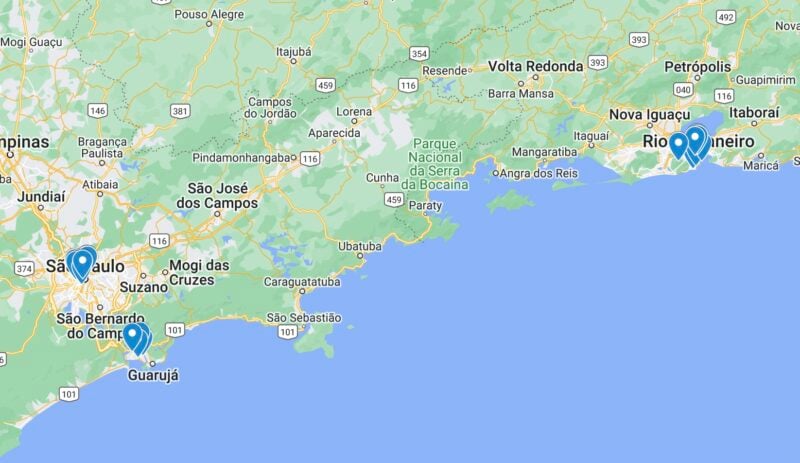
Click here for an interactive version of the Brazil travel map .
Popular Solo Travel Destinations In Brazil
On that note, let’s go over some of the top places to go during solo travel in Brazil, including:
Rio De Janeiro
Rio de Janeiro, commonly known as Rio, is the most popular destination in Brazil and the second largest city in the country. It is a bustling and vibrant city that captures the essence of Brazil’s captivating culture.
Nestled between lush mountains and breathtaking beaches, Rio offers a stunning backdrop for travelers seeking a mix of natural beauty, lively festivities, and iconic landmarks.
The city is renowned for its vibrant street life, samba rhythms, and friendly locals known as “Cariocas.” If you can only visit one city in Brazil, this city should be at the top of your list.
Solo travelers should add the following sites to their itinerary when visiting Rio:
Christ the Redeemer (Cristo Redentor). Sitting on top of Corcovado Mountain, this is one of the New 7 Wonders of the World and one of the city’s most iconic symbols. This Art Deco-style statue also offers sweeping views of the city – especially when you go inside and climb to the top. You should aim to visit early in the day before the crowds arrive for the best experience.
Copacabana and Ipanema Beaches. These city beaches are nearly synonymous with Rio. Copacabana Beach offers an energetic vibe and beach sports, while Ipanema Beach feels more upscale and trendy. Both offer beautiful golden sand and stunning views.
Sugarloaf Mountain (Pão de Açucar). This mountain provides awe-inspiring views of Rio. To reach the top you can either hike the Pão de Açúcar e Morro da Urca trail or take two different cable cars – but the view makes it so worth it. Consider visiting around golden hour or in the evening to make the view even more magical.
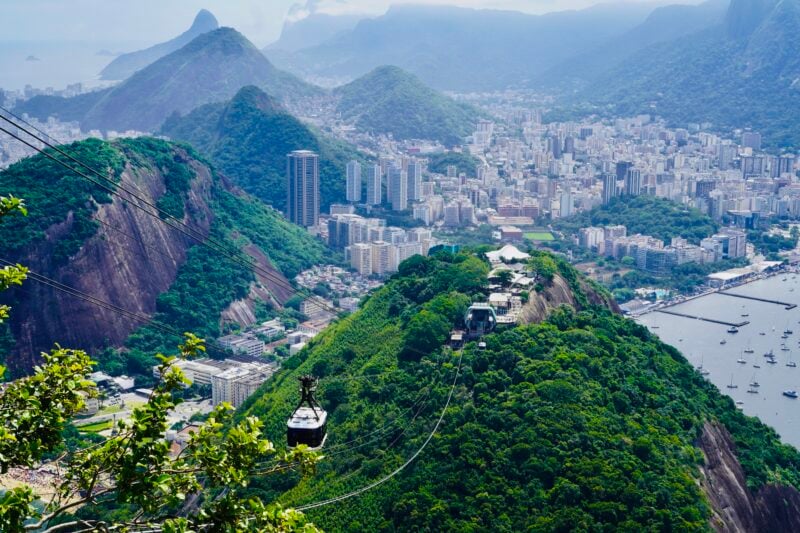
Historic City Centre (Centro). See the historical heart of Rio in the Centro neighborhood. While here, visit the nearby Lapa and Santa Teresa neighborhoods . Both are well known for their bohemian charm, lively nightlife, and colonial architecture.
Tijuca National Park. As one of the world’s largest urban forests, this park provides a serene escape from the city’s hustle and bustle. Hike through lush trails, see beautiful waterfalls, and enjoy more of those stunning viewpoints that Rio is best known for.
There are also many tours that explore Tijuca National Park , from Jeep excursions to waterfall treks and beyond.
Solo travel in Rio de Janeiro offers a rewarding experience for anyone who makes the trip to this breathtakingly beautiful city.
Rio de Janeiro Hotels: Click here for a full list of hotels in Rio de Janeiro . Rio de Janeiro Tours: Click here for a full list of fun tours in Rio de Janeiro .
Salvador de Bahia, known most commonly as Salvador, is located on the northeastern coast of Brazil. Known for its rich Afro-Brazilian culture, vibrant music and dance, and well-preserved colonial architecture, it provides a very different view of Brazil when compared to Rio.
One of the most popular destinations in Salvador is Pelourinho , the historic center of the city and a UNESCO World Heritage Site .
Its colorful streets are lined with grand churches, charming colonial buildings, and lively squares. In this area, there are also plenty of art galleries, museums, and artisan shops to explore and get immersed in the local culture.
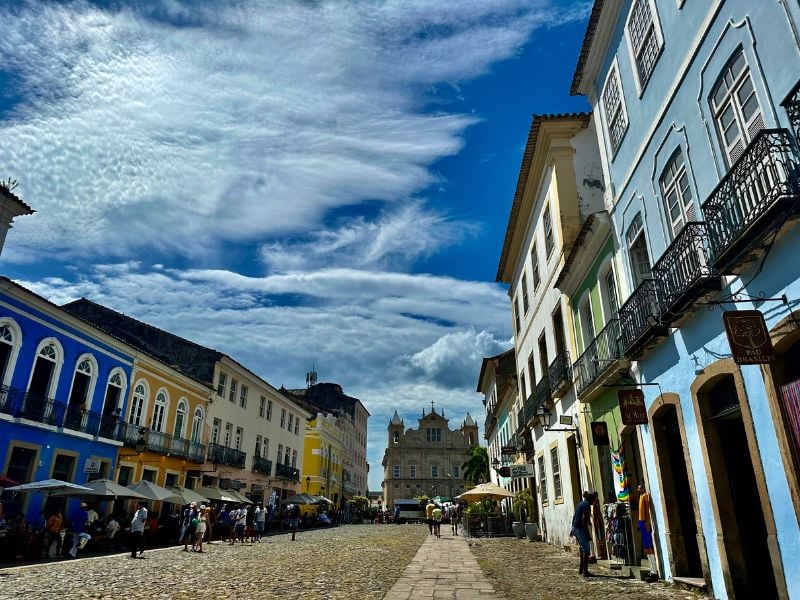
Another must-visit site in Salvador is the Mercado Modelo , a bustling market in the Lower City. In addition to browsing a vast array of local crafts, artwork, and clothing, you can sample local Bahian cuisine here.
Looking for the best beach destinations in Brazil? Salvador’s beaches are likely the best in the whole country – even beating out those in Rio.
Porto da Barra Beach and Farol da Barra Beach are some of the top choices in the area. This is evidenced by the fact that you will find lots of locals at both beaches at any time.
Finally, don’t forget to try out the samba while you are in Salvador! For a truly local experience, visit Clube do Samba in Pelourinho – the music and the dance are sure to sway you to move your feet.
Salvador’s rich Afro-Brazilian history and stunning coastline allow this city to provide an experience like no other in Brazil.
Salvador Hotels: Click here for a full list of hotels in Salvador . Salvador Tours: Click here for a full list of fun tours in Salvador .
Praia Do Forte
Praia do Forte in Bahia, Brazil, is a charming beach town renowned for its natural beauty and relaxed atmosphere.
The pristine beaches with their clear waters and golden sands are perfect for sunbathing and aquatic activities like snorkeling and diving.
You’ll also find loads of natural “pools” offering cool and shallow areas where you can leisurely relax during your time here.
The town is also home to the Tamar Project , a sea turtle conservation initiative where visitors can learn about and interact with these fascinating creatures.
The village of Praia do Forte offers a delightful mix of boutique shops, handicraft markets, and restaurants serving delicious Bahian cuisine.
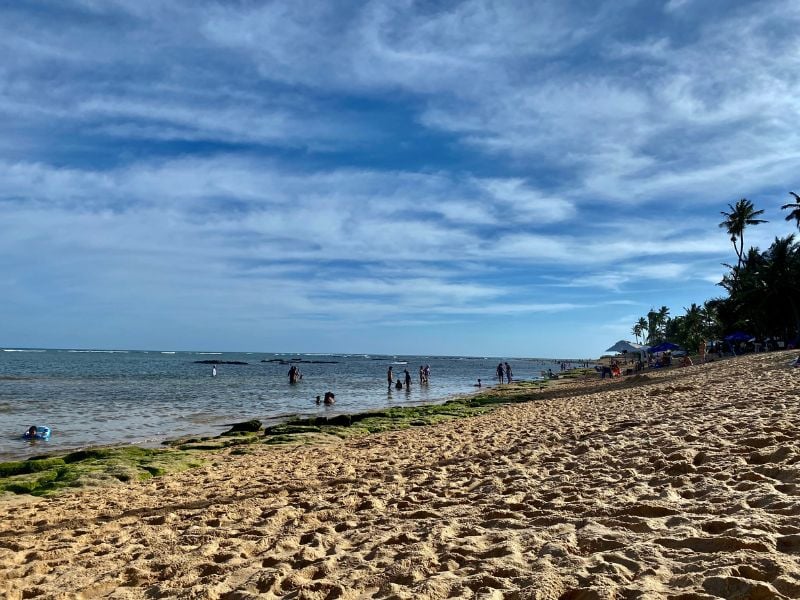
Nature enthusiasts can explore the nearby Sapiranga Reserve , with its hiking trails, waterfalls, and diverse flora and fauna. Fitting with the local vibe, you will find plenty of eco-lodges too.
Whether you are seeking relaxation on the beach, immersion in nature, or a glimpse into local culture, Praia do Forte provides a serene coastal escape.
Praia do Forte Hotels: Click here for a full list of hotels in Praia do Forte . Praia do Forte Tours: Click here for a full list of fun tours in Praia do Forte .
Is São Paulo worth visiting ? In my opinion, a visit to this bustling metropolis will certainly enhance your solo itinerary!
A cultural hub of Brazil, São Paulo offers a vibrant and diverse experience for tourists. With a population of 22 million, it is the largest city in South America and is a melting pot of cultures, art, and gastronomy.
The city boasts an impressive array of attractions – including fascinating museums, walkable neighborhoods, entertaining theaters, beautiful churches, and delicious restaurants.
For a taste of Brazil’s cultural heritage, visitors can explore the historic district of Centro with its iconic landmarks like the São Paulo Cathedral and the Municipal Market, where you can indulge in local flavors and fresh produce.
Speaking of great food, São Paulo is renowned for its gastronomy, offering a diverse culinary scene that caters to all tastes and travel budgets whether you like street food or sit-down restaurants. From traditional Brazilian dishes to international flavors, the city is a must for foodies.
Neighborhoods like Vila Madalena and Pinheiros are known for their trendy bars, restaurants, and lively nightlife.
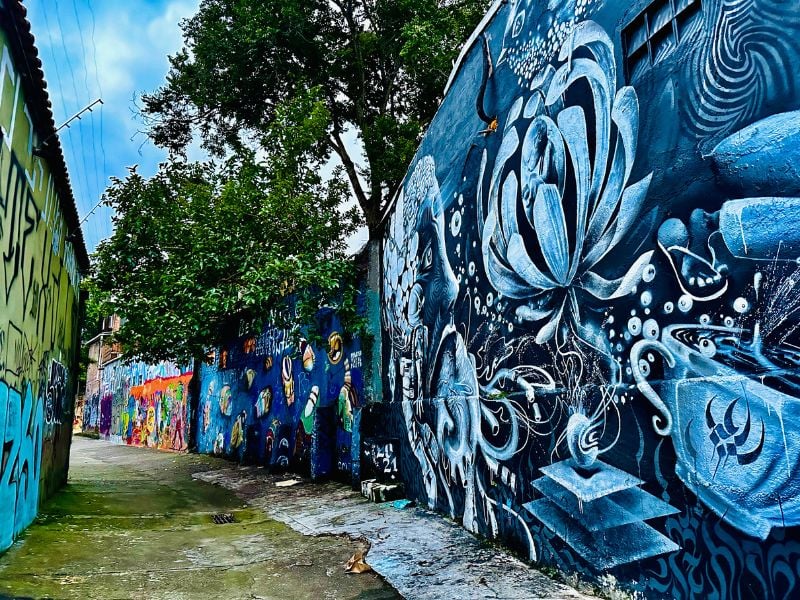
For those seeking retail therapy, São Paulo is a shopper’s paradise – with upscale boutiques, giant malls, and street markets offering a wide range of products. Avenida Paulista , the city’s main thoroughfare, is lined with luxury stores, art galleries, and cultural institutions.
To escape the urban bustle, São Paulo showcases beautiful green spaces like Ibirapuera Park , an oasis in the heart of the city. The park is the perfect place for leisurely walks, picnics, and visiting world-class museums like the São Paulo Museum of Art (MASP) , which houses an extensive collection of European and Brazilian masterpieces.
The diversity that São Paulo offers makes it a must-visit destination for tourists looking to immerse themselves in Brazil’s urban culture.
São Paulo Hotels: Click here for a full list of hotels in São Paulo . São Paulo Tours: Click here for a full list of fun tours in São Paulo .
Santos, a historic city located on the coast of Brazil’s São Paulo state, offers a delightful experience for solo travelers.
Its main attraction is the beautiful beachfront that showcases a 7-kilometer (4.3-mile) stretch of fine sand, calm waters, and palm-lined promenades. Visitors can relax on the beach, enjoy water sports, and savor fresh seafood at beachside bars and restaurants.
Santos’ maritime heritage is showcased at the Museu do Porto , which provides insights into the city’s important port and maritime history.
Another highlight is the Coffee Museum (Museu do Café), housed in a stunning historic building where visitors can learn about Brazil’s coffee industry and enjoy freshly brewed coffee.
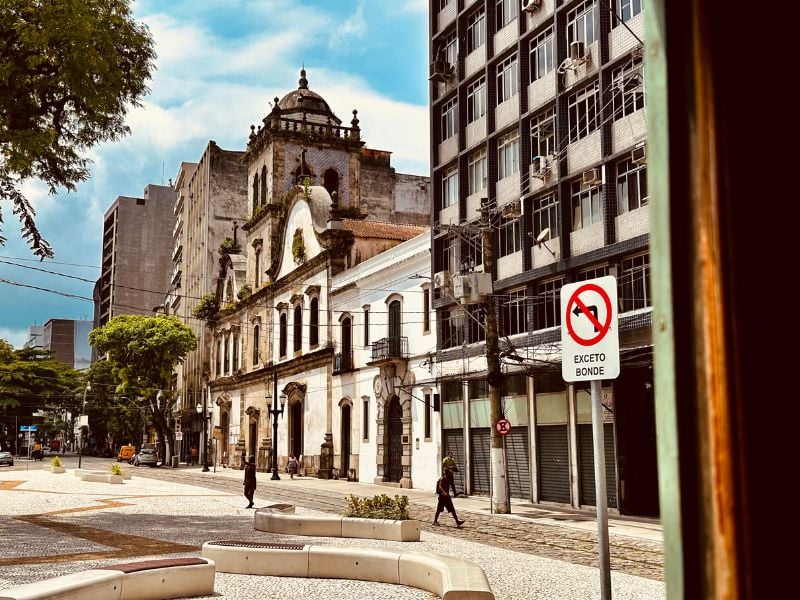
In terms of beautiful neighborhoods, Santos boasts a charming historic center featuring well-preserved colonial architecture, picturesque squares, and historic churches to create a nostalgic atmosphere.
Love nature? Make sure to visit the Jardim Botânico , a serene botanical garden with lush greenery and walking trails.
Santos offers a perfect blend of sun, sand, culture, and maritime charm for an enjoyable Brazil solo travel experience.
Santos Hotels: Click here for a full list of hotels in Santos . Santos Tours: Click here for a full list of fun tours in Santos .
Top-Rated Brazil Tours For Solo Travelers
Booking a guided tour makes it easy to meet people while solo traveling in Brazil. A few top-rated tour options include:
- Christ the Redeemer, Sugarloaf, Maracana & Selaron with Lunch (Rio de Janeiro
- Full Day Tour to Angra dos Reis & Ilha Grande (Rio de Janeiro)
- Secrets of Downtown São Paulo Bike Tour (São Paulo)
- The Brazilian Switzerland: Full Day Trip on Campos do Jordão (São Paulo)
- Salvador Full Day City Tour (Salvador)
- Private Cooking Experience with a Local (Salvador)
Click here for a full list of bus & walking tours in Brazil .
Tips For Taking A Solo Trip To Brazil
When you travel solo to Brazil, here are a few tips to keep in mind:
1- Research & choose safe accommodation. Prioritize your safety by researching and selecting reputable accommodations in safe areas, particularly ones popular with tourists. Consider factors like security measures, reviews from previous guests, and proximity to public transportation and amenities. This will help you travel solo successfully .
2- Explore local cuisine safely. Brazilian cuisine is diverse and delicious, offering a wide range of flavors. When dining alone, choose busy and reputable establishments that are popular with locals and tourists. This helps ensure food quality and provides a safer environment. Consider trying traditional dishes like feijoada (black bean and pork stew), acarajé (crispy bean and onion cakes), or churrasco (grilled beef) for an authentic culinary experience.
3- Stay vigilant & follow safety precautions. Avoid flashing valuables, keep an eye on your belongings, and be aware of your surroundings. Use reliable transportation options like registered taxis or ride-hailing services like Uber, especially at night. Stay informed about local safety guidelines and follow the advice of locals or trusted authorities.

4- Connect with other travelers. When thinking about the pros and cons of solo travel , a common worry is meeting other people. Brazil solo travel doesn’t mean you have to be alone throughout your trip. Connect with fellow travelers in hostels, via online travel communities like Facebook groups, or through organized group activities.
Participating in group tours allows you to meet like-minded people, enhance safety through numbers, and share memorable experiences together. You can also find local meetups and activities through platforms like CouchSurfing and Meetup.com .
5- Embrace cultural experiences safely. Brazil is rich in cultural experiences – from vibrant festivals to dance performances and local markets. When attending events or exploring crowded areas, be cautious of your belongings and avoid attracting unnecessary attention. Respect local customs and traditions, and be open to immersing yourself in the diverse culture while maintaining personal safety.
Remember, these tips are general guidelines, and it’s essential to adapt them to your specific destination and circumstances. Stay informed about current travel advisories , consult local resources, and trust your instincts.
With careful planning, awareness, and an open mind, Brazil solo female travel can be both safe and fulfilling.
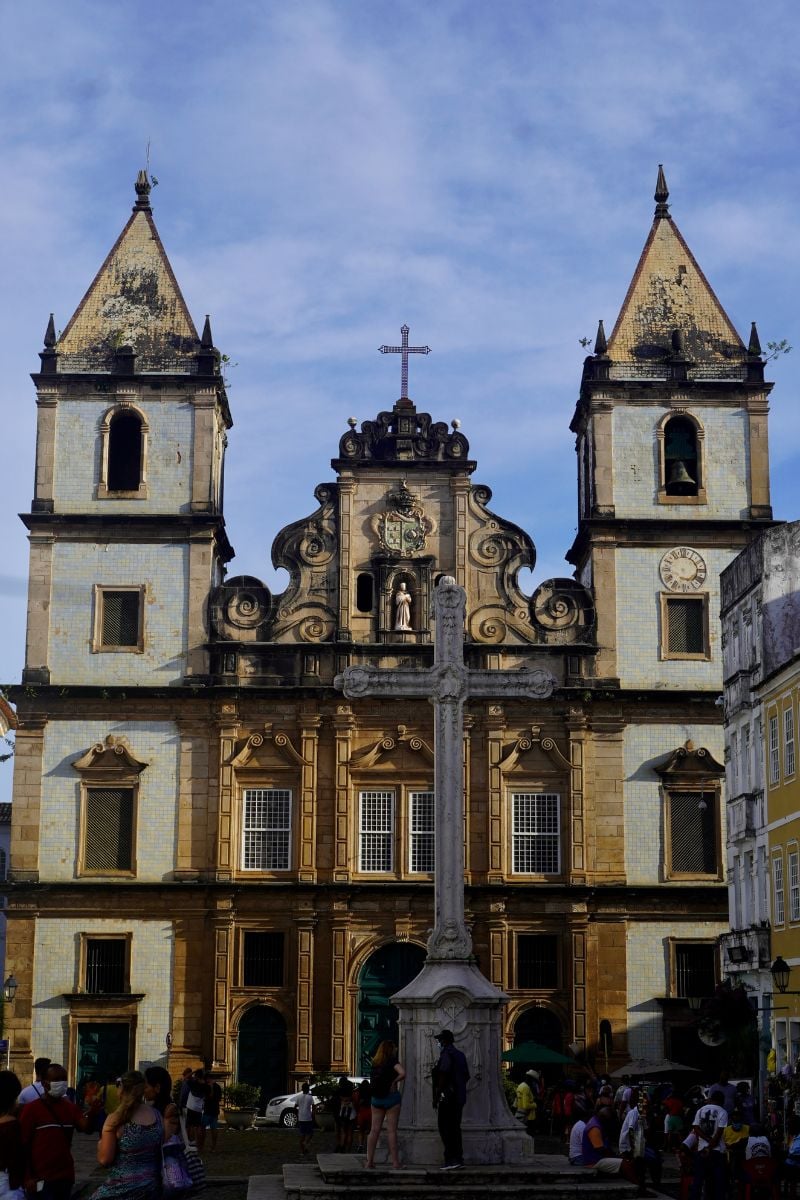
What Does Solo Travel To Brazil Cost?
Travel to Brazil is moderately priced, and costs can vary a good deal depending on how you like to eat and your hotel preferences. Here are some approximate breakdowns to give you an idea of what to expect when traveling to Brazil alone as a female:
Accommodation : $15-$30 for a night in a hostel, $50-$200 for a night in a mid-range hotel.
This map can help you compare your options. It’s set to show hotels and rentals in the Santa Teresa neighborhood of Rio de Janeiro, but you can easily change this based on where you’re staying:
Food : Budget about $10-$15 for a quick service meal or $20-$30 for a sit-down meal in a mid-range restaurant.
Transport : You can expect to pay about $1 for a one-way trip on the subway or city bus or an average of about $5 for a 20-minute Uber ride.
Activities : There are many cheap and free things to do in Brazil – like relaxing at the beach or exploring cool neighborhoods. Most major attractions will have an entry fee; however, costs are typically low.
For example, entry to the Christ the Redeemer statue is about $5 during high season. The cost for tours will run around $20-$100, depending on the duration of the tour and extra inclusions like meals.
Brazil Travel Insurance
When visiting Brazil — or anywhere else in the world — it’s wise to get travel insurance.
One of the best travel medical insurance for travelers is SafetyWing as they’ve got a large network and offer both short-term and long-term coverage — including coverage if you’re traveling for months as well as limited coverage in your home country.
Additionally, SafetyWing is budget-friendly and offers $250,000 worth of coverage with just one low overall deductible of $250.
Click here to price out travel insurance for your trip in just a few clicks .
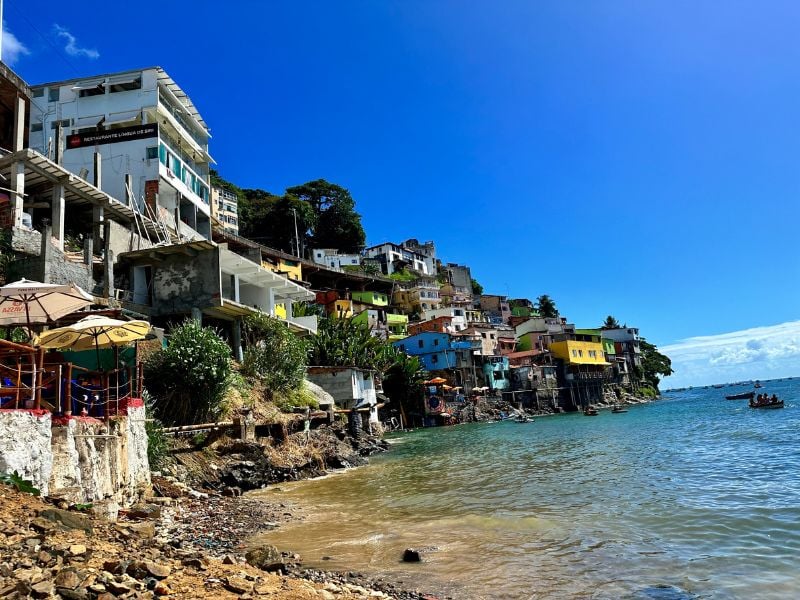
Frequently Asked Questions About Solo Travel In Brazil
Now that we’ve gone over where to go and important tips when traveling Brazil solo, I want to answer some frequently asked questions:
Q) Is Brazil good for solo travel?
Brazil is an excellent destination for solo travel thanks to its welcoming atmosphere, vibrant culture, rich history, and variety of things to do and see. From beautiful Brazilian beaches to samba music to delicious food, it’s easy to have an unforgettable trip.
Q) Is Brazil safe to travel alone?
Yes, Brazil is safe to travel alone, particularly if you choose popular tourist destinations. Just make sure to exercise common sense safety practices when preparing for your trip and throughout your journey.
Q) What is the best time to visit Brazil?
The best time to visit Brazil will depend on what part of the country you’ll be in. If you plan to visit Southern Brazil, such as São Paulo or Iguazu Falls, the warmest months are summer (December to March). In Northeast Brazil and Rio, you will find warm weather all year, but the weather is driest from September to November.

Q) Is Rio de Janeiro safe for solo female tourists?
As a major tourist destination in Brazil, traveling to Rio de Janeiro alone is safe for female travelers who exercise appropriate caution. This means not wearing flashy clothing or jewelry, using ride-shares at night, and joining guided tours when possible.
Q) Is São Paulo safe for solo female tourists?
Solo travel in São Paulo is generally safe for female tourists. It’s recommended to research hotels in safe areas, use reliable public transportation methods, and stay aware of your surroundings.
Q) Can you drink tap water in Brazil?
It is generally recommended to avoid drinking tap water in Brazil, especially outside of major cities like Rio and Salvador. The safest route is to either buy bottled water or filter your own water .
Q) Are credit cards accepted in Brazil?
While it’s wise to carry some cash with you, credit and debit cards are widely accepted around Brazil, particularly in tourist areas.
Q) What is the currency in Brazil?
The local currency is the Brazilian real (R$).

Final Thoughts On Brazil Solo Travel
Traveling to Brazil alone can be an unforgettable experience that allows you to explore the country on your own terms – which is one of the biggest benefits of solo travel .
As you read above, there are many incredible places to visit on a solo trip to Brazil and a wide variety of experiences to be had.
Don’t be afraid to customize the suggested Brazil itinerary to your personal liking and needs. Do as much or as little as possible, even if it means spending a few hours wandering without a plan or relaxing in a local park. Just enjoy the beauty of Brazil!
What tips would you add to this guide to solo travel in Brazil?
Enjoyed this solo travel Brazil guide ? Pin it for later!

About The Author
Christen is a Washington DC-based travel blogger and travel advisor. Her blog, TravelWanderGrow , provides detailed travel guides that focus on city history and culture. As a frequent traveler, she also shares in-depth travel tips. In addition to her blog, you can follow her travels on Instagram and Facebook .
Related posts:

Hi, I’m Jessie on a journey!
I'm a conscious solo traveler on a mission to take you beyond the guidebook to inspire you to live your best life through travel. Come join me!
Want to live your best life through travel?
Subscribe for FREE access to my library of fun blogging worksheets and learn how to get paid to travel more!

Turn Your Travel Blog Into A Profitable Business
Subscribe to my email list to snag instant access to my library of workbooks, checklists, tutorials and other resources to help you earn more money -- and have more fun -- blogging. Oh, and it's totally FREE! :) // Privacy Policy .
Check your inbox for your welcome email + resource library password!
Leave a Comment Cancel Reply
- EXPLORE Random Article
How to Plan a Trip to Brazil
Last Updated: May 28, 2021 References
This article was co-authored by wikiHow Staff . Our trained team of editors and researchers validate articles for accuracy and comprehensiveness. wikiHow's Content Management Team carefully monitors the work from our editorial staff to ensure that each article is backed by trusted research and meets our high quality standards. There are 23 references cited in this article, which can be found at the bottom of the page. This article has been viewed 21,963 times.
If warm weather, sunny beaches, lush rain forests, and a vibrant nightlife sounds like a good time to you, you might want to plan a trip to Brazil! As with all international travel, there are some steps you need to take ahead of time in order to prepare for your trip—including getting your passport and tourist visa and making travel and lodging arrangements early. Once you have all of the important business in order, it’s time to plan some fun things to do!
Preparing to Travel

- You will need your passport both to enter Brazil and to re-enter your home country.
- Start on this process early because it can take up to 8 weeks to receive your new passport. Even if you choose to pay the extra fee to have it expedited, it can still take 2-3 weeks to receive. [2] X Research source

- A valid passport
- Photocopies of your roundtrip ticket
- Required application forms
- Immunization records for children
- Visit the Brazilian consulate official website to determine if you are required to obtain a visa. There will you find a list of which countries have had the requirement waived. [4] X Research source

- Check out some videos on YouTube to get a better understanding of how to pronounce the words and phrases. [6] X Research source
- Download a translator app to your phone to help with more difficult conversations. [7] X Research source

- If you want to visit multiple destinations, take domestic flights or long-distance buses to travel between different cities.

- Rio de Janeiro’s summer is December to February and temperatures can reach 104 °F (40 °C). There is still quite a bit of rain during this time, so don’t let the hot temperatures discourage you from bringing proper rain attire. Winter is in July and August and temperatures are usually around 70 °F (21 °C).
- São Paulo’s weather is pretty steady year round. The hottest month of the year is January, with an average temperature of only 76 °F (24 °C); while the coldest month is June, with average temperature of 66 °F (19 °C).

- If you are planning to use your mobile device, you will also need to verify with your carrier that the phone will get service in Brazil and what the roaming fees will be.
- Wi-Fi is widely available, so check out apps like Skype as well.
Making Travel and Lodging Arrangements

- Airline companies often run special promotions. Check their websites often and/or sign up to receive email newsletters and notifications so you don’t miss a deal.
- Don’t forget to check travel companies like Orbitz and Expedia because sometimes they end up having the best deals. They also offer package-deals where you can mix and match airfare, hotel, and transportation—and that might save you some money. [11] X Research source

- Pousadas are privately-run guest houses that are located in a variety of locations across the country and tend to be more affordable than the hotels. If you go this route, you may end up staying in a historical palace or convent! [13] X Research source
- Stay in a jungle lodge and experience sleeping in the Amazon rain forest and waking up with wildlife. [14] X Research source
- Take it a step further and try out sleeping in the treetops in an luxury eco hotel.

- The restrictions on the Airpass are pretty hefty. For instance, it must be purchased outside of Brazil, is only valid for 30 days, and the routes cannot be changed (but the dates can be). Overall, it tends to be worth the investment.
- Expect to pay an additional airport tax when you check in for your flights.

- Riding the long-distance bus will take much longer than flying and the prices are typically comparable to flying anyway, so choose this option if you prefer to watch the scenery pass by or if you aren’t fond of flying.

- You have to be at least 21 years old to rent a car in Brazil. You will also need to have a valid driver’s license, credit card, and your passport. [17] X Research source
- You aren’t required to have an international driver’s permit, but it is a good idea to carry one in addition to your regular driver’s license in case you happen to be pulled over. This makes it easier for the officer in case they aren’t able to read the language on your license.
Planning What to Do

- The exchange rate constantly changes, so check the current rate when you arrive to give you a good idea of how much money you should convert. If you have leftover real at the end of your trip, you will typically need your original receipt to change it back to your home currency.
- Most major credit cards, particularly Visa, are accepted in larger cities, but be aware that you may be charged a foreign transaction fee for using them. [19] X Research source
- ATMs are located throughout the country as well, though they have been reported to be problematic at times. As such, use this option as a last resort.

- Even if you don’t visit one of the world’s best beaches, like Ipanema or Copacabana in Rio de Janeiro, most of the beaches are worthy of a visit.

- The boats and tours range from budget to luxury, so there are options for everyone.

- The celebration usually takes place during the last week of February or the first week of March. Search “Rio Carnival” and the year you are traveling to get the dates of the event. See if you can squeeze it in, or plan your trip around it.

- Bring a bicycle or your jogging shoes along if you want to be more active.
- The park also offers lots of activities for kids, including 3 museums, a garden, and a playground.
- Bring comfortable shoes—you have to climb 215 steps to get to the top.
Expert Q&A
- Planning an international trip can be overwhelming, but don't worry! Creating a detailed plan and checklist, and marking items off as you go, will get you trip-ready in no time! Thanks Helpful 0 Not Helpful 0
You Might Also Like

- ↑ https://www.worldtravelguide.net/guides/south-america/brazil/passport-visa/
- ↑ https://passportinfo.com/passport-renewal/
- ↑ https://visacentral.com/brazil-visa
- ↑ http://cgwashington.itamaraty.gov.br/en-us/visa_requirements_by_country.xml
- ↑ https://theculturetrip.com/south-america/brazil/articles/12-brazilian-portuguese-phrases-you-need-to-know-before-you-visit-brazil/
- ↑ https://youtu.be/js3xodgxWLI?list=PL2u7zFxLgz_XeZ_TBevYiGqtFhGFPYd9r&t=2
- ↑ https://www.fluentu.com/blog/portuguese/portuguese-app/
- ↑ https://www.worldtravelguide.net/guides/south-america/brazil/weather-climate-geography/
- ↑ https://www.worldtravelguide.net/guides/south-america/brazil/business-communications/
- ↑ https://www.cnbc.com/2017/05/11/whens-the-best-time-to-book-a-flight.html
- ↑ https://www.nytimes.com/2011/02/27/travel/27prac-vacationpackage.html
- ↑ https://www.worldtravelguide.net/guides/south-america/brazil/region-hotels/
- ↑ https://www.nytimes.com/2007/07/08/travel/08pousadas.html
- ↑ https://theculturetrip.com/south-america/brazil/articles/the-best-eco-resorts-in-brazil/
- ↑ http://www.aboutbrasil.com/modules/brazil-brasil/travel_about_brazil.php?hoofd=1&sub=1&art=10
- ↑ https://www.smartertravel.com/2017/06/19/getting-around-brazil-transportation-tips/
- ↑ https://www.worldtravelguide.net/guides/south-america/brazil/money-duty-free/
- ↑ https://www.nerdwallet.com/blog/credit-cards/foreign-transaction-fee/
- ↑ https://www.travelchannel.com/destinations/brazil/photos/brazil-s-best-beaches
- ↑ https://www.tripstodiscover.com/the-best-things-to-do-in-brazil/2/
- ↑ http://traveltips.usatoday.com/history-carnival-rio-de-janeiro-11711.html
- ↑ https://www.travelchannel.com/destinations/brazil/articles/things-to-do-in-brazil
- ↑ https://parqueibirapuera.org/ibirapuera-park/
About this article

Reader Success Stories
Simon Paulsen
Sep 14, 2021
Did this article help you?
- About wikiHow
- Terms of Use
- Privacy Policy
- Do Not Sell or Share My Info
- Not Selling Info

A 3-Week Itinerary for Brazil Full of Highlights
Brazil is famous across the globe for its relaxed and friendly people, beautiful naturing settings, and sprawling urban metropolises. Not to mention its love for football. It’s no wonder that Brazil is at the top of many travelers’ lists of dream locations.
But, as the largest country in South America and the Southern Hemisphere, with so much to see and do, it can be hard to know how to begin or where to go in Brazil, especially if it’s your first visit.

But, no fear, I’ve put together this packed itinerary to make sure you soak up as much as possible in your 3 weeks in Brazil, taking you across the country from stunning natural settings to Brazil’s famous cities.
So, without further ado, let’s jump into this three-week Brazil itinerary for your first visit!
Table of Contents
How to get around
Brazil is huge, so be prepared to travel long distances if you want to see a variety of the country. If you’re traveling far between different states, a plane will be the quickest, and you can get cheap deals if you book in advance.

Alternatively, Brazil has a great network of long-distance buses that are widely used by the locals. The bus between São Paulo and Rio is only six hours long. And if overnight buses sound like your kind of thing, routes are cheap between cities such as Rio and Salvador (a 24-hour journey). Overnight buses were my bread and butter when Brazil backpacking, and are actually very fun!
The metro is a great way to get around in larger cities such as São Paulo and Rio. Alternatively, Uber is pretty cheap in Brazil and shouldn’t cost more than $10 for medium-length journeys.
Also read: Is Brazil Expensive to Visit? Your Guide to a Budget-Friendly Trip
Days 1-2: Iguaçu Falls

Start your trip south of the country, at one of Brazil’s most amazing natural wonders. These gigantic waterfalls are a great way to explore Brazil for the first time, providing a magical experience of the country’s exceptional natural beauty.
As the largest waterfall system in the world, the falls themselves are magnificent, but make sure to also take in the rest of the tropical surroundings. The falls also separate Brazil from Argentina , so they can be seen from both sides.
On the Brazilian side, the falls are accessible by an easy trail, with its own set of observation decks. You can also hop on a boat tour of the falls , which will take you right underneath, or a helicopter tour , for unreal overhead views.
Where to stay: Hotel das Cataratas is found right in the heart of the Iguaçu National Park, providing stunning views of the falls from your bedroom balcony. If you’d like to stay in the local town (confusingly called Foz do Iguaçu), try ApartDamani .
Days 3-5: São Paulo

After marveling at Iguaçu, start your journey northward to Brazil’s largest city, São Paulo . As a sprawling urban metropolis and one of the most diverse and cosmopolitan cities in the world, São Paulo has to be my favorite city in the country.
It has a huge range of culture, sightseeing, nightlife food, and fun. Spend your first day exploring Avenida Paulista, the city’s famous avenue hosting museums, shops, and restaurants.
Stop by the São Paulo Museum of Art (MASP) – one of my favorite galleries in the world – or explore never-ending views of the city from the free viewing point at the top of Sesc. The best time to visit is on a Sunday, when the avenue is closed to cars and the streets become filled with street vendors.

Spend your second day exploring the city center––perhaps on a bike tour ? Head to the top of Farol Santander – inspired by the Empire State Building – to look over the city from a new angle, or visit the Pátio do Collegio, where the city was first founded, to learn more about the city’s history. For food, you can head to the grand Municipal Market for a selection of Brazilian delicacies.
On your third day, visit the city’s iconic Ibirapuera Park, one of my top spots for an afternoon stroll or to catch some sun. Buy an ice-cold coconut from one of the local sellers, or sip on the cold water as you take in the lush green setting.
Where to stay: Check into the luxurious Renaissance São Paulo Hotel , located in the high-class Jardins neighborhood, or check out the views from the top of the Golden Tower in bohemian Pinheiros.
Day 6: Paraty

Paraty is a great stop off on the road to Rio, breaking up the journey between the two big cities and giving a relaxing escape from their bustle.
The Portuguese built the town during the colonial period and served as a port for exporting gold, which was excavated inland by slaves. Today, this colonial architecture and quaint small-town vibes prove popular with local tourists.
Take a walking tour of the town center to find out more about the town’s history and local culture, and why it’s a UNESCO World Heritage Site. Or step out into the surrounding natural areas of the town to make the most of stunning natural waterfalls and golden beaches.
If you love alcohol, head to the local cachaça breweries , which are some of the best across Brazil.
Where to stay: Stay at the Casas do Pátio Pousada to be right in the center of the action, and a stone’s throw from Paraty’s beautiful beaches and harbor.
Day 7-9: Rio de Janeiro

Rio de Janeiro continues to enthrall tourists from around the world, and it’s no surprise. With such varied culture, wonderful views and landscapes, and its laid-back vibe, it’s of course a must-see in Brazil.
You can spend your first day taking in the main sights, which are amongst the best of Brazil’s tourist attractions. Take the iconic train up to the Christ Redeemer to experience Brazil’s most iconic landmark and get the best far-reaching views over the city.
In the afternoon, head to Sugarloaf Mountain for more sky-high views and to ride the world’s third-oldest cable car.
If you’re a beach lover, you can spend your second day soaking up the sun at Rio’s selection of beautiful beaches. Marvel at the stunning blue water, and Sugarloaf Mountain from a new angle, at Copacabana Beach, or experience the fun LGBTQ+ atmosphere at Ipanema. Venture further to Barra da Tijuca if you’re feeling adventurous.

Spend your third day exploring the city’s center, with the Museum of Tomorrow and colonial architecture, such as the Paço Imperial. You can also head to the Lapa neighborhood to see the impressive Aqueduct and the Selarón steps.
Stay out in Lapa as the sun goes down for the center of Rio’s nightlife. Be sure to pick up some caipirinhas from the street sellers and samba the night away.
The best time to visit Brazil and Rio de Janeiro if you love to party is, of course, for Carnaval. Held between February and March (the dates change every year based on Easter), it’s the biggest party in the world and a must-visit.
Where to stay: For the best luxury Rio has to offer, check into Copacabana Palace , known for its famous visitors and location on the beachfront of Copacabana Beach. Or check out Casa Geranio , which is beautifully decorated and found in the exciting neighborhood of Santa Theresa.
Also read: 20 Best Resorts & Beach Hotels in Rio de Janeiro for a Seaside Getaway
Days 10-11: Salvador

The heart of Afro-Brazilian culture and the North-East region, Salvador is the best city to experience this important part of Brazilian identity and history.
Spend your first day wandering around the cobbled streets of Pelourinho, with its colorful architecture and exciting street performances. Head to the Museum of Bahian Gastronomy for lunch, to try out a range of traditional Bahian dishes. In the afternoon, head to the Casa do Rio Vermelho, the home of famous Brazilian writer, Jorge Amado. Or you could take the Lacerda Elevator to the lower city and the Modelo Market.
You can spend your second day in this beautiful coastal city beach-hopping, with a load of stunning beaches running along its coast. Busier beaches such as Porto da Barra are worth a visit, or find peace at Flamengo or the Bay of All Saints.

That evening, catch the popular sunset at Barra Lighthouse, before heading to Rio Vermelho to try the best acarajé and drink even more caipirinhas.
Where to stay: Hotel Villa Bahia puts you right in the center of Pelourinho’s wonderful nightlife, while Canto Hotel provides prime access to the stunning beaches around Rio Vermelho.
Days 13-14: Chapada Diamantina

If you’re into hiking or exploring nature, a trip to the Chapada Diamantina national park is a must on your itinerary.
Offering emerald mountainous landscapes and amazing views, it’s a great place to explore Brazil’s outdoors, especially since it’s a hidden gem amongst international tourists and often not found on lists of places to visit in Brazil.
On your first day, you can take a tour of the stunning Pati Valley or popular Cachoeira da Fumaça (Smoke Waterfall), named for the smoke-like appearance of its water as it falls from the rocks.
On your second day, take a tour of the Morro do Pai Inácio (Mount of Pai Inácio), which is the classic postcard shot of the national park. You’ll be taken to a number of waterfalls and grottos in the park, before ending your day watching the sunset on top of the Morro.
Where to stay: Pousada Vila Serrano in the town of Lençois is a great place to kick back after exploring the surrounding Chapada, while Castelar da Alvorada in the bohemian village of Capão provides great access to the Cachoeira da Fumaça.
Day 15: Recife

Stop off at Recife on your way up the coast of Brazil, to explore more Northeastern culture and attractions.
Spend the morning exploring the Old Town, and learn about the region’s cultural dance at the Paço do Frevo. Pass the afternoon at the neighboring town of Olinda, a UNESCO World Heritage site famous for its carnaval celebrations and huge puppets.
Where to stay: Bugan Recife Hotel places you right on the beachfront of Boa Viagem, and is a short journey from the stunning Old Town.
Day 16: Fortaleza

Break up your journey up to the beautiful Lençois Maranhenses at the up-and-coming city of Fortaleza, one of the biggest in the country.
You can pass your day relaxing at its selection of stunning beaches, including Iracema and Praia do Futuro (the filming location of one of my favorite-ever films, aptly named Praia do Futuro ). You could even take a day trip to the tropical paradise town of Jericoacoara .
If you’re done relaxing, visit Fortaleza’s Central Market to pick up some artisanal goods or get your hands on some cocada.
Where to stay: Crocobeach Hotel is a great option for relaxing beach views of Praia do Futuro, while Ecco Hotel Fortaleza provides a wonderful stay in the city center, and is close to the city’s nightlife hub.
Day 17-18: Lençois Maranhenses

Quickly becoming a must-visit attraction for international tourists to Lençois Maranhenses, this national park has to be my favorite natural destination in Brazil. It’s by far one of the best things to do in Brazil. And with 380,000 acres of rolling sand dunes and natural rain pools, along with 70 kilometers of coastline, you can explore for days.
Visiting Lagoa Bonita and Lagoa Azul is a must, where you’ll be met with dreamy desert landscapes and stunning natural swimming pools. If you’re an adventure lover, you could even hop on a buggy and race across the dunes in style.
Spend the second day in the rural and alternative village of Atins, from which you can visit Lagoa Tropical.
The best time to visit is between May and October, when the rainfall is lower, but the lagoons are still flooded.
Where to stay: Pousada Vila de Charme is a great base from which to explore Lençois Maranhenses, and to wind down and relax after your day trips.
Day 19-21: Amazon Rainforest

Brazil is famous worldwide for its magnificent Amazon Rainforest so, of course, any itinerary to the country should include a visit to this ecological spectacle.
For shorter and more accessible trips, head to the Amazon’s largest city, Manaus. From here, you can find a huge variety of day and multi-day trips into the rainforest .
Or, if you have more time, hop on the ferry to Belem, which will take you on a 5-day journey along the Amazon River into the heart of the rainforest.
Where to stay: Hotel Villa Amazônia in Manaus is a great spot to start your Amazon adventure.
Other highlights and things to do in Brazil

Of course, there’s so much more to see in this gigantic and diverse country than what you can see in three weeks. Depending on your own interests and timings, you could switch out any of these destinations for a whole host of others.
You could relax with a coconut on the beautiful island paradises of Ilhabela or Ilha Grande, both easily accessible from São Paulo and Rio.
Alternatively, you could head into the lush green state of Minas Gerais, visiting its capital Belo Horizonte or the colonial gold town of Ouro Preto.
And, if you’re into politics or modernist architecture, catch a flight to Brasília, the country’s capital, built in the shape of an airplane in just 1960.
So, there you have it, your three-week itinerary to Brazil. Remember to send us pictures and let us know what you think!
Leave a Comment Cancel reply
Save my name, email, and website in this browser for the next time I comment.

© 2024 Hey Explorer
Stock images by Depositphotos
A guide to visiting Brazil's Pantanal
Book your individual trip , stress-free with local travel experts
- roughguides.com
- a-guide-to-visiting-brazils-pantanal
Plan your tailor-made trip with a local expert
Book securely with money-back guarantee
Travel stress-free with local assistance and 24/7 support
written by Madelaine Triebe
updated 29.11.2023
Stretching across the Brazilian states of Mato Grosso and Mato Grosso do Sul (also spilling into Bolivia and Paraguay) the Pantanal is the world's largest inland wetland area. While the Amazon gets more credit, the Pantanal's open spaces offer the best opportunities for spotting animals in their natural habitats in Brazil. Madelaine Triebe has the lowdown on everything you need to know about the country's top wildlife destination.
Which side should I visit: Mato Grosso or Mato Grosso do Sul?
When should i go, how do i get there, what animals can i expect to see, what can i do in the pantanal, what do i bring, where should i stay, what else can i do, something a bit cheaper, tailor-made travel itineraries for brazil, created by local experts.

9 days / from 2042 USD
Brazilian Beaches: Copacabana, Botafogo and more
Begin at Foz do Iguaçu, where you will stand in awe of the huge Iguaçu Falls. Next up, we'll head to the lively city of Rio de Janeiro, home of the legendary Copacabana, Botafogo and Flamengo beaches, and of course, Sugar Loaf Mountain and the iconic Christ the Redeemer statue.

10 days / from 1700 USD
Blissful Brazil
Welcome to a lavish journey that marries adventure with style, featuring stays in carefully chosen four-star hotels. This reinvigorating trip will have you sightseeing in São Paulo, gazing at the spectacular Foz do Iguaçu falls and relaxing on Rio's finest beaches before you know it.

10 days / from 2683 USD
Breathtaking Brazil: Rio, Beaches and Waterfalls
Explore the lively city of Rio de Janeiro, home to Ipanema and Copacabana beaches; experience the stunning Foz do Iguaçu National Park and see the world’s largest waterfalls system; immerse yourself in cultural Salvador, the magnificent former capital of Portugal’s New World colony.
Both, if possible. Mato Grosso wins hands down on jaguar spotting. Along the Cuiabá River from July to September – when the water levels are low, and the big cats come out to hunt and relax on the river banks – it is not unusual to spot at least three jaguars a day.
Mato Grosso do Sul has good budget options, as well as cattle farms where you can see more of the traditional Pantaneiro culture. Watch the local cowboys ( peãos ) with their big straw hats sip on tereré (a drink prepared with yerba mate and ice-cold water), herd cattle on horseback or muleback or clear trails cutting off palm leaves and branches with the Pantaneiro knife, made from a short wooden handle and a roughly 50 centimetre-long blade.
Not sure how to visit Pantanal? Check out our Pure Wildlife trip , including a visit to Pantanal!
For wildlife-spotting, the best time is the dry winter season, roughly from June or July to the end of September. The water has receded, and the animals come out from the deeper and more inaccessible parts of the wetlands and cluster around the waterholes.
The peak of the rainy summer season (November to March) is still a great time to visit as it's quintessentially Pantaneiro in its lush landscape. This is when the rivers overflow and flood the lowlands, making most of Pantanal only accessible by aeroplane or boat.

Top image: Aerial view of the Pantanal © Lucas Leuzinger / Shutterstock
There are three main modes of transport depending on the water levels: aeroplane, boat or car. There is no public transport whatsoever within the area so make sure to get your travel sorted before heading off.
There are two main roads running through the Pantanal, the Transpantaneira in the north (Mato Grosso) and Estrada do Parque in the south (Mato Grosso do Sul). Both are dirt roads with numerous wooden bridges in various conditions, as well as pousadas, lodges and fazendas catering to tourists.
Colourful birds are in abundance here, including the iconic white jabiru stork with its black and red neck, as well as red, blue and hyacinth macaws. There are also plenty of square nosed capybaras and caimans around. For the rest of the wildlife, it's all about being at the right place at the right time.
Most visitors come hoping to see the jaguar and your best chance at glimpsing this elusive animal is either early in the morning or from dusk when they hunt, eat and drink. The same goes for the Brazilian tapir, the marsh deer and the giant anteater. Another popular animal on wildlife wish lists is the giant otter, which can reach 1.7m in length.

Jaguar © Madelaine Triebe
Related articles from the blog

There are plenty of things to do and it all depends on where you stay. Most pousadas and fazendas (ranches) offer kayaking, boat trips, piranha fishing (using beef bait), horse riding and night safaris.
A jaguar safari on the Cuiába River and its tributaries can entail watching a female jaguar hunting for lizards along the riverbank, a 130kg jaguar male catching a caiman or photographing a young feline resting in a tree as the sun sets over the Pantanal. Pantanal Jaguar Safaris and Biodiverse Brazil Tours, both run by biologists devoted to sustainable tourism, offer jaguar expeditions in the north of the Pantanal.
Try your hand at piranha fishing. Go up the river to find the sharp-toothed fish and moors in front of the pousada with caimans sunbathing on the riverbank a few metres away. Casting your rod, you might spot a cheeky one loitering, waiting for you to pull a piranha out of the river and claim it for himself. After an hour or so you should have enough (unless the caiman got the better of you) to have fried piranha, teeth and head intact, for lunch.
If not fried, the piranha is the main star in the caldo do piranha, a soup popular with locals for its aphrodisiac effect. Together with carreteiro (rice prepared with dried beef) and fried pacu (fish) ribs, it's part of traditional Pantaneiro food.

Caiman © Madelaine Triebe
If you're travelling solo or with just a few other people, your best bet to go sportfishing in the Pantanal is to book yourself into a pousada that offers specialised fishing packages. Populating these waters are catfish species like pintado and cachara that can measure up to one metre in length (the record is a whopping 100kg and 1.6 metres), as well as pacu (with its human looking teeth) and piranha.
At Hotel Barra Mansa you'll be taken out on 16-foot speed boats on Rio Negro fishing for (catching and releasing) dourado, pintado and pacu. There's also the option to go fly fishing if you have the knack for casting the almost weightless artificial fly used as a bait.
Additionally, a major highlight is the seven-day horse expedition with Brazil Nature Tours riding through lagoons getting your legs soaked, sport fishing or watching the white Nelore cows with their long legs graze in the water.
Corúmba, in the south of Pantanal, makes an excellent base for booking a yacht if you want to stay on the river. Along Rua Manoel Cavassa down at the port you find a range of travel agents, like Joice Pesca & Tur Pantanal , offering sportfishing packages on the luxurious houseboats with neat cabins, dining rooms, as well as communal spaces with sofas and TVs. Some even have a pool. To optimise your chances, do like the Brazilians and gather a group – most yachts require a minimum number of people, mostly ranging from 10-20 people. Then spend up to a week cruising the Pantanal sleeping in wooden cabins with crisp sheets and going out on smaller motorboats to fish during the day.

Bridge in the Pantanal © Hakat / Shutterstock
Light-coloured clothes, sunscreen, hat, a rain jacket, binoculars and lots of insect repellent. Locals and guides alike might tell you during the dry season that there are no mosquitos around – and by Pantanal standards there might not be – but the ones that are love visitors.
There are plenty of good options and it boils down to how much you want to spend.
The best way to explore Pantanal is to book a stay in Cuiabá. If you choose to go with us, we will pick you up and get you to Pantanal. Over the next two days, indulge in exciting daily activities, ranging from boat trips to horseback riding and hikes
Refúgio Ecológico Caiman – a 53,000 hectare working cattle ranch a 36km drive from Miranda in Mato Grosso Do Sul – offers eco-tourism at its finest. You stay in beautifully decorated rooms, (opt for Baiazinha Lodge where each room has a lake view and a private balcony with hammock) and you can spend a whole day tracking down jaguars together with Projecto Onçafari, a conservation project developed to protect the big cats in Pantanal.
Hotel Pantanal Norte in Mato Grosso is your best option if you want to spend your days on Cuiabá River looking for jaguars. The hotel is at the end of the Transpantaneira, just by the natural harbour in Porto Jofre. It offers – in true Brazilian style – air-conditioned rooms with a minibar, as well as a restaurant, swimming pool and games room.
The Rough Guides to Brazil and related travel guides
In-depth, easy-to-use travel guides filled with expert advice.

Jacaré Barco Hotel is adventurous without making any concessions on comfort. Situated around 20 minutes by boat from Porto Jofre, the houseboat has air-conditioned cabins with private bathrooms that are available to book from July to November. Staying on the river, you have an advantage on other visitors; with less travel time you can leave before the other speed boats depart from Porto Jofre, increasing your chances to have a jaguar sighting all to yourself.

Sunset over the water © FCG / Shutterstock
If you have the money make sure to fly over the wetland; the view from a private plane over the floodplains is striking. Staying at remote ranches like Hotel Barra Mansa entail a chartered flight most of the year and landing on grass on a private air strip squeezed in between cattle fences is a part of the Pantanal experience.
The sunsets in Pantanal are priceless (literally). Expect big bright red and orange skies.
Top image: © FCG / Shutterstock

- Inspiration
Planning your own trip? Prepare for your trip
Use Rough Guides' trusted partners for great rates
Travel advice for Brazil
From travel safety to visa requirements, discover the best tips for traveling to Brazil
- Eating and drinking in Brazil
- How to get to Brazil
- Getting around Brazil: Transportation Tips
- Travel Tips Brazil for planning and on the go
Find even more inspiration for 14 here
Ready to travel and discover brazil, get support from our local experts for stress-free planning & worry-free travels.
- Where to stay
- Itineraries
- Travel advice
- Destinations
- Mexico Travel News

22 Things To Know Before You Travel To Brazil in 2023
Brazil is one of those landmasses that is way too big to try to describe in a single sentence.
However, regardless of the area of the country, you decide to visit, here are a few tips that cover important basics that will be beneficial to you at any stage of the trip.
Traveling to Brazil during COVID pandemic
Foreign tourists are currently allowed entry with the following COVID -19 restrictions: Fully vaccinated travelers must present proof of COVID -19 vaccination as follows:
- Prior to boarding, passengers 12 years of age and older must provide the airline with proof of vaccination status (electronic or paper).
- The vaccine must be approved by the World Health Organization or the appropriate health authorities in the country where the vaccination was administered.
- The vaccination certificate must be written in English, Portuguese, or Spanish and include the manufacturer’s name, lot number, and date(s) of administration. (Vaccination certificates in QR -code format or other coded language will be rejected).
Rio de Janeiro Is Not The Capital City
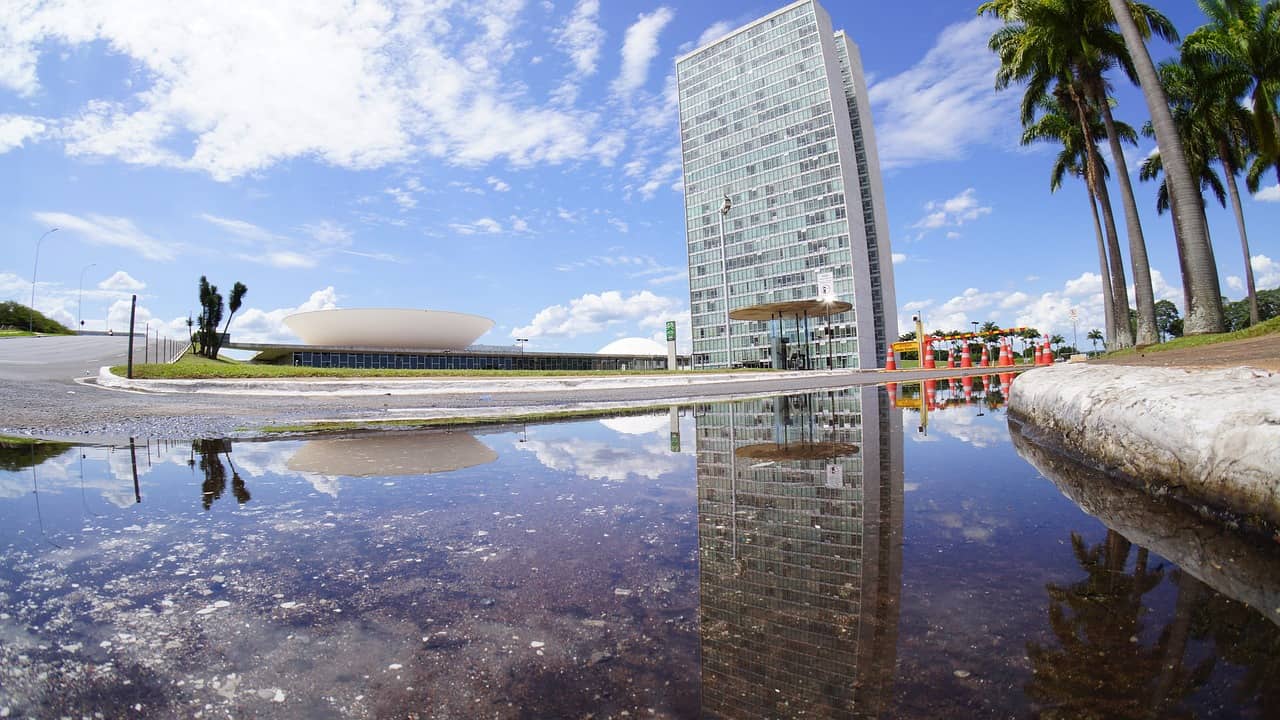
It was the capital city until the year 1960. After that , the capital was moved to Brasília in the middle of Brazil.
Rio de Janeiro City is now known as the capital of the state of Rio de Janeiro.
Spanish Is Not The Widely Spoken Second Language Or Native Language
Many tourists that arrive in Brazil are under the false impression that if they know a bit of Spanish they will be fine, yet Portuguese is official language in this country . However, most Brazilians learn Spanish and English due to the requirements of the business industries.
While Portuguese and Spanish may be fairly similar , this does not mean that speaking Spanish will automatically make traveling around Brazil easier.
In addition, the English language is not widely spoken. However, some residents in São Paulo along with a few of the more popular tourist’s destinations in Rio de Janeiro know how to speak English.
If you want to impress a few of the locals, learn a few of the Portuguese expressions.
Beer Is Always Served In Small Glasses
All over Brazil, most of the places that serve beer will do so in smaller glasses that are usually smaller than the ½ pint glasses. The idea behind this makes sense as most areas in Brazil experience heat that is extreme, and the larger glasses warm up faster.
In the bars, the beer is typically served in the 600ml large bottles served with a smaller glass that you can drink from, or in a chopp, which is draft beer served in small glasses.
The exception to the small glasses can be found in the southern parts of Brazil, where German-influenced towns serve the large-sized beers.
A Green Man At A Crossing Does Not Always Mean That It Is Safe To Cross
When in Brazil always wait for every car to stop completely before you decide to cross a road , regardless of whether there is a green man telling you are allowed to cross.
It’s common for cars to start speeding up from far away when the light has turned orange and then skip through these lights once they have turned red, which really annoys the drivers from the other junctions.
This may be classified as a general safety rule , but skipping red lights is so common in Brazil that it is something you need to be aware of.
You Can Pay Almost Everything by Debit / Credit Card – GET REVOLUT

Even tho there is a lot of fraud, Brazil is very friendly with card payments especially in bigger cities or tourist hotspots.
We recommend getting a REVOLUT card or any other similar service for full control over your card via mobile app, great conversion rates, and security.
FUN FACT: YOU CAN PAY CARPIRINHA ON THE BEACH IN RIO BY CARD! 🙂
EDITOR’S NOTE: I have my Revolut card linked to my actual account in my country. I only TOP-up REVOLUT CARD (for free) with some minimum amounts of 100 – 200 USD. Topping-up takes only a few seconds via MOBILE APP.
If I see any suspicious activity I FREEZE the card or DEACTIVATE. If I’m late, I only lose MAX of those 100 – 200 USD.
Brazil Makes Really Good Wine
The wines from France, South Africa and France might not need to be too concerned about new competition anytime soon, but the Brazilian wines, particularly the sparkling varieties like the Brut Champenoise which comes from the south of Brazil are exceptionally good.
They also have a few outstanding reds and wonderful rosés, which originate from local wineries based in Minas Gerais and Rio de Janeiro.
You should definitely pay a visit to the Winehouse and Canastra in Rio de Janeiro so that you can sample the best of the best Brazilian wines. Canastra, which is French-owned only sells Brazilian wines, while Winehouse sells both Brazilian and national wines.
Brazil Is Not Always Hot, In Some Areas It Even Snows
Brazil is a country that also gets snow. In the southern tip of the country, the temperatures plummet below freezing during the months of winter with occasional snow.
The snow is usually very light , but definitely, enough to dash your hopes of tropical, warm days.
In the north part of Brazil, the climate is tropical throughout the year, but if you are visiting the south it is very cold in winter and could come as an unpleasant surprise for travelers who only packed flip-flops, t-shirts, and shorts.
Brazil Hosts An Oktoberfest
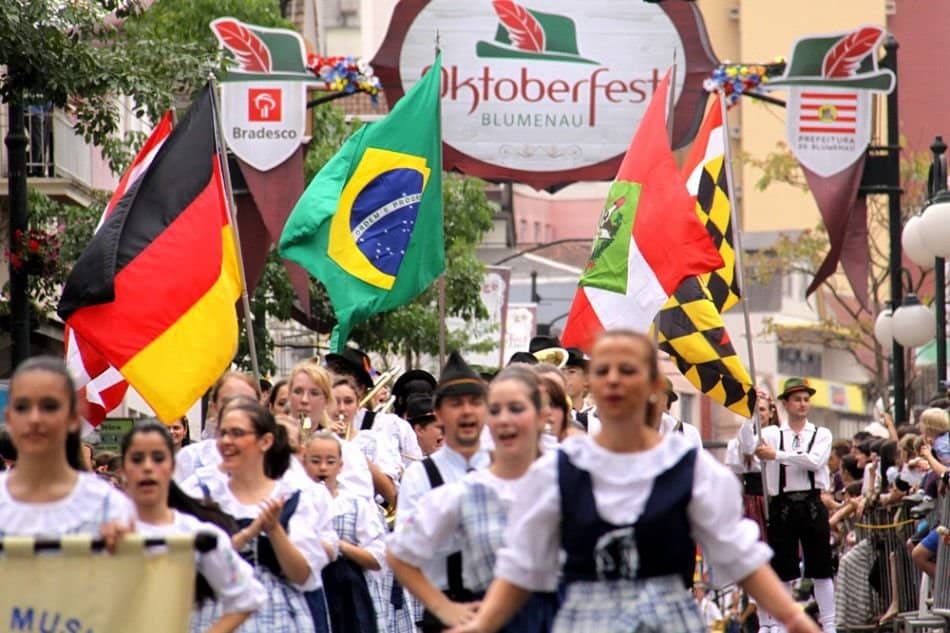
In the south of Brazil, there is significant German influence in food, architecture and traditions.
In San Catarina, every October the town of Blumenau holds a traditional celebration known as Oktoberfest. This celebration is held over a number of days that honors German heritage along with lots of beer, dancing, singing and traditional food.
This event is known as the 2nd largest beer festival across the globe , shortly after the Oktoberfest in Munich.
You May Need a Visa
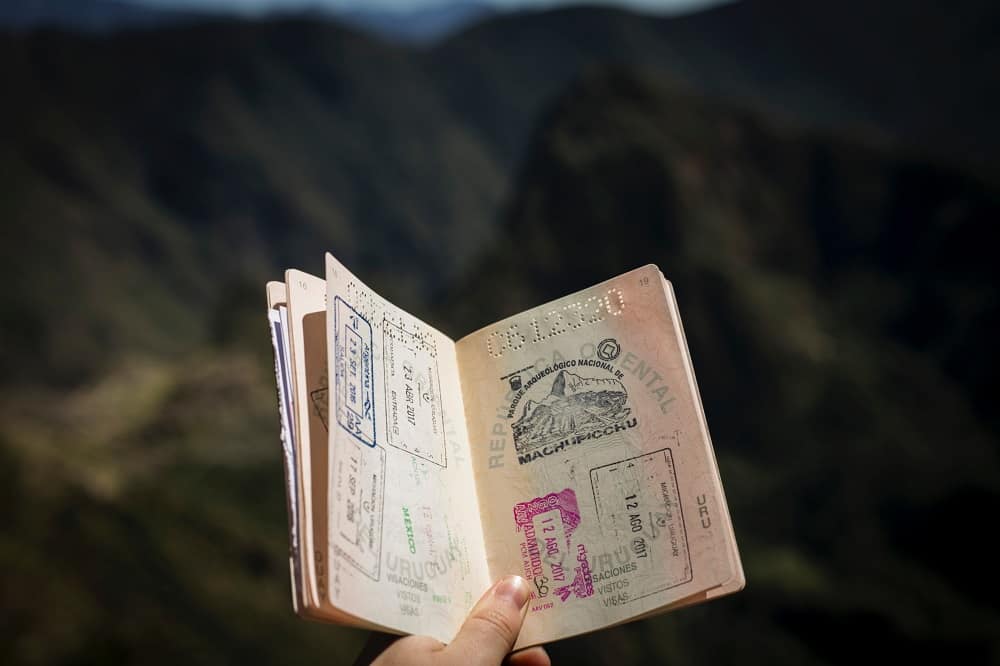
A trip to Brazil may require you to have a visa before you go. Depending on the country you are a resident in or where your passport is from, you may require a visa.
If you do so then consult the experts in this area – you will find out more if you visit the website .
The Subway Features Women-Only Carriages
Subways in the main cities offer carriages for women only, yet this rule is only applicable during the peak hours from 6am to 9 am and 5 pm to 8 pm from Monday to Friday.
If men enter one of these carriages, they could face a fine of as much as R$1,000 which translates into $320USD. Outside the peak hours, both women and men are permitted to use these carriages.
The security on these subways does not tolerate any excuses , especially since the carriages state women-only warnings that are painted in both Portuguese and English.
Avoid Going On A Jungle Trek On Your Own
The Amazon is easily the most incredible habitat in the world. It also really big and comes with potential dangers to those that want to explore this habitat alone.
If you would like to venture into this rainforest, always use reputable and qualified guides that know the risks and the paths in the Amazon. This same rule is applicable to Pantanal.
Brazil Is Usually Safe For Tourists But You Have To Be Always Very Careful
Brazil is one of the least safe countries in South America and is renowned for the bad press when it comes to violence, crime, and higher murder numbers.
However, the reality behind these statistics is mainly to do with the criminal activities between the gangs that are based far away from tourist destinations.
In general, Brazil is relatively safe for visitors and tourists. The scenarios that involve tourists usually involve non-violent pick-pocketing or muggings, but in most cases, tourists usually do not encounter these issues. It is still wise to practice precautions in the main urban areas like Salvador, Recife, and Rio de Janeiro, and safeguard your belongings.
Brazil has one of the most beautiful islands in South America
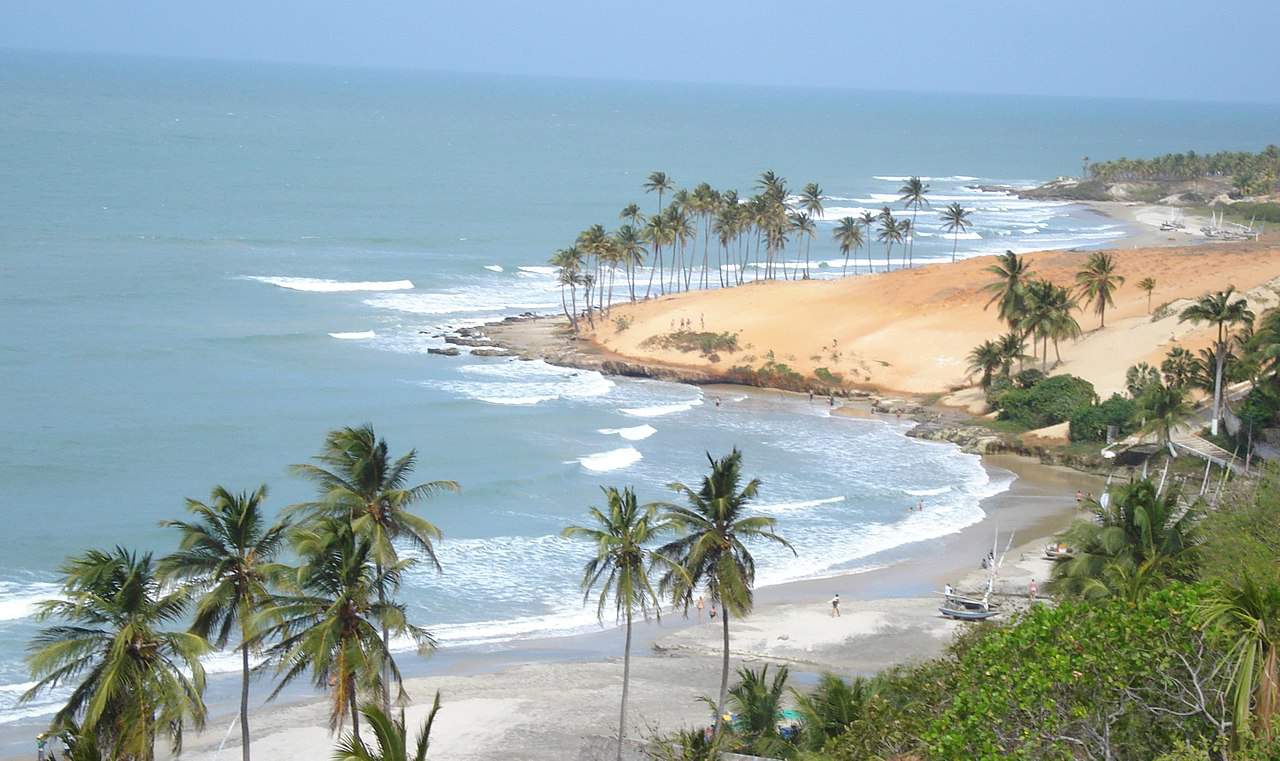
Florianopolis is a must-go when traveling in Brazil! It’s a paradise and comes with everything you can demand from the island. Floripa (as locals call it) is heaven for backpackers, travelers, hikers, party people, surfers but also a great spot for some nice family time.
EDITOR’s note: In one of our recent articles, we’ve selected 8 best beaches in Florianopolis but in total Floripa has 42 beaches around the island.
Best time to visit Florianopolis is between November and March , otherwise, the temperature is dropping down since it’s located quite south.
There are many small villages and towns around the islands where you can score some fancy hotels, affordable Airbnb’s or some amazing backpackers’ hostels with great vibes.
Brazil or Brasil? Which is right?
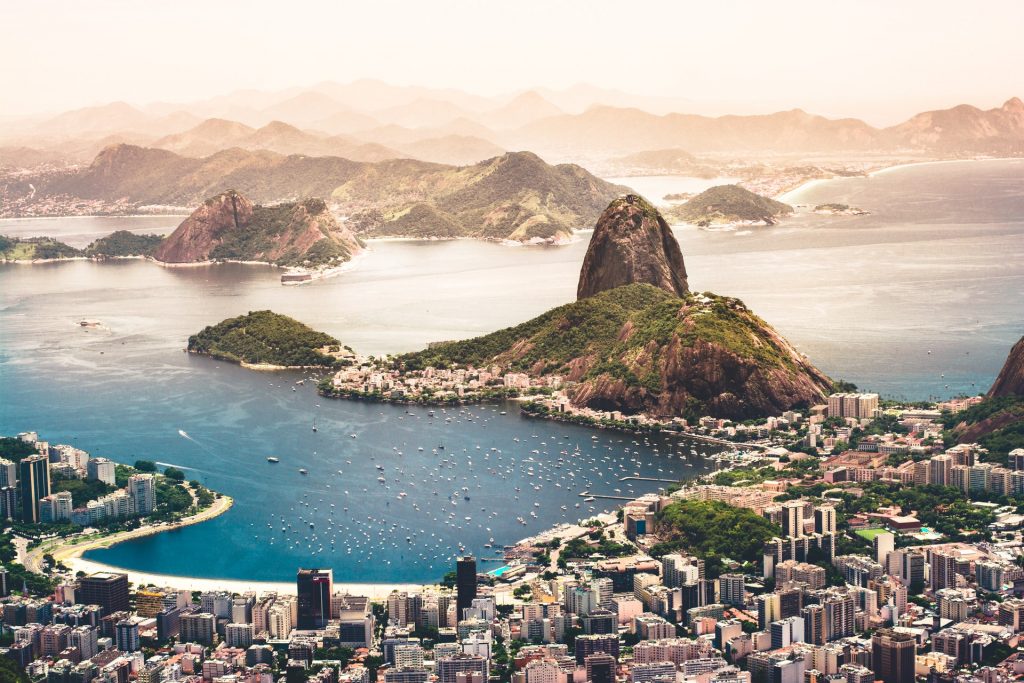
Brasil (written with S) is the official name of the country in the Portuguese language. On the other hand, Brazil (written with Z) is the English version.
Therefore, both works but if you want to be 100% correct, follow this simple rule.
Brazil Can Become Expensive
It’s often assumed that South America is a budget-friendly place to visit and in general, this is an accurate assumption. However, a few of the main cities like Rio de Janeiro and São Paulo can be costly, especially in wealthier neighborhoods like Leblon and Ipanema which are also some of the top tourist areas.
Check out our roundups of best hostels in RIO & SAO PAULO for backpackers.
Brazil is also not a country that you want to purchase electronics from. With the increased import taxes, a few items are often double sometimes even more than the price that you would have paid in Europe or the U.S. Accommodation, drinks and food are also pricey in the peak seasons like the Carnival and New Year where the prices are known to double or triple.
Avoid Hanging Your Bags Over The Back Of Chairs
Even though Brazil is regarded as safer than the press makes it out to be, theft and muggings do happen, and tourists should always be aware of this.
Hanging your belongings over a chair is not wise as it is easy for a person to grab your things and quickly run away. It is far better to keep your bag wrapped around the legs of a table or keep your belongings close to your body.
Consider Flying Instead of Traveling By Bus
If you travel outside of Xmas or Carnival, flying in Brazil can be quite affordable and cheaper than traveling by bus. Also, the infrastructure in many regions is not very developed and the travel time can be actually counted in DAYS.
You Can Drink Tap Water in Brazil, but You Won’t Like It
Drinking tap water in Brazil is safe but due to its treatment process, the taste is not very good. Therefore, most Brazilians choose to drink bottled water instead of tap water.
Book Your Taxis Through The Airport Agencies or Use Uber
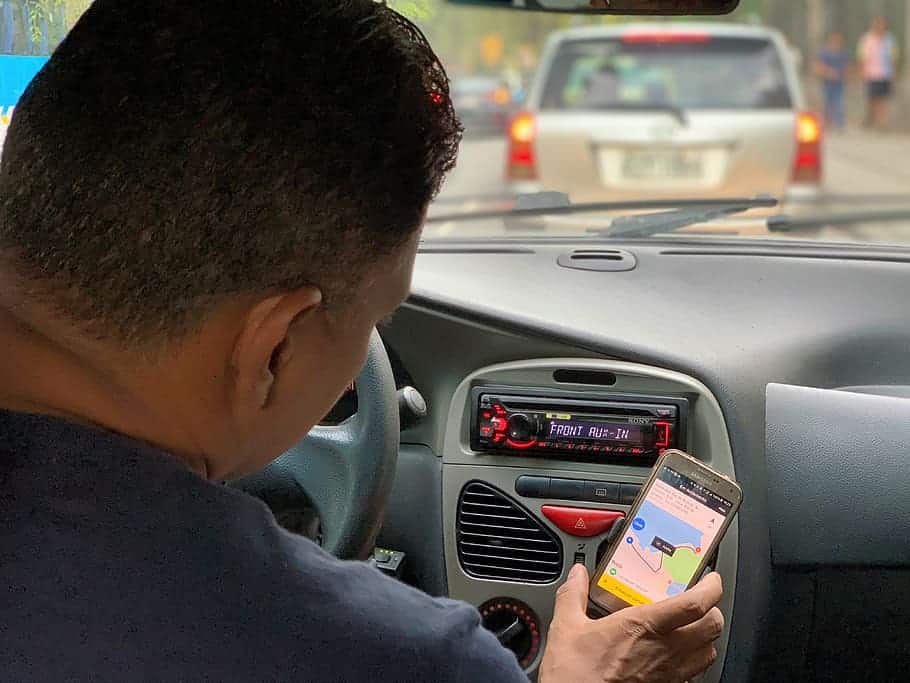
On arriving at an airport in Brazil, book your taxi through one of the agencies or call uber opposed to using the unofficial cabs . Even though it costs more, you will not be subjected to additional charges when you arrive at your destination.
There is also no change in the price caused by traffic which means you will arrive at a hotel without having to take unnecessary routes. Most of the taxi drivers are regarded as honest, yet there are a few that will take advantage of a foreigner that lacks local knowledge.
You can avoid these issues by booking your taxi through the airport agencies or getting a SIM card with data and calling yourself uber.
Brazil has the biggest carnival in the world
Rio Carnival draws 2 million people to the streets of Rio de Janeiro to enjoy dancing, music, and parades in amazing carnival costumes.
During Carnival, the most famous and largest carnival celebration in the world , street parades, blocos and bandas take place all over Rio. At any given time, there could be more than 300 bandas playing music.
Kissing strangers is customary
In Brazil, getting to know people is a quick process. Brazilians have an easier time breaking through the emotional gap since they don’t value personal space.
When a male is introduced to an adult female, it is usual for him to kiss both cheeks – and then go.
Body language is as crucial as Portuguese in this context.
Guys aren’t scared to wrap an arm around another male in order to stress a point.
A touch on a shoulder, a bear hug, and a salvo of air kisses are all part of an intricate social dance that culminates in a welcoming environment for visitors.
I wish to travel to Brazil with my girl friend. I wish if a local person can give me a letter of invitation. Any help here?
Hi, the best bet would be to reach out to a few hostels or hotels in Rio de Janeiro or Sao Paulo.
Hi! I’m a Brazilian student — I’ve never been to Mato Grosso, but i think I can guide you a little! I dont’ know if you’re American, but if you are, you should know that in Brazil, high school is only grade 10, 11 and 12! Grade 9 is part of elementary school, which we call “ensino fundamental”. Usually our public schools aren’t that good, and only upper middle class gets to have a good education, but there are some exceptions, especially in São Paulo and Brasília. You usually start a grade on January, February or March and finishes it on November or December — basically, every year is a different grade. We have a lot of love for tourists, who we call “gringos” and also a lot of local slang. Sometimes, if you are southern, there’s a chance you won’t fully understand what a northern teenager is saying. We’re very diverse, loving and very touchy — don’t be scared! People view hugs and kisses on the cheek as a way of saying “hello” and “goodbye”, but if you feel uncomfortable, you should know you are not obligated to kiss every person you meet as well! We have lots of love for Brazilian music, like funk, sertanejo and pagode. Our public universities are the best in Latin America. You get in usually by taking ENEM, which is an exam close to SAT. It basically tests your level of knowledge on subjects you learnt in high school. Overall, I think you’ll love it! I know I do, lol. It really isn’t THAAAT dangerous. I’ve actually never been robbed or mugged, but I have to say that I’m very privileged and have only lived in areas that are commonly known as safe areas. You shouldn’t be scared, cause people will help you and have empathy, especially teachers. High school is still very stressful and very hard to keep up. In Brazil, every class is mandatory. We usually study Philosophy, Chemistry, Physics, Portuguese (literature and grammar), English, PE, Math (algebra and geometry, they’ll usually be different classes w/ different teachers), History, Geography, Arts, Biology, Sociology and maybe Spanish. School usually starts at 7am and ends at 1pm, but it differs a lot. I hope you have a good year and a good education. Thank you for giving us a chance and sorry for my bad English!
Hey. I’m going on an exchange to Brazil 2021. Can someone please give me tips about high school in Brazil and a state named Cuiabá!?
King regards
Hi Marie, I’m not sure if you saw but Sofia posted some advice on your question in the comments. Have a look.
hi, my name is Clara and I’m very happy to read your article. So I’m brazillian and I know that Brazil can be dangerous but is not in every place, there are som many places that can be safe for tourists and natives, like north coast of Sao Paulo is so safe, but is too expensive(I know this ’cause I live there). And you forgot to say about Maresias beach at north coast of sao paulo, it is so famous ’cause of surf competions and of “Instituto do Gabriel Medina” a very famous profesional surfer who won so many cpmpetions. And about you say that english is not a second language at Brazil, but here haves a lot of people who speakes english, like me, and also i’m 13 and I learned english at my school and a little be of spanish. thanks!
Thanks for the feedback. I think would be definitely a good idea to add list of safe places such as Porto de Galinhas, North of Sampa, Florianopolis and other examples. But the idea is to keep people aware of a situation which eventually makes travelers cautious.
Can you tell me if Salinas is safe for tourists? It appears a bit off the beaten path. Thanks
Hi Mike, to be honest, I don’t know. I suggest reaching out to some of the hostels in Salvador or Belo Horizonte (via email or FB page) and ask for them for the advice. For example: https://www.facebook.com/thehostelsalvador
Very informative guide. I’ve heard of Oktoberfest Blumenau before and was about to book a trip for October 2020. How much is Brazil affected by coronavirus? Do you think it’s reasonable to make any travel plans for this year? Also, I’d like to know more about the women-only carriages in the subway. It sounds like a serious matter. Does it apply to tourists too? Will it create lots of inconveniences if I visit with my husband and son? Should we better opt for other means of transportation? Thank you.
Hi, my personal opinion would that by October we should be over with Corona. But who knows. Do not rush your plans and wait until August at least. Don’t worry about the metro, people are easy-going.
Hi i am from india I like to purchase carnival dress for re-sale purpose. Where can i purchase at low price& when to visit.please reply. Thanks.
Hi, we recommend checking out Guide to Dressing for Carnival in Brazil post https://theculturetrip.com/south-america/brazil/articles/a-guide-to-dressing-for-carnival-like-a-local/ . Carnival season is during Feb / March across the whole country.
Hi… Nice tips… May highlight some points? About english speakers, it’s a little bit common find brazilians in Rio and São Paulo, in the Capital City Brasilia who speaks english. It’s a secondary language in brazilian’s high school. In Rio, Ipanema isn’t the safest neighboorhood at all!! It is Barra da Tijuca, which receives nearly 50% of the tourist nowadays, because safety.. Leblon still the most glamourous spot in Rio, Ipanema the most popular as Copacabana as well, but they requires more carefull.
Hi, thanks for your input. I agree that Barra da Tijuca is a great place and very safe but a bit outside of RIO. We’ll mention in the next update of this article.
Hi this is thé first time i go to south america and i will go to brazil in february basicaly i planned things in a way to be kind of i volved in à humanitarian project i wanna see almost many things but im travelling solo and getting really scared bexquse every single person i know ask me to not do it alone so i was glad readibg your article thank you do u have other recommandation for me ? I will be in Sao Paolo Rio and olida
You will be fine. Brazil is dangerous but you can get by easily and safe by using common sense. 1. don’t walk at night around too much 2. use uber 3. know where you going 4. ask locals at the reception of your hotel/ hostel 5. be aware of your surroundings 6. don’t make yourself a target by using a phone on street too much, don’t wear jewelry and watch. Brazil is an amazing place, you gonna a great time! It’s good to be warned by friends but it’s not a reason NOT TO GO.
I WANT TO GO BRAZIL HOW SHOULD I APPLY TO GO BRAZIL FOR FEW DAYS I WANT TOURIST VISA AND COUSIN BROTHER WAS THIER ONLY IN RIO DI JENERIO
Hi, it really depends on your nationality. Check-in google if you are required for visa or not 😉
Im going to Brazil in Nov. for 10 days. Not too sure how much money should I exchange in Canadian. For me mostly i spend on food/drink, not too much on the shopping side. Hotels already paid for it.
It’s difficult to say since I’m not sure how long you are planning to stay and what type of traveler you are. But your best bet is at least cash as possible. Get a hundred bucks on you and that’s it, just in case.
ONE THING that surprised me in Brazil was how easy is to pay everywhere by card. It’s all around, even beach sellers carry terminals. I was using REVOLUT, which is super fast, easy and safe. You can block it anytime on your app and it gives the best (middle exchange rate). We wrote more about REVOLUT card in this article: https://www.travelinglifestyle.net/best-travel-websites-budget-travellers/
How much is the sour honey in Brazil
Hi, that’s a tricky question 🙂 I would suggest going to “Expats in Sao Paulo” facebook group and ask there. Or look for any English speaking FB community and I’m sure they will be able to help you. An alternative could be also contacting some Pharmacy in Brazil.
We are travelling to Brazil in November for a wedding in Maceio Our travel agent has only booked flights for us to Recife from Australia and we wanted to know if it is safe to go by bus from Recife to Maceio and can you recommend a bus company
Hi, try not to look too “fancy” around Recife, more like a backpacker and use uber. Recife is not safe but doable, I spent there 3 weeks and nothing happened. For the bus, I only see “Real Alagoas”. That should work fine. Do it in the day time. Those places by the coast where you going should be very safe. I was in Porto de Galinhas and that was 100% safe area.
Going to Brazil to visit wife’s family. Would you recommend getting a SIM card from a local carrier there or pay for international calling on my mobile plan here in the states?
Yes, getting a SIM card is a better / cheaper option. Might need to speak some Portuguese to be able to manage that. Just get few GIGAs and you will be fine.
Is Leblon safe to walk around at night? We are staying at Rio Gran Sheraton for two nights only and will want to go out somewhere for a evening meal. What clothes will I need early December… is it hot?
Leblon is safe but after dark, you should be careful, the same as everywhere in Brazil. Take an uber, it’s inexpensive.
December is really really hot, so you won’t need any warm clothes.
Hi which neighborhood is the safest in Rio de Janiero thanks.
I would say Ipanema is the safest! But at night you have to be careful everywhere 😉
Hello Viktor! Nice artcle, I’d just like you to know that Canadians and American citizens doesn’t need a visa to Brazil anymore. Have a nice week!
Thanks for the update! Will include it.
Thank you for shring the info. We’re planning to travel Brazil this coming August. We love to stay in a really nice ocean view accomm and with a good nightlife closed by, drinking an ice cold beer in a local bar. Do you have any recommendations? Is brazil safe for us tourists?
Hi, absolutely 🙂 Go to Porto de Galinhas in the North or try Florianopolis in South. Both very safe.
Great article, Viktor! Another very important thing to know before travelling to Brazil is that Florianopolis is an amazing city and you gotta visit it! Taking a bus in Sao Paulo, they are only 9 hours of trip… in this site you can buy bus tickets https://brazilbustravel.com/from-florianopolis-sc . I guess you will enjoy it. Nice travels!
Comments are closed.
Couple in Brazil Planted More Than 2M Trees in 20 Years To Recreate Forest?
In 1998, photographer sebastião salgado and his wife lélia embarked on a remarkable journey to revive the ecosystem in a part of brazil., nikki dobrin, published april 24, 2024.

About this rating
While it's true that a couple in Brazil planted more than 2 million trees over a 20-year period, they reportedly received help from local students and workers to accomplish the task.
In 2019, an aerial view captured the lush greenery of Instituto Terra 's tree nursery, nestled in Aimorés, Brazil. This land, once devastated by erosion and deforestation from cattle farming, now stood as a testament to the power of reforestation efforts.
Tributes to the tree nursery garnered widespread attention on social media platforms such as Facebook and Reddit , where posts claimed that a Brazilian couple planted 2 million trees to recreate the forest.

( visuraXD /Reddit)
The claim that this couple planted more than 2 million trees over a 20-year period — albeit with help reportedly from local students, hired workers , donations from multinational corporations, plus financial support from the government — holds true.
In 1998, award-winning photographer and photojournalist Sebastião Salgado and his wife, Lélia Deluiz Wanick Salgado, founded Instituto Terra, a federally recognized nature preserve and nonprofit organization, thus embarking on a remarkable journey to revive the ecosystem.
The roots of this endeavor trace back to the mid-1990, shortly after Salgado's return from a photo assignment covering the genocide in Rwanda, and the couple's acquisition of the cattle ranch reportedly purchased by Sebastião Salgado's father in the 1940s.
"The land was as sick as I was – everything was destroyed," Salgado said at a Paris climate change meeting in 2015, according to The Guardian . "Only about 0.5% of the land was covered in trees. Then my wife had a fabulous idea to replant this forest. And when we began to do that, then all the insects and birds and fish returned and, thanks to this increase of the trees I, too, was reborn – this was the most important moment."
According to Smithsonian Magazine , replanting the farm with trees was Lélia's idea. "There was no hidden agenda," she told the outlet in 2015. "It was so natural, instinctive. The land was so degraded, so horrible. What a bad gift! Why not plant?"
Over two decades, the Salgados transformed barren landscapes into thriving forests by planting millions of seedlings, starting with an initial donation of 100,000 seedlings from a local mining company. This monumental effort aimed not only to restore the ecosystem but also to produce plants and trees that would be a natural habitat for native fauna including birds and insects.

Nov. 2019, aerial view of the Instituto Terra tree nursery in Aimorés, Brazil. (Getty Images)
The transformative impact of the Salgados' efforts is documented in various sources. Earth Observatory , a NASA initiative dedicated to sharing images and stories about the environment, Earth systems and climate research, highlighted the couple's role in reforesting and the restoration of degraded ecosystems.
Numerous sources corroborate the remarkable achievements of the couple, with their story garnering attention from media outlets worldwide, including the Daily Mail and DeMilked , which chronicled the couple's two-decade journey to transform the barren ranch into a thriving habitat for wildlife and biodiversity conservation.
Visual evidence of the couple's achievements can be found in a YouTube video showcasing the lush greenery that now blankets the once-devastated landscapes, showcasing the couple's transformative impact on the landscape.
The pioneering efforts of the Salgados' initiative in reclaiming lost forests and combating deforestation not only contribute to environmental conservation but also serve as a source of inspiration for individuals and organizations worldwide to take action.
Snopes has previously reported on environmental issues in Brazil, including a Swedish multimillionaire purchasing around 400,000 acres of Amazonian rainforest , and claims that a logger cut down the world's oldest tree .
A New Patch of Green in Brazil . 23 July 2019, https://earthobservatory.nasa.gov/images/145324/a-new-patch-of-green-in-brazil.
"Brazilian Couple Plants Over 2 Million Trees To Restore A Destroyed Forest." AA Environment Possibility Award , https://www.ep-a.org/trend/en/brazilian-couple-plants-over-2-million-trees-to-restore-a-destroyed-forest. Accessed 19 Apr. 2024.
Chronos. THIS COUPLE FROM BRAZIL PLANTED 2.7 MILLION TREES! AND HERE'S WHY . 2021. YouTube , https://www.youtube.com/watch?v=FJ9YxXauP1M.
"Instituto Terra." Instituto Terra , https://institutoterra.org/.
Log in or Sign up to View . https://www.facebook.com/login/. Accessed 19 Apr. 2024.
Magazine, Smithsonian, and McKenzie Funk. "Sebastião Salgado Has Seen the Forest, Now He's Seeing the Trees." Smithsonian Magazine , https://www.smithsonianmag.com/arts-culture/sebastiao-salgado-forest-trees-180956620/. Accessed 19 Apr. 2024.
ORFL. Instituto Terra – ORFL . 13 Sept. 2022, https://www.orfl.org.hk/instituto-terra/.
Reforestation Institute Finds Room to Grow . https://www.ecoamericas.com/issues/article/2020/3/444CA184-06F2-48E9-8AC1-4AF8245EA4C9. Accessed 19 Apr. 2024.
Uptas, Aušrys. "This Couple Planted Over 2 Million Trees In 20 Years And Made The Animals Return To The Forest." Demilked , 24 Apr. 2019, https://www.demilked.com/couple-replant-forest-sebastiao-leila-salgado-reforestation/.
Vidal, John. "Sebastião Salgado Focuses on Big Picture with Parable of Reforestation in Brazil." The Guardian , 27 July 2015. The Guardian , https://www.theguardian.com/global-development/2015/jul/27/sebastiao-salgado-fredrick-shoo-reforestation-brazil-tanzania.
Wingate, Sophie. "Brazilian Photographer Transforms Barren Ranch into Tropical Paradise." Mail Online , 3 June 2019, https://www.dailymail.co.uk/news/article-7099537/Brazilian-couple-spends-20-years-planting-trees-barren-ranch-create-paradise-animals.html.
By Nikki Dobrin
Nikki Dobrin is based in Los Angeles and has previously worked at The Walt Disney Company, as well as written and edited for People, USA Today and The Hill.
Article Tags
More From Forbes
Brazil explored: immersive trips, diamond trails and long-lost tales.
- Share to Facebook
- Share to Twitter
- Share to Linkedin
There’s never been more interest in actual, genuine off-the-beaten-path travel than now. More and more tourists are searching out escape from the everyday—trips with fewer people, less (or preferably no) technology, and an opportunity to recalibrate and experience something authentic and life-affirming.
Stepping into the market with an offering that undoubtedly fits that definition is Gift of Go , who have launched an inaugural series of explorations into Brazil’s most remote and extraordinary regions for 2024.
Disappear into one of the planet's most biodiverse and least visited places.
Kicking things off is An Exploration of the Highlands of Brazil . A 14-day, 125-mile journey into the majestic Serra do Espinhaço departing on May 6th, a maximum of eight travelers and 10 expedition crew will trek, horseback ride, boat, bike, bushwack and overland their way across a labyrinth of lost historic trails and backroads in one of the planet’s most ecologically diverse places.
The trip promises Seussian landscapes, colonial villages and quilombos (former slave settlements), white sand beach fringed waterfalls, cola-colored rivers, bubbling hot springs and barely-visited UNESCO World Heritage sites. It will culminate at a famed Vesperata celebration in Diamantina, the UNESCO “city of diamonds.”
Journeys will lead to places of tranquility and solitude and beauty.
The Trump Media Stock Price DJT Is About To Adjust Down By 22 7
Sh gun episode 10 review a powerful finale but not what i was expecting, ukraine strikes russia with long range bomber balloons.
The Serra do Espinhaço was once the epicenter of the world’s diamond trade but has been abandoned and largely forgotten about by the outside world for close to 200 years. It’s home to three UNESCO destinations and two globally-renowned biodiversity hotspots in the Brazilian Savanna and Atlantic Rainforest. Yet despite this, its largest conservation unit at the Sempre Vivas National Park receives only a handful of visitors each year, and most of those are from the scientific community. What that effectively means is that, from a tourist perspective, you’ll have the place to yourself.
Experiences are broken up into four chapters. The Serra take visitors on an epic trek through the mountains. The Garden navigates Brazil’s hinterland of big cats and sharp plants, disappearing trails, forsaken ranches and disputed lands by pack-mule and jon-boat. The Sertão brings travelers to the lowlands along miles of open road to festive cow towns and legendary hospitality. Lastly, The Berço is the cradle, dramatic landscapes that lead to tales of hardship and glory and at its end, the slave-built highway that cascades into Diamantina.
Experienced local guides lead the way along often invisible trails.
Gift of Go will lead a collection of curated trips over the year. At 14, 21 and 28 days in length, they are meticulously researched and curated; designed to create deeply immersive, enriching experiences that are as demanding as they are rewarding and that have the power to change how we see the world.
In this sense, Gift of Go is pitching the trips less as vacations and more as immersive stories—more purposeful than recreational, more exhilarating than relaxing. Expect to be challenged by a diverse landscape of cultures, geographies and historic realities through constant immersion and candid, uncurated conversations and interactions with local people.
From highland to lowland, mountain to cradle, guests will hike, ride, bike and bushwack to their ... [+] destination.
In the press release for their first experience, cofounder Eddie Lott notes that, “We are living in the Golden Age of picture-perfect places, carefully-crafted ‘authenticity’, and readily-collectible ‘once-in-a-lifetime' experiences. GOGO trips are different—in our minds, there is simply nothing more compelling, profound, or enriching than experiencing real life in a world far from our own."
Gift of Go slow travel experiences kick off in 2024 on May 6th and run across several months throughout the year. For details, check the 21-day A Diamantine Tale and epic 28-day Diamond/Wild Tales + Lost Trails . A limited number of bespoke itineraries are also available.
- Editorial Standards
- Reprints & Permissions
'Taking care of our own': New TTUHSC dean shares goals, talks future of medical school

Traveling to the second floor of the Texas Tech University Health Sciences Center's original building, one will find the dean of the School of Medicine's office. It's a space that has a history of housing both deans and presidents of the university and now welcomes its newest occupant.
Having been named dean and executive vice president of the TTUHSC in February, Dr. John DeToledo's office sits bare except for a few knickknacks scattered throughout the space — a reflection of the humble and soft-spoken occupant.
Before being named to his new position, DeToledo's journey in medicine started decades ago, 5,359 miles south of Lubbock.
Journey from Brazil to Lubbock
DeToledo is a native of São Paulo, Brazil and comes from a long line of family physicians. He said it was only natural for him to attend São Paulo Medical School. He graduated in 1980 but didn't stay there for his residency training. Instead, he moved to Boston.
"I was an exchange student when I was 15 and I lived with a wonderful family in Michigan and I really enjoyed the experience," he said of his previous experience in the United States. "Specializing in this country would open doors for me ... I would not have that same kind of opportunity if I stayed in Brazil for my specialty training."
Gaining a spot at Columbia University for internal medicine, DeToledo crossed paths with his future predecessor — Dr. Steven Berk, who at the time was a doctor in Boston.
It was also during this time that DeToledo said he switched specialties from internal medicine to neurology.
"Neurology is rarely a love at first sight," he said. "Neurology, more often than not, is an acquired taste."
DeToledo said that 3% to 5% of a medical school students have an interest in neurology, which usually stems from undergraduate work done in the field. However, for him, it was different.
"There are some of us that they start in medicine and they find an affinity with the disease of the central nervous system and it's almost as if it clicks," he said. "It becomes effortless to make those connections."
Having switched fields, DeToledo gained additional training at Boston University and the Boston City Hospital and went on to complete his fellowship in epilepsy and neurophysiology at the Oregon Comprehensive Epilepsy Program.
Following his fellowship, DeToledo stayed as the Cornelia Wheeler division chief of Epilepsy until 1992, when his adventure took him to the nation's capital.
"I came to George Washington (University) as a junior professor," he said.
While in Washington, D.C., DeToledo ultimately became the chief of the Division of Epilepsy and Neurophysiology and the Neurology Residency Program Director at WGU, but his adventures were about to go abroad once more.
"I was invited to work in Saudi Arabia - in Riyadh - with King Faisal hospital," he said.
During his six-month stint there, DeToledo helped establish the Epilepsy Program at the King Faisal Specialist Hospital. He returned to the United States to serve as the co-director of the International Center for Epilepsy at the University of Miami in Florida.
That's where he met his wife, and the two would continue their journey together.
DeToledo moved to North Carolina to be Wake Forest University's chief of Epilepsy and Neurophysiology and the chief of the Magnetoencephalography Laboratory. That's when he received a call from an old friend — Dr. Berk - who was recruiting him to TTUHSC.
"When I received the invitation to come and visit, it was primarily because he was here that I came. I did not know much about Texas Tech or Lubbock," he said.
But after visiting Lubbock, DeToldeo said he and his wife agreed Lubbock was unique and appealing to them.
"The commitment of this community to support the university, to support the medical school — the pride that our people have in this school — really impressed me," DeToledo said. "I was invited to join a reception where there were some local people, and they were so proud of Texas Tech. I said, 'Wow, this is so different.'"
DeToledo joined TTUHSC as the Vernon & Elizabeth Haggerton chair of Neurology in 2009.
During his tenure, DeToledo went on to chair the Medical Practice Income Plan and serve as the Chief of Staff at the University Medical Center, along with serving in a position that helped prepare him to take the reins of the medical school.
"Dean Berk offered me the opportunity to become a vice dean for the School of Medicine," DeToledo said. "From that time on, I spent more time with him and being part of discussions about the vision, about the future, about the strategies for the medical school."
DeToledo went on to be named by the TTUHSC's President's Office as acting dean of the School of Medicine from December 2021 through February 2022 after Berk had suffered a medical emergency.
On May 26, 2023, Berk died suddenly after serving as the dean of the School of Medicine for 17 years. The search was on to find who would fill his shoes.
TTUHSC President Lori Rice-Spearman again looked to DeToledo and named him interim dean that same month.
After a nationwide search that resulted in nearly 25 candidates, TTUHSC announced in February 2024 that DeToldeo would be the new dean.
"We are fortunate to have Dr. DeToledo continue in this leadership role for the School of Medicine,” Rice-Spearman said at the time. “He has a great commitment and philosophy to academic medicine that reflects our TTUHSC values-based culture, and he brings a wealth of expertise to the table for an academic health institution as a clinician, clinic manager and physician-scientist.”
According to TTUHSC, DeToledo is tasked with leading faculty and staff in strategic planning, securing resources, and implementing and evaluating activities related to the academic, research, service and patient care operations.
“As an established educator, physician and chairman, Dr. DeToledo has a strong understanding of the School of Medicine and its clinical practice,” TTUHSC Provost and Chief Academic Officer Darrin D'Agostino said after DeToledo was named dean. “He is a respected leader committed to preparing the next generation of clinicians and providing exceptional health care for the communities we serve.”
The vision of the new dean
"The dean very often imparts part of his personality to the rest of the School of Medicine," DeToledo said.
As a regional medical school, DeToledo said he wants TTUHSC to attract students from around the nation but focus on reaching out to local students.
"This is home for them, to come to learn from us, and then to go back to our community and serve in the community," he said. "We pride ourselves in attracting a large number of first-generation physicians."
DeToledo said he will also champion the school's tradition of creating the best primary care physicians in the nation—an accomplishment that Ivy League schools have yet to achieve.
"Texas Tech ranked 19th in the country, in this in this field, and we are very proud of this," De Toledo said smiling.
Having a solid foundation in primary care allows physicians to expand their skills and knowledge to other specialties, DeToledo said. However, primary care is not the only thing TTUHSC wants to be known for.
"What we are now wanting to bring to West Texas is state-of-the-art cancer treatments," he said.
On Thursday, University Medical Center announced the groundbreaking of the new cancer center through a partnership between TTUHSC and the TLC2 Foundation to bring new treatments to West Texas and further cancer research.
More: UMC, TTUHSC break ground on new TLC2 Foundation Cancer Center in Lubbock
DeToledo said the field of medicine changes every five to eight years, with the principles of the field staying the same but the understanding of how the body operates changing.
"So a challenge that we all have is how to keep our are medical school curriculum relevant," he said. "We are committed to provide state of the art, up to date information to our learners so in order to prepare them to be successful when they graduate."
Asked what he wants to emphasize from his goals for the medical school, DeToledo's answer was simple — collaboration. He said he wants to ensure that everyone at TTUHSC works together to improve not only their learning experience but also patients' health and the healthcare field in general.
And one guiding philosophy and commitment will help DeToledo during his tenure as dean, he said.
"Texas Tech is entirely committed to this region, it's entirely committed to our people, it is entirely committed to improve the health of our own in urban areas and rural areas," DeToledo said. "We are laser-focused in taking care of our own, in giving back to our people, because they are so incredibly generous with us."
Javascript is currently disabled in your browser. Please enable Javascript, or use an alternative browser.

A Dentist’s Journey to Save Your Teeth: From Brazil to Biotech Breakthrough
Doe user program helps even non-scientists develop and study new materials..

While teaching in Oklahoma, a Brazilian dentist began pursuing his idea for a new technology that would ultimately lead him to eastern Tennessee. There he had access to the discovery science expertise and world-class research facilities at Oak Ridge National Laboratory (ORNL). He used these resources to develop and test his breakthrough: the world’s first long-acting antibacterial adhesive resin for dental restorations.
The dentist, Fernando Luis Esteban Florez, a tenured associate professor and researcher at the University of Oklahoma College of Dentistry, is working to prevent the secondary tooth decay that bacteria cause around the edges of dental restorations, such as fillings and crowns. These secondary cavities are why most restorations need to be replaced on average every five to seven years.
“My idea was to develop dental adhesives that would provide long-term protection from oral bacteria,” said Esteban Florez, the lead inventor. “In the U.S. alone, a long-acting antibacterial dental adhesive could help prevent more than 60 million dental procedures per year and save patients over $5 billion annually.
“But as a dentist with limited training in scientific research, developing and testing my idea for antibacterial nanoparticles and putting them in a clinical product seemed out of reach.”
Esteban Florez and Sharukh Khajotia, the college’s associate dean for research and innovation and a co-inventor, learned about the Office of Science user facilities operated by the Department of Energy (DOE) operates. These 28 user facilities, located at national laboratories nationwide, provide state-of-the-art research facilities to the global science community at little or no cost to users.
“I’m grateful for the DOE’s user program, which enabled me, a dentist without advanced scientific training, to access the world-leading expertise and resources at Oak Ridge National Laboratory. It saved me six to eight years of development time.”

Esteban Florez and Khajotia submitted a user proposal to ORNL to work with scientists at the Center for Nanophase Materials Sciences (CNMS) and the High Flux Isotope Reactor (HFIR), both of which are DOE user facilities.
With the help of the world-class researchers at these nanomaterials and neutron science facilities, the co-inventors created multifunctional nanoparticles with long-lasting antimicrobial properties that can be added to resins and other polymers used in medicine, dentistry, public health, and engineering.
The team modified titanium dioxide nanoparticles that produce highly reactive chemicals, known as reactive oxygen species, that can kill bacteria, viruses and other microorganisms. Unlike with antibiotics, microbes cannot develop resistance to these chemicals.
The nanoparticles were then dispersed in an adhesive resin commonly used by dentists. Researchers examined samples of the experimental adhesive resin using a helium-ion microscope at CNMS and small-angle neutron scattering using the Bio-SANS instrument at HFIR to determine the optimal particle shape, modifications, and dispersion method.
“The benefit of using Bio-SANS is that it allowed us to see how the proteins bonded to the nanoparticles and how well the particles dispersed within the polymer resin,” said Khajotia.
According to Esteban Florez, the experimental results showed that for the first time in dentistry, nanoparticles had dispersed without clustering and functioned well within a polymer and displayed strong antibacterial properties without light irradiation.
“We are currently talking with a leading dental products company about commercializing this patented technology for a wide range of products,” said Esteban Florez. “This extremely versatile antibacterial and antimicrobial polymer technology can work in countless applications, including dental restorations, teeth whitening products, medical devices and equipment, and in paint on surfaces throughout public places, such as at hospitals and airports, to reduce levels of bacteria and viruses.
This article was created in partnership with Oak Ridge National Laboratory, learn more about their work .
Read more stories in the Basic2Breakthrough series.
Leaving Office of Science
The link you have requested will take you to a website outside the Office of Science.
Please click the following link to continue:
Thank you for visiting our site. We hope your visit was informative and enjoyable.
Bakers, Baristas and the Journey to ZooMed VetFolio Voice
Whatever she has accomplished — moving from Brazil to the U.S., transitioning into ZooMed, founding Vetahead — Dr. Lyla Proença has made a leap of faith and deep passion to pursue her dreams. In this episode of VetFolio Voice, Dr. Proença shares her journey of validating her veterinary diploma in the United States after moving from Brazil. She reveals the work, sweat and tears, and even how she considered changing career paths, which led her to ZooMed and the founding of VetAhead. Dr. Cassi and Dr. Proença discuss the core values that are the foundational support of VetAhead, the importance of access to knowledge for all veterinary professionals, and access to care for all species. They cover the importance of critical thinking when it comes to managing exotic species and the importance of recognizing and preserving the human animal bond with species beyond just dogs and cats.
- Episode Website
- More Episodes
- All rights reserved
Top Podcasts In Education
- Share full article
For more audio journalism and storytelling, download New York Times Audio , a new iOS app available for news subscribers.
The Evolving Danger of the New Bird Flu
An unusual outbreak of the disease has spread to dairy herds in multiple u.s. states..
This transcript was created using speech recognition software. While it has been reviewed by human transcribers, it may contain errors. Please review the episode audio before quoting from this transcript and email [email protected] with any questions.
From “The New York Times,” I’m Sabrina Tavernise, and this is “The Daily.”
[MUSIC PLAYING]
The outbreak of bird flu that is tearing through the nation’s poultry farms is the worst in US history. But scientists say it’s now starting to spread into places and species it’s never been before.
Today, my colleague, Emily Anthes, explains.
It’s Monday, April 22.
Emily, welcome back to the show.
Thanks for having me. Happy to be here.
So, Emily, we’ve been talking here on “The Daily” about prices of things and how they’ve gotten so high, mostly in the context of inflation episodes. And one of the items that keeps coming up is eggs. Egg prices were through the roof last year, and we learned it was related to this. Avian flu has been surging in the United States. You’ve been covering this. Tell us what’s happening.
Yes, so I have been covering this virus for the last few years. And the bird flu is absolutely tearing through poultry flocks, and that is affecting egg prices. That’s a concern for everyone, for me and for my family. But when it comes to scientists, egg prices are pretty low on their list of concerns. Because they see this bird flu virus behaving differently than previous versions have. And they’re getting nervous, in particular, about the fact that this virus is reaching places and species where it’s never been before.
OK, so bird flu, though, isn’t new. I mean I remember hearing about cases in Asia in the ‘90s. Remind us how it began.
Bird flu refers to a bunch of different viruses that are adapted to spread best in birds. Wild water birds, in particular, are known for carrying these viruses. And flu viruses are famous for also being shapeshifters. So they’re constantly swapping genes around and evolving into new strains. And as you mentioned back in the ‘90s, a new version of bird flu, a virus known as H5N1, emerged in Asia. And it has been spreading on and off around the world since then, causing periodic outbreaks.
And how are these outbreaks caused?
So wild birds are the reservoir for the virus, which means they carry it in their bodies with them around the world as they fly and travel and migrate. And most of the time, these wild birds, like ducks and geese, don’t even get very sick from this virus. But they shed it. So as they’re traveling over a poultry farm maybe, if they happen to go to the bathroom in a pond that the chickens on the farm are using or eat some of the feed that chickens on the farm are eating, they can leave the virus behind.
And the virus can get into chickens. In some cases, it causes mild illness. It’s what’s known as low pathogenic avian influenza. But sometimes the virus mutates and evolves, and it can become extremely contagious and extremely fatal in poultry.
OK, so the virus comes through wild birds, but gets into farms like this, as you’re describing. How have farms traditionally handled outbreaks, when they do happen?
Well, because this threat isn’t new, there is a pretty well-established playbook for containing outbreaks. It’s sometimes known as stamping out. And brutally, what it means is killing the birds. So the virus is so deadly in this highly pathogenic form that it’s sort of destined to kill all the birds on a farm anyway once it gets in. So the response has traditionally been to proactively depopulate or cull all the birds, so it doesn’t have a chance to spread.
So that’s pretty costly for farmers.
It is. Although the US has a program where it will reimburse farmers for their losses. And the way these reimbursements work is they will reimburse farmers only for the birds that are proactively culled, and not for those who die naturally from the virus. And the thinking behind that is it’s a way to incentivize farmers to report outbreaks early.
So, OK, lots of chickens are killed in a way to manage these outbreaks. So we know how to deal with them. But what about now? Tell me about this new strain.
So this new version of the virus, it emerged in 2020.
After the deadly outbreak of the novel coronavirus, authorities have now confirmed an outbreak of the H5N1 strain of influenza, a kind of bird flu.
And pretty quickly it became clear that a couple things set it apart.
A bald eagle found dead at Carvins Cove has tested positive for the highly contagious bird flu.
This virus, for whatever reason, seemed very good at infecting all sorts of wild birds that we don’t normally associate with bird flu.
[BIRD CRYING]
He was kind of stepping, and then falling over, and using its wing to right itself.
Things like eagles and condors and pelicans.
We just lost a parliament of owls in Minneapolis.
Yeah, a couple of high profile nests.
And also in the past, wild birds have not traditionally gotten very sick from this virus. And this version of the virus not only spread widely through the wild bird population, but it proved to be devastating.
The washing up along the East Coast of the country from Scotland down to Suffolk.
We were hearing about mass die-offs of seabirds in Europe by the hundreds and the thousands.
And the bodies of the dead dot the island wherever you look.
Wow. OK. So then as we know, this strain, like previous ones, makes its way from wild animals to farmed animals, namely to chickens. But it’s even more deadly.
Absolutely. And in fact, it has already caused the worst bird flu outbreak in US history. So more than 90 million birds in the US have died as a result of this virus.
90 million birds.
Yes, and I should be clear that represents two things. So some of those birds are birds who naturally got infected and died from the virus. But the vast majority of them are birds that were proactively culled. What it adds up to is, is 90 million farmed birds in the US have died since this virus emerged. And it’s not just a chicken problem. Another thing that has been weird about this virus is it has jumped into other kinds of farms. It is the first time we’ve seen a bird flu virus jump into US livestock.
And it’s now been reported on a number of dairy farms across eight US states. And that’s just something that’s totally unprecedented.
So it’s showing up at Dairy farms now. You’re saying that bird flu has now spread to cows. How did that happen?
So we don’t know exactly how cows were first infected, but most scientists’ best guess is that maybe an infected wild bird that was migrating shed the virus into some cattle feed or a pasture or a pond, and cattle picked it up. The good news is they don’t seem to get nearly as sick as chickens do. They are generally making full recoveries on their own in a couple of weeks.
OK, so no mass culling of cows?
No, that doesn’t seem to be necessary at this point. But the bad news is that it’s starting to look like we’re seeing this virus spread from cow to cow. We don’t know exactly how that’s happening yet. But anytime you see cow-to-cow or mammal-to-mammal transmission, that’s a big concern.
And why is that exactly?
Well, there are a bunch of reasons. First, it could allow the outbreak to get much bigger, much faster, which might increase the risk to the food supply. And we might also expect it to increase the risk to farm workers, people who might be in contact with these sick cows.
Right now, the likelihood that a farmer who gets this virus passes it on is pretty low. But any time you see mammal-to-mammal transmission, it increases the chance that the virus will adapt and possibly, maybe one day get good at spreading between humans. To be clear, that’s not something that there’s any evidence happening in cows right now. But the fact that there’s any cow-to-cow transmission happening at all is enough to have scientists a bit concerned.
And then if we think more expansively beyond what’s happening on farms, there’s another big danger lurking out there. And that’s what happens when this virus gets into wild animals, vast populations that we can’t control.
We’ll be right back.
So, Emily, you said that another threat was the threat of flu in wild animal populations. Clearly, of course, it’s already in wild birds. Where else has it gone?
Well, the reason it’s become such a threat is because of how widespread it’s become in wild birds. So they keep reintroducing it to wild animal populations pretty much anywhere they go. So we’ve seen the virus repeatedly pop up in all sorts of animals that you might figure would eat a wild bird, so foxes, bobcats, bears. We actually saw it in a polar bear, raccoons. So a lot of carnivores and scavengers.
The thinking is that these animals might stumble across a sick or dead bird, eat it, and contract the virus that way. But we’re also seeing it show up in some more surprising places, too. We’ve seen the virus in a bottle-nosed dolphin, of all places.
And most devastatingly, we’ve seen enormous outbreaks in other sorts of marine mammals, especially sea lions and seals.
So elephant seals, in particular in South America, were just devastated by this virus last fall. My colleague Apoorva Mandavilli and I were talking to some scientists in South America who described to us what they called a scene from hell, of walking out onto a beach in Argentina that is normally crowded with chaotic, living, breathing, breeding, elephant seals — and the beach just being covered by carcass, after carcass, after carcass.
Mostly carcasses of young newborn pups. The virus seemed to have a mortality rate of 95 percent in these elephant seal pups, and they estimated that it might have killed more than 17,000 of the pups that were born last year. So almost the entire new generation of this colony. These are scientists that have studied these seals for decades. And they said they’ve never seen anything like it before.
And why is it so far reaching, Emily? I mean, what explains these mass die-offs?
There are probably a few explanations. One is just how much virus is out there in the environment being shed by wild birds into water and onto beaches. These are also places that viruses like this haven’t been before. So it’s reaching elephant seals and sea lions in South America that have no prior immunity.
There’s also the fact that these particular species, these sea lions and seals, tend to breed in these huge colonies all crowded together on beaches. And so what that means is if a virus makes its way into the colony, it’s very conducive conditions for it to spread. And scientists think that that’s actually what’s happening now. That it’s not just that all these seals are picking up the virus from individual birds, but that they’re actually passing it to each other.
So basically, this virus is spreading to places it’s never been before, kind of virgin snow territory, where animals just don’t have the immunity against it. And once it gets into a population packed on a beach, say, of elephant seals, it’s just like a knife through butter.
Absolutely. And an even more extreme example of that is what we’re starting to see happen in Antarctica, where there’s never been a bird flu outbreak before until last fall, for the first time, this virus reached the Antarctic mainland. And we are now seeing the virus move through colonies of not only seabirds and seals, but penguin colonies, which have not been exposed to these viruses before.
And it’s too soon to say what the toll will be. But penguins also, of course, are known for breeding in these large colonies.
Probably. don’t have many immune defenses against this virus, and of course, are facing all these other environmental threats. And so there’s a lot of fear that you add on the stress of a bird flu virus, and it could just be a tipping point for penguins.
Emily, at this point, I’m kind of wondering why more people aren’t talking about this. I mean, I didn’t know any of this before having this conversation with you, and it feels pretty worrying.
Well, a lot of experts and scientists are talking about this with rising alarm and in terms that are quite stark. They’re talking about the virus spreading through wild animal populations so quickly and so ferociously that they’re calling it an ecological disaster.
But that’s a disaster that sometimes seems distant from us, both geographically, we’re talking about things that are happening maybe at the tip of Argentina or in Antarctica. And also from our concerns of our everyday lives, what’s happening in Penguins might not seem like it has a lot to do with the price of a carton of eggs at the grocery store. But I think that we should be paying a lot of attention to how this virus is moving through animal populations, how quickly it’s moving through animal populations, and the opportunities that it is giving the virus to evolve into something that poses a much bigger threat to human health.
So the way it’s spreading in wild animals, even in remote places like Antarctica, that’s important to watch, at least in part because there’s a real danger to people here.
So we know that the virus can infect humans, and that generally it’s not very good at spreading between humans. But the concern all along has been that if this virus has more opportunities to spread between mammals, it will get better at spreading between them. And that seems to be what is happening in seals and sea lions. Scientists are already seeing evidence that the virus is adapting as it passes from marine mammal to marine mammal. And that could turn it into a virus that’s also better at spreading between people.
And if somebody walks out onto a beach and touches a dead sea lion, if their dog starts playing with a sea lion carcass, you could imagine that this virus could make its way out of marine mammals and into the human population. And if it’s this mammalian adapted version of the virus that makes its way out, that could be a bigger threat to human health.
So the sheer number of hosts that this disease has, the more opportunity it has to mutate, and the more chance it has to mutate in a way that would actually be dangerous for people.
Yes, and in particular, the more mammalian hosts. So that gives the virus many more opportunities to become a specialist in mammals instead of a specialist in birds, which is what it is right now.
Right. I like that, a specialist in mammals. So what can we do to contain this virus?
Well, scientists are exploring new options. There’s been a lot of discussion about whether we should start vaccinating chickens in the US. The government, USDA labs, have been testing some poultry vaccines. It’s probably scientifically feasible. There are challenges there, both in terms of logistics — just how would you go about vaccinating billions of chickens every year. There are also trade questions. Traditionally, a lot of countries have not been willing to accept poultry products from countries that vaccinate their poultry.
And there’s concern about whether the virus might spread undetected in flocks that are vaccinated. So as we saw with COVID, the vaccine can sometimes stop you from getting sick, but it doesn’t necessarily stop infection. And so countries are worried they might unknowingly import products that are harboring the virus.
And what about among wild animals? I mean, how do you even begin to get your head around that?
Yeah, I mean, thinking about vaccinating wild animals maybe makes vaccinating all the chickens in the US look easy. There has been some discussion of limited vaccination campaigns, but that’s not feasible on a global scale. So unfortunately, the bottom line is there isn’t a good way to stop spread in wild animals. We can try to protect some vulnerable populations, but we’re not going to stop the circulation of this virus.
So, Emily, we started this conversation with a kind of curiosity that “The Daily” had about the price of eggs. And then you explained the bird flu to us. And then somehow we ended up learning about an ecological disaster that’s unfolding all around us, and potentially the source of the next human pandemic. That is pretty scary.
It is scary, and it’s easy to get overwhelmed by it. And I feel like I should take a step back and say none of this is inevitable. None of this is necessarily happening tomorrow. But this is why scientists are concerned and why they think it’s really important to keep a very close eye on what’s happening both on farms and off farms, as this virus spreads through all sorts of animal populations.
One thing that comes up again and again and again in my interviews with people who have been studying bird flu for decades, is how this virus never stops surprising them. And sometimes those are bad surprises, like these elephant seal die-offs, the incursions into dairy cattle. But there are some encouraging signs that have emerged recently. We’re starting to see some early evidence that some of the bird populations that survived early brushes with this virus might be developing some immunity. So that’s something that maybe could help slow the spread of this virus in animal populations.
We just don’t entirely know how this is going to play out. Flu is a very difficult, wily foe. And so that’s one reason scientists are trying to keep such a close, attentive eye on what’s happening.
Emily, thank you.
Thanks for having me.
Here’s what else you should know today.
On this vote, the yeas are 366 and the nays are 58. The bill is passed.
On Saturday, in four back-to-back votes, the House voted resoundingly to approve a long-stalled package of aid to Ukraine, Israel and other American allies, delivering a major victory to President Biden, who made aid to Ukraine one of his top priorities.
On this vote, the yeas are 385, and the no’s are 34 with one answering present. The bill is passed without objection.
The House passed the component parts of the $95 billion package, which included a bill that could result in a nationwide ban of TikTok.
On this vote, the yeas are 311 and the nays are 112. The bill is passed.
Oh, one voting present. I missed it, but thank you.
In a remarkable breach of custom, Democrats stepped in to supply the crucial votes to push the legislation past hard-line Republican opposition and bring it to the floor.
The House will be in order.
The Senate is expected to pass the legislation as early as Tuesday.
Today’s episode was produced by Rikki Novetsky, Nina Feldman, Eric Krupke, and Alex Stern. It was edited by Lisa Chow and Patricia Willens; contains original music by Marion Lozano, Dan Powell, Rowan Niemisto, and Sophia Lanman; and was engineered by Chris Wood. Our theme music is by Jim Brunberg and Ben Landsverk of Wonderly. Special thanks to Andrew Jacobs.
That’s it for “The Daily.” I’m Sabrina Tavernise. See you tomorrow.

- April 24, 2024 • 32:18 Is $60 Billion Enough to Save Ukraine?
- April 23, 2024 • 30:30 A Salacious Conspiracy or Just 34 Pieces of Paper?
- April 22, 2024 • 24:30 The Evolving Danger of the New Bird Flu
- April 19, 2024 • 30:42 The Supreme Court Takes Up Homelessness
- April 18, 2024 • 30:07 The Opening Days of Trump’s First Criminal Trial
- April 17, 2024 • 24:52 Are ‘Forever Chemicals’ a Forever Problem?
- April 16, 2024 • 29:29 A.I.’s Original Sin
- April 15, 2024 • 24:07 Iran’s Unprecedented Attack on Israel
- April 14, 2024 • 46:17 The Sunday Read: ‘What I Saw Working at The National Enquirer During Donald Trump’s Rise’
- April 12, 2024 • 34:23 How One Family Lost $900,000 in a Timeshare Scam
- April 11, 2024 • 28:39 The Staggering Success of Trump’s Trial Delay Tactics
- April 10, 2024 • 22:49 Trump’s Abortion Dilemma
Hosted by Sabrina Tavernise
Produced by Rikki Novetsky , Nina Feldman , Eric Krupke and Alex Stern
Edited by Lisa Chow and Patricia Willens
Original music by Marion Lozano , Dan Powell , Rowan Niemisto and Sophia Lanman
Engineered by Chris Wood
Listen and follow The Daily Apple Podcasts | Spotify | Amazon Music
The outbreak of bird flu currently tearing through the nation’s poultry is the worst in U.S. history. Scientists say it is now spreading beyond farms into places and species it has never been before.
Emily Anthes, a science reporter for The Times, explains.
On today’s episode

Emily Anthes , a science reporter for The New York Times.

Background reading
Scientists have faulted the federal response to bird flu outbreaks on dairy farms .
Here’s what to know about the outbreak.
There are a lot of ways to listen to The Daily. Here’s how.
We aim to make transcripts available the next workday after an episode’s publication. You can find them at the top of the page.
Special thanks to Andrew Jacobs .
The Daily is made by Rachel Quester, Lynsea Garrison, Clare Toeniskoetter, Paige Cowett, Michael Simon Johnson, Brad Fisher, Chris Wood, Jessica Cheung, Stella Tan, Alexandra Leigh Young, Lisa Chow, Eric Krupke, Marc Georges, Luke Vander Ploeg, M.J. Davis Lin, Dan Powell, Sydney Harper, Mike Benoist, Liz O. Baylen, Asthaa Chaturvedi, Rachelle Bonja, Diana Nguyen, Marion Lozano, Corey Schreppel, Rob Szypko, Elisheba Ittoop, Mooj Zadie, Patricia Willens, Rowan Niemisto, Jody Becker, Rikki Novetsky, John Ketchum, Nina Feldman, Will Reid, Carlos Prieto, Ben Calhoun, Susan Lee, Lexie Diao, Mary Wilson, Alex Stern, Dan Farrell, Sophia Lanman, Shannon Lin, Diane Wong, Devon Taylor, Alyssa Moxley, Summer Thomad, Olivia Natt, Daniel Ramirez and Brendan Klinkenberg.
Our theme music is by Jim Brunberg and Ben Landsverk of Wonderly. Special thanks to Sam Dolnick, Paula Szuchman, Lisa Tobin, Larissa Anderson, Julia Simon, Sofia Milan, Mahima Chablani, Elizabeth Davis-Moorer, Jeffrey Miranda, Renan Borelli, Maddy Masiello, Isabella Anderson and Nina Lassam.
Advertisement

IMAGES
VIDEO
COMMENTS
Brazil is the largest country in South America and the 5th largest country in the world, with a population of 212 million people (2.75% of the total world population). Brazil might be the largest country most of the world doesn't know a whole lot about. Brazil's economy ranks 1st in South America, 2nd in the Americas, and 8th in the world.
Stan Kenton - Journey To Brazil (1947) - The Overjazz Channel aims to offer only the best recordings of the begining era of modern music. Re-discover genius ...
Step 1: Check if you need a visa. First things first. Before planning your trip to Brazil, check if you need a visa. Visa applications might take some time because you need to gather the paperwork and everything, so plan ahead. I'll list below countries whose citizens don't need a visa to visit Brazil.
Two Weeks in Brazil Itinerary: My Suggestions for First-Time Visitors. ... The first part of your journey is to travel from Paraty to Angra Dos Reis. There is the local bus or, again, you can book a shuttle which is what I took. The journey is a little under two hours. Try to grab a window seat on the right side of the bus for the best coastal ...
This itinerary winds through Brazil's diverse landscapes, from urban centers to natural wonders, offering a well-rounded and unforgettable experience. Salvador, Bahia, Brazil @ Shutterstock. 3 week Brazil itinerary. This extensive 3-week journey through Brazil combines vibrant cities, cultural depth and natural beauty.
At Journey Latin America we have a superb selection of holidays to Brazil to suit everyone, whether you're a solo traveller, searching for the perfect family holiday, or would like to join a group tour. See the highlights of Brazil on our Signature Brazil: Brazil at a glance holiday. Explore vibrant Rio de Janeiro, see the incredible Iguazú ...
Brazil Itinerary Days 9-12: Bonito. Rise early as it's an early flight to Campo Grande, then a 5-hour car journey to Bonito. This charming small town is an ecotourism hub in the Mato Grosso do Sul state. The area surrounding Bonito is known for crystal-clear rivers such as the Rio da Prata, a snorkeling destination abounding with fish.
Brazil, Itinerary. Brazil's vibrant culture flows through every part of the country from its exotic festivals to the stunning architecture and exciting nightlife. Home to 60% of the Amazon rainforest as well as the stunning Iguaçu falls, Brazil has the most wildlife biodiversity in the world! This country truly has something to offer that will ...
The best way to get to Salvador, Bahia from Sao Paulo. The best way to get to Salvador, Bahia from most cities in Brazil is to fly. Sao Paulo is no different. Sao Paulo is located in the Southeast region of Brazil, but driving northwards towards Salvador, Bahia will take over 24 hours. Thus, flying is the best option.
Brazil. From expertly designed Private Journeys to trail-blazing Escorted Group Tours, browse our range of carefully crafted holidays to Brazil. Use the options below to filter by region, holiday style and duration.
Journey to Brazil . Stan Kenton and His Orchestra. JAZZ · 2016 . Preview. March 25, 2016 12 Songs, 38 minutes ℗ 2016 Retro Style Records. More By Stan Kenton and His Orchestra . Kenton '76. 1976. Live at Redlands University. 1970. Orange Coloured Sky (Remastered) - Single. 2012. The Best of Stan Kenton. 2013.
To get a taste of Brazil's highlights, a minimum of 10 to 14 days is recommended. This duration allows you to explore major cities, visit iconic landmarks, and experience the country's unique culture. For a more in-depth exploration, a longer stay of 3 to 4 weeks or more would be ideal.
This required extensive paperwork and having to mail in our passports for several weeks. The process was not easy and not cheap. In 2018, Brazil changed this policy to e-visa, meaning that you could apply for a visa online and it only cost $45. This is what we did and the process was very easy to complete.
Day 6. Hiking Tour of the Pantanal, Driving Wildlife Safari. North Pantanal. Day 7. Sunrise in the Pantanal, Transfer to Cuiabá & Depart. Your time in Brazil starts in Rio de Janeiro, settling in with a stroll and dinner along one of the city's famous beaches, like Ipanema or Copacabana.
Tips For Taking A Solo Trip To Brazil. When you travel solo to Brazil, here are a few tips to keep in mind: 1- Research & choose safe accommodation. Prioritize your safety by researching and selecting reputable accommodations in safe areas, particularly ones popular with tourists.
Spending 10 days in Brazil will give you a good overview of up to three distinct areas. You can check out the country's highlights, like Rio de Janeiro, Iguaçu Falls, and the Amazon rainforest. More adventurous travelers may enjoy seeing Rio, taking dune buggy tours, and engaging in watersports in Jericoara or Afro-Brazilian culture in Manaus. For the more active traveler, there's an ...
5. Check the typical weather in your destination during your travel time. Brazil is a huge country and the weather varies depending on the area you are visiting. In general, the weather is typically mild so bring lightweight clothing that you can easily layer. As most areas are tropical, plan to bring rain gear as well.
Days 1-2: Iguaçu Falls. Start your trip south of the country, at one of Brazil's most amazing natural wonders. These gigantic waterfalls are a great way to explore Brazil for the first time, providing a magical experience of the country's exceptional natural beauty. As the largest waterfall system in the world, the falls themselves are ...
Journey to Brazil - Martin CarbowFestival Coros de VerãoMaestro: Pedro Ferreira24 de junho de 2017 | Grande auditório do CCB - Lisboa
Blissful Brazil. Welcome to a lavish journey that marries adventure with style, featuring stays in carefully chosen four-star hotels. This reinvigorating trip will have you sightseeing in São Paulo, gazing at the spectacular Foz do Iguaçu falls and relaxing on Rio's finest beaches before you know it. view trip ⤍
Even tho there is a lot of fraud, Brazil is very friendly with card payments especially in bigger cities or tourist hotspots. We recommend getting a REVOLUT card or any other similar service for full control over your card via mobile app, great conversion rates, and security.. FUN FACT: YOU CAN PAY CARPIRINHA ON THE BEACH IN RIO BY CARD! 🙂 EDITOR'S NOTE: I have my Revolut card linked to ...
Taking up half the continent of South America, Brazil is host to vast array of landscapes and biomes - from the steamy Amazon Rainforests, to the savannah of...
ETIAS is slated to start in 2025 and Brazil has now confirmed a start date for its visa program. From April 10, 2025, citizens from Australia, Canada and the US will need a visa to enter the ...
Nikki Dobrin. A couple in Brazil planted over 2 million trees in 20 years to recreate the forest. While it's true that a couple in Brazil planted more than 2 million trees over a 20-year period ...
Gift of Go. Kicking things off is An Exploration of the Highlands of Brazil. A 14-day, 125-mile journey into the majestic Serra do Espinhaço departing on May 6th, a maximum of eight travelers and ...
Journey from Brazil to Lubbock. DeToledo is a native of São Paulo, Brazil and comes from a long line of family physicians. He said it was only natural for him to attend São Paulo Medical School. ...
A Dentist's Journey to Save Your Teeth: From Brazil to Biotech Breakthrough DOE user program helps even non-scientists develop and study new materials. Image courtesy of Jill Hemman, Oak Ridge National Laboratory Conventional dental adhesive resins (depicted at left) can allow oral bacteria to attack and weaken the edges of a filling ...
Whatever she has accomplished — moving from Brazil to the U.S., transitioning into ZooMed, founding Vetahead — Dr. Lyla Proença has made a leap of faith and deep passion to pursue her dreams. In this episode of VetFolio Voice, Dr. Proença shares her journey of validating her veterinary diploma in the United States after moving from Brazil.
The Evolving Danger of the New Bird Flu. An unusual outbreak of the disease has spread to dairy herds in multiple U.S. states. April 22, 2024, 6:00 a.m. ET. Share full article. Hosted by Sabrina ...